| Oracle® Argus Insight Administrator's Guide, Release 7.0 E22885-01 |
|
 Previous |
 Next |
In Argus Insight, you use queries to search the datamart and retrieve a set of cases (Case Series) with similar attributes. Based on your reporting requirements, your querying criteria may be as simple as a few Argus case form fields with specific values or as complex as a SQL query that uses Boolean/Set operations between various datamart fields.
This chapter explains how to use the Argus Insight querying tools and in what situations. Depending on how complex or detailed a query you want to create, you can use these Argus Insight querying tools:
QBE
Filters
Advanced Conditions
Library
|
Note: You may be allowed to enter more than 4000 characters in text box, but the query search is limited to the first 4000 characters. |
If you are familiar with the Argus case form, you may choose Query by Example (QBE) to create simple queries. For a QBE, the querying criteria consists of specific values entered in the fields on the QBE form, which looks substantially like the Argus case form. For example, your QBE may consist of the values in these fields:
| QBE Form Tab > Field | Value Entered/Selected |
| General > Country of Incidence | United States |
| Products > Product Name | Algoheal Injection |
| Events > Event Description to be Coded | Injection site rash |
| Events > Seriousness Criteria | Hospitalized |
When you execute this QBE, the system retrieves only those cases where the values of Country of Incidence, Product Name, CodedEvent Description, Event Description to be Coded and Seriousness Criteria are the same as specified in your QBE.
These topics explain how to work with QBE:
Creating a New QBE
Working with the Last Modified or Executed QBE
Working with Saved QBEs
Using QBEs with Advanced Conditions
Begin creating a QBE by entering values in the QBE form. The QBE form has a tab-based interface consisting of eight multiple section tabs.
The first seven tabs in the QBE form let you enter the query criteria about a specific aspect of a case:
| QBE Form Tab | Type of Information to Enter |
| General | Lets you enter querying criteria based on general, study, reporter, and literature information about the case |
| Patients | Lets you enter querying criteria based on information about the patient, lab data, other relevant history, and the patient's parent |
| Products | Lets you enter querying criteria based on product information and dosage regimens |
| Events | Lets you enter querying criteria based on information about the event and its seriousness criteria |
| Analysis | Lets you enter querying criteria based on information about case analysis and imputability |
| Activities | Lets you enter querying criteria based on case activity information, such as contact logs, action items, and case lock/archive dates |
| Additional Info | Lets you enter querying criteria based on additional information about the case such as references |
The eighth tab in the QBE form, Advanced Conditions, lets you integrate a QBE with an Advanced condition stored in Argus Insight. You can also convert a QBE into an Advanced Condition. The Using QBEs with Advanced Conditions topic explains this in detail.
|
Note: For more sophisticated queries, use Filters or Advanced Conditions. |
While specifying the query criteria in Query By Example page (QBE form), Argus Insight provides the functionality of Type Ahead in few fields. Type Ahead functionality offers you to type-in a value and the like values are displayed in the list box. It also enables you to select the desired value from the list of values. The fields having this functionality are as follows:
| Accidental Exposure | Action Taken | Action Type | Age Groups | Age Units |
| Anatomical Locations | Attachment Classification | Birth Type | Case Classification | Causality Category |
| Condition Type | Contact Type | Delivery Types | Device Subcomponents | Device Type |
| Dosage Frequency | Dosage Units | Ethnicity | Event Frequency | Event Intensity |
| Event Outcome | Fetal Outcome | Formulation | Gender | Group (Activities:contact log) |
| Group (Action item) | Intermediary | Locked or Closed By | Manufacturers | Occupations |
| Package Units, | Reference Type | Report Media | Report Type | Reporter Type |
| Routes of Administration | User (Activities:contact log) | User (Action item) |
Type Ahead

You can use the type-ahead functionality to select data suggestions by double-clicking on a textbox to display all the suggestions for a field in a list of values. Alternatively, you can also you can type-in a value and suggestions are displayed for the typed value.
Use the following procedure to create a new QBE and work with it. To log out of Argus Insight:
Start the new QBE. In Argus Insight, select Create Query > Query By Example > New. The Query By Example page (QBE form) appears; the General tab page is displayed.
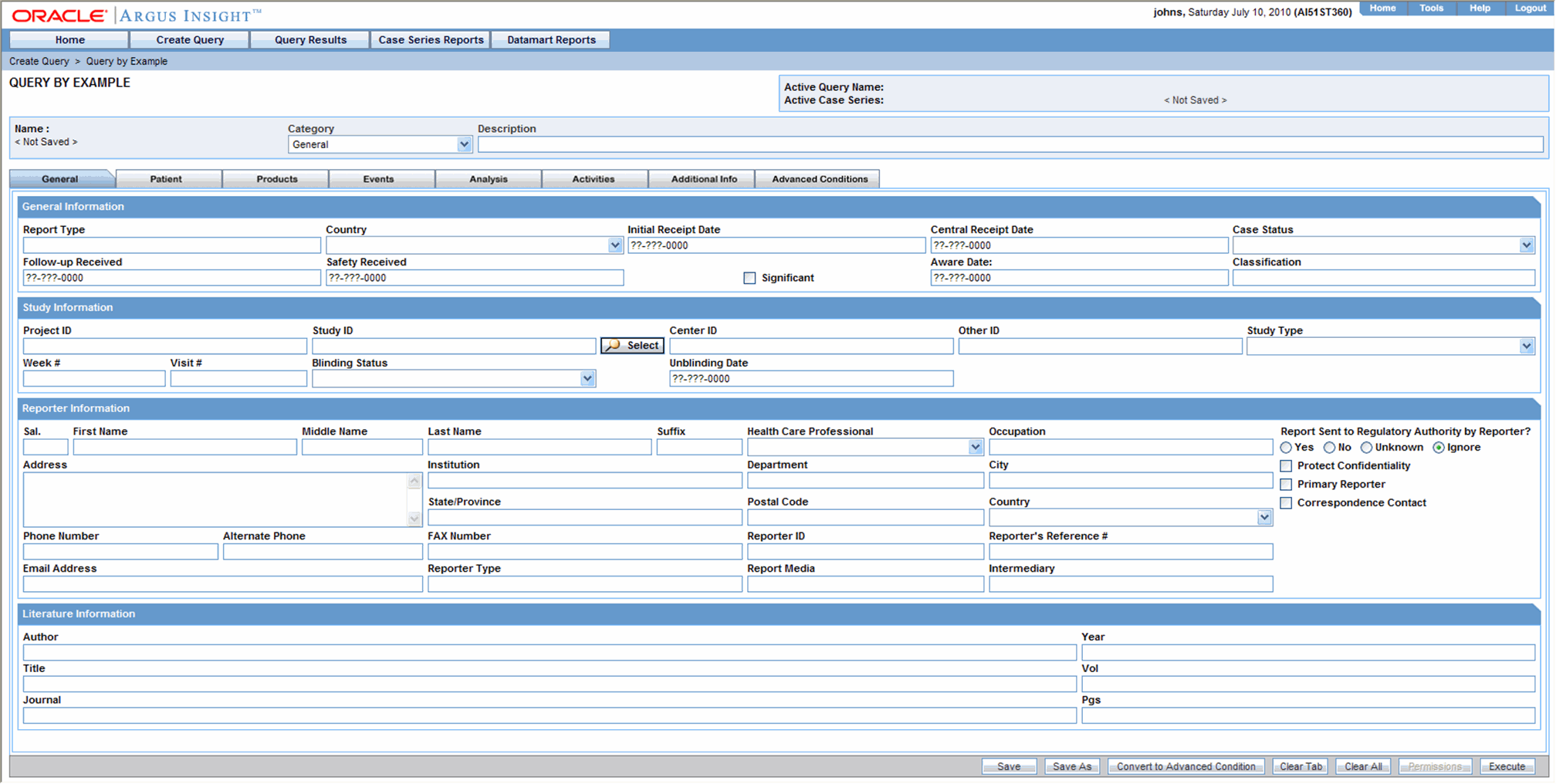
Specify the querying criteria. Enter values in the fields within the various tab pages, as appropriate.
Refer to these pages for descriptions of all the fields in the various tab pages of the QBE form:
|
Note: The QBE field labels are displayed as per the field labels configured in Argus |
General Page
Patient Page
Products Page
Events Page
Analysis Page
Activities Page
Additional Info Page
|
Tip: While entering values in a tab, if you wish to clear all the values you entered, click the Clear Tab button. If you wish to clear all the values you entered in all the tabs, click the Clear All button. |
Examine the QBE result.
Click Execute. While the system searches for matching cases, the following dialog box is displayed.
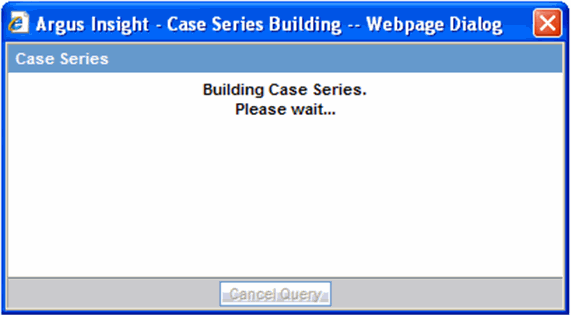
If the system does not find any cases that match the querying criteria, the following screen is displayed. Click Cancel to return to the QBE form, modify the criteria and execute the QBE again.

If the system finds cases that match the query criteria, a list of such cases is displayed in the Active Case Series page.

Examine the Case Series. If the Case Series is too large, you may want to modify the QBE by specifying additional field values in the QBE form to narrow down the Case Series. Alternatively, if you find the Case Series to be appropriate, you can save the QBE to the system.
To return to the QBE form, click View Query in the Active Case Series page. The Active Query by Example page appears.
|
Note: When you save the modifications to a QBE or execute a QBE, the system assigns the Active status to the QBE. Therefore, when you return to the QBE form after executing the QBE, the page title changes to ActiveQuery By Example. The field values you specified in the QBE form before executing are retained. See the Working with the Last Modified or Executed QBE topic for details on Active QBEs. |
If required, modify the QBE and examine the result again or proceed to save the QBE.
Save the QBE to the system.
Use the Category list box to assign a category to the QBE you are going to save. A category indicates the reporting aspect to which your QBE pertains: Compliance, Configuration, General, Management, or Pharmacovigilance. Specifying the category also helps you in searching the relevant QBEs from a list of all the QBEs saved in the system.
Type a description of the QBE in the Description text box. For example, you can describe the type of cases the QBE retrieves.
Click Save As in the ActiveQuery By Example page. The Save QBE dialog box appears.
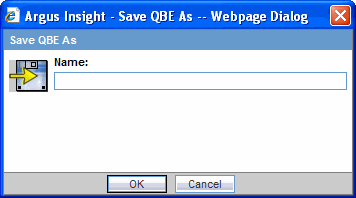
Type the name of the QBE in the Name text box.
|
Note: A name cannot contain any of the following: % " ' ^ ~,;|#` |
Click OK. The system refreshes the Query By Example page. Note that the following new elements appear on the page.
The page title changes to Query By Example.
The Active Query Name field in the upper-right corner of the page now displays the name of the QBE you specified while saving the QBE.
Two new buttons appear at the bottom of the page: Save and Permissions.
|
Note: All the QBEs that you save to the system are listed in the Query By Example - Library page. The Working with Saved QBEs topic explains how to work with saved QBEs. |
|
Tip: If you make modifications to the field values after you have saved the QBE to the system, use the Save button to save the changed field values. |
Use the following procedures to assign group-level permissions to a saved QBE
To assign group-level permissions to a saved QBE:
Click the Permissions button. The Permissions dialog box appears. A list in this dialog box displays the names of all the groups (except the Administrator group) that the system administrator has created.
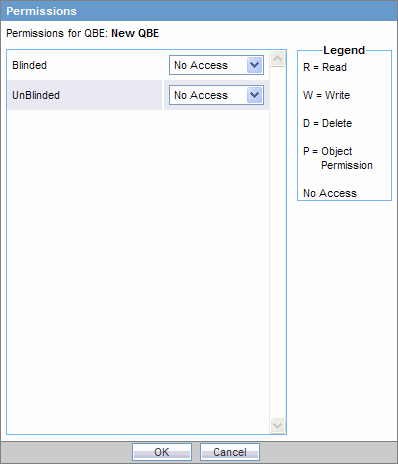
Use the list box next to a group name to assign permissions to the group members on the QBE you have created. You can select from these options:
| Permission | Description |
|---|---|
| No Access (Default) | No group members will be able to access the QBE |
| R | Group members will be able to only view the QBE |
| R/W | Group members will be able to view and modify the QBE |
| R/W/D | Group members will be able to view, modify, and delete the QBE |
| R/W/D/P | Group members will be able to view, modify, delete, and assign permission on the QBE |
Click OK. The system saves the permission settings.
Execute the QBE.
Click Execute. The system retrieves the list of cases that match the QBE criteria and displays it in the Active Case Series page.
After generating the Case Series, you can manually modify it or save it. See the Working with Case Series chapter for more information on working with Case Series.
The General page differs from what you might be used to seeing in Argus in the following ways:
You can specify only one follow-up date
You can specify only one case classification
You can specify information only about one reporter
You need to scroll down the page to view all the fields available.

The following table describes the various fields in the General page. The field values you specify are used as the query criteria to retrieve matching cases.
| Section | Field | Description |
|---|---|---|
| General Information | Report Type | Use this list box to select the case source that the query should look for in cases. |
| Country | Use this list box to select the country of incidence that the query should look for in cases. | |
| Initial Receipt Date | In this date field, enter the date when you company first became aware of the case. | |
| Central Receipt Date | In this date field, enter the date on which the Central Safety received the case. | |
| Case Status | Use this list box to select the workflow state that the query should look for in cases. | |
| Follow-up Received | In this date field, enter the follow-up information receipt date that the query should look for in cases. | |
| Safety Received | In this date field, enter the date on which follow-up information was received by Central Safety. | |
| Significant | Check this checkbox to retrieve cases that had a significant follow up. | |
| Aware Date | In this date field, enter the most recent significant follow-up date or initial receipt date (if there are no follow ups), that the query should look for in cases. | |
| StudyInformation | Study Num | Click the Select button associated with this text box to select the study protocol number, study number and center id that the query should look for in cases.
See theSelecting the Study Numbersection for details. |
| Study Type | Select the study type that the query should look for in cases. | |
| Other Study ID | In this text box, enter any other ID that can be relevant to the study. | |
| Study Week | In this text box, enter the week number of the study during which the adverse event occurred. The query will only look for such cases. | |
| Study Visit | In this text box, enter the visit number of the study during which the adverse event occurred. The query will only look for such cases. | |
| Study Blinding Status | Use this list box to select the study blinding status that the query should look for in cases. | |
| Study Broken Date | In this date field, enter the date on which the study was broken. The query will only look for cases with matching study broken date. | |
| Reporter Information | Reporter Sal. | Enter the reporter salutation that the query should look for in cases. |
| Reporter First Name | Enter the reporter's first name to look for in cases. | |
| Reporter Middle Name | Enter the reporter's middle name to look for in cases. | |
| Reporter Last Name | Enter the reporter's last name to look for in cases. | |
| Reporter Suffix | Enter the reporter's suffix to look for in cases. | |
| Health Care Professional | Select an option from this list box to include a query criterion based on whether the reporter is a health care professional. | |
| Reporter Occupation | Use this list box to select the reporter's occupation that the query should look for in cases. | |
| Reporter Address | In this text area, enter the report address that the query should look for in cases. | |
| Reporter Institution | In this text box, enter the reporter's institution that the query should look for in cases. | |
| Reporter Department | In this text box, enter the reporter's department that the query should look for in cases. | |
| Reporter City | In this text box, enter the reporter's city that the query should look for in cases. | |
| Reporter State | In this text box, enter the reporter's state that the query should look for in cases. | |
| Reporter Postal Code | In this text box, enter the reporter's postal coded that the query should look for in cases. | |
| Reporter Country ID | In this text box, enter the reporter's country ID that the query should look for in cases. | |
| Reporter Phone Number | In this text box, enter the reporter's phone number that the query should look for in cases. | |
| Reporter Alternate Phone | In this text box, enter the reporter's alternate phone number that the query should look for in cases. | |
| Reporter Fax Number | In this text box, enter the reporter's fax number that the query should look for in cases. | |
| Reporter ID | In this text box, enter the reporter ID that the query should look for in cases. | |
| Reporter's Reference # | In this text box, enter the reporter's reference number that the query should look for in cases. | |
| Reporter Email Address | In this text box, enter the reporter's email address that the query should look for in cases. | |
| Reporter Type | Use this list box to select the reporter type that the query should look for in cases. | |
| Report Media | Use this list box to select the report media that the query should look for in cases. | |
| Intermediary | Use this list box to select the intermediary that the query should look for in cases. | |
| Report Sent to Regulatory Authority by Reporter | Select the Yes, No, Unknown, or Ignore option button, as appropriate, to indicate whether the query should look for cases where the reporter has already informed a regulatory authority about the event. | |
| Reporter Protect Confidentiality | Check this checkbox to have the query retrieve only those cases where reporter information is specified as confidential. | |
| Primary Reporter | Check this checkbox to have the query retrieve only those cases where the reporter is marked as the primary reporter. | |
| Reporter Correspondence Contact | Check this checkbox to have the query retrieve only those cases where the reporter is marked as a correspondence contact. | |
| Literature Information | Literature Journal | In this text box, enter the literature journal name that the query should look for in cases. |
| Literature Author | In this text box, enter the literature author name that the query should look for in cases. | |
| Literature Title | In this text box, enter the literature title that the query should look for in cases. | |
| Literature Vol | In this text box, enter the literature volume that the query should look for in cases. | |
| Literature Year | In this text box, enter the literature publication year that the query should look for in cases. | |
| Literature Pgs | In this text box, enter the journal page number in which the article appeared. The query will look for this information in cases. |
Argus Insight lets you select the Study Protocol #, Study Num and Center ID fields in the Study Information section, by selecting the study number from the Clinical Study Lookup dialog box.
Use the following procedure to select a clinical study:
To select a clinical study:
Click the Select button associated with the Study Num field. The Clinical Study Lookup dialog box appears.
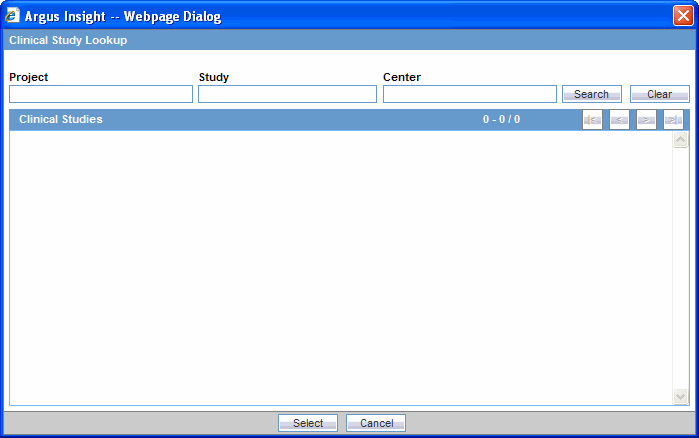
Enter the first few letters of the project name, study ID, or study center name in their respective text boxes.
|
Tip: If you are not sure about the information you are looking for, as an alternative, click search to list all the associated data for Study Num. |
Click Search. The system searches for the specified search strings. The Clinical Study Lookup dialog box displays the search result in a grid format.

Select a study from the Clinical Studies listed.
Click Select in the Clinical Study Lookup dialog box. The Study Protocol # , Study Num (*) and Center ID(*) fields in the Study Information section of the QBE form are automatically selected.
|
Note: The Study Num and Center ID are optional fields. |
The Patient page has two views: Patient and Parent.
The Patient view differs from what you might be used to seeing in Argus in the following ways:
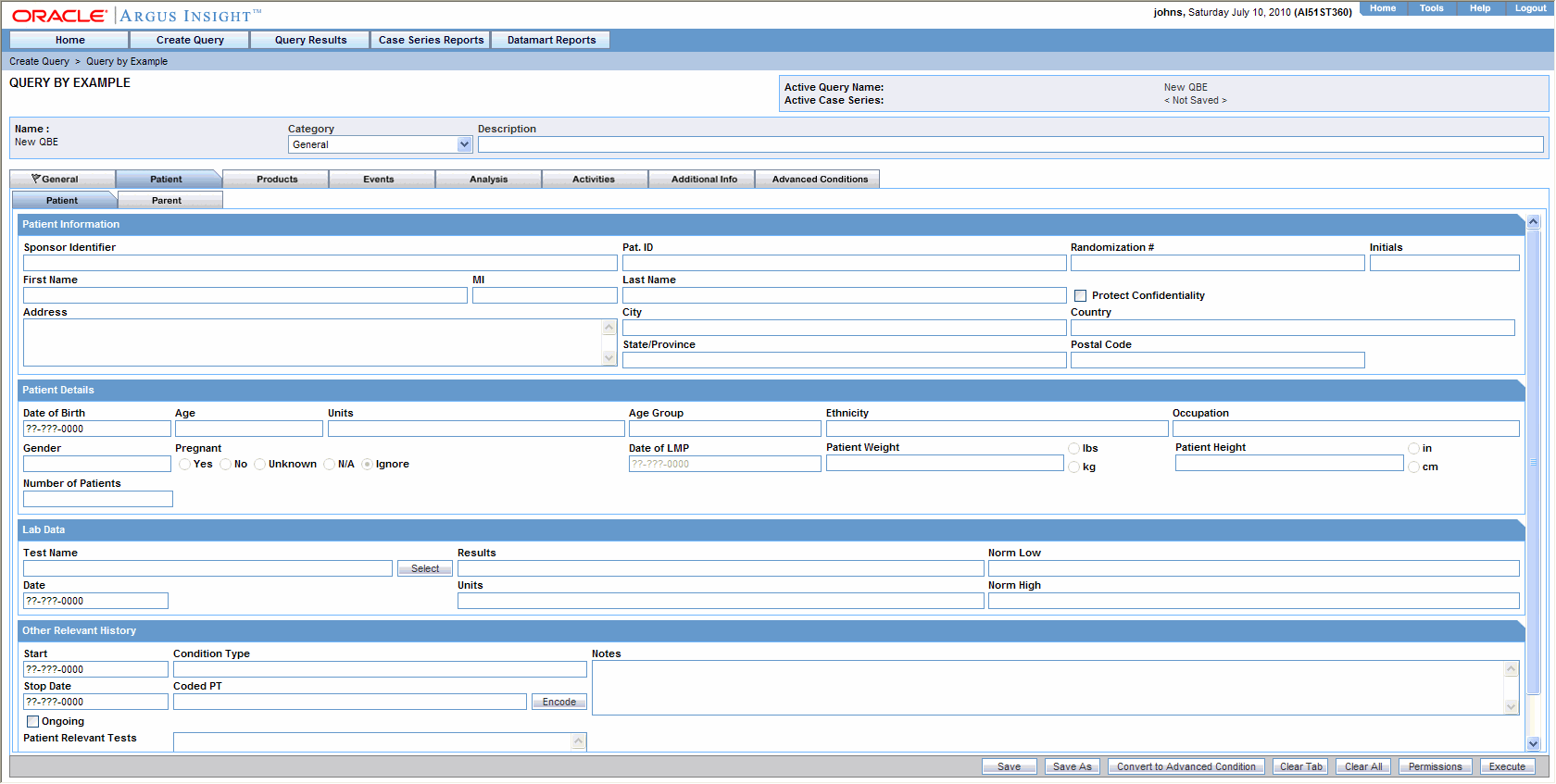
You can specify information only about one lab data element
You can specify details of only one relevant history
You need to scroll down the page to view all the fields available.
The following table describes the various fields in the Patient view of the Patient page. The field values you specify are used as the query criteria to retrieve matching cases.
| Section | Field | Description |
|---|---|---|
| Patient Information | Patient Sponsor Identifier | In this text box, enter the study sponsor's ID. The query will look for this information in cases. |
| Patient Subject # | In this text box, enter the patient subject number that the query should look for in cases. | |
| Patient First Name | In this text box, enter the patient's first name that the query should look for in cases. | |
| Patient Last Name | In this text box, enter the patient's last name that the query should look for in cases. | |
| Patient MI | In this text box, enter the patient's middle initials that the query should look for in cases. | |
| Patient Initials | In this text box, enter the patient's initials that the query should look for in cases. | |
| Patient Randomization Number | In this text box, enter the patient randomization number that the query should look for in cases. | |
| Patient Protect Confidentiality | Check this checkbox to retrieve those cases where patient information is marked as confidential. | |
| Number of Patients | In this text box, enter the number of patients. | |
| Patient Address | In this text box, enter the patient's address that the query should look for in cases. | |
| Patient City | In this text box, enter the patient's city that the query should look for in cases. | |
| Patient State | In this text box, enter the patient's state that the query should look for in cases. | |
| Patient Postal Code | In this text box, enter the patient's postal code that the query should look for in cases. | |
| Patient Country | In this text box, enter the patient's country that the query should look for in cases. | |
| Patient Date of Birth | In this date field, enter the patient's date of birth that the query should look for in cases. | |
| Patient Age | In this text box, enter the patient's age that the query should look for in cases. | |
| Patient Age Units | Select the age unit for the value you specified in the Patient Age text box. | |
| Patient Age Group | Select the patient age group that the query should look for in cases. | |
| Patient Gender | Select the patient gender that the query should look for in cases. | |
| Patient Weight | In this text box, enter the patient weight that the query should look for in cases. Select the lbs or kg option button, as appropriate. | |
| Patient Height | In this text box, enter the patient's height that the query should look for in cases. Select the in or cm option button, as appropriate. | |
| Patient Ethnicity | Select the patient's ethnicity that the query should look for in cases. | |
| Patient Occupation | Select the patient occupation that the query should look for in cases. | |
| Pregnancy | Select the Yes, No, Unknown, N/A, or Ignore option button, as appropriate, to indicate whether the query should look for cases where the patient's pregnancy status is specified. This field is available only if you specify the patient gender as Female | |
| Pregnancy Information Date of Last Menstrual Per. | In this date field, enter the date of last menstrual period that the query should look for in cases. | |
| Lab Data | Lab Data Test Name | Click the associated Select button to select the lab test that the query should look for in cases. See theSelecting Lab Testsection for more information. |
| Lab Data Result | In this text box, enter the lab data result that the query should look for in cases. | |
| Lab Data Normal Low | In this text box, enter the lab data normal low value that the query should look for in cases. | |
| Lab Test Date | In this date field, enter the lab test date that the query should look for in cases. | |
| Lab Data Result Unit | Enter the lab data result unit for the value you specified in the Lab Data Result field. | |
| Lab Data Normal High | In this text box, enter the lab data normal high value that the query should look for in cases. | |
| Other Relevant Information | Relevant History Start Date | In this date field, enter the relevant history start date that the query should look for in cases. |
| Relevant History Condition Type | Select the relevant history condition type that the query should look for in cases. | |
| Relevant History Notes | In this text box, enter the relevant history notes that the query should look for in cases. | |
| Relevant History Stop Date | In this date field, enter the relevant history stop date that the query should look for in cases. | |
| Relevant History Condition | Click the associated Encode button to select the relevant history condition by using the MedDRA browser. The query will look for the encoded term.
See theUsing the MedDRA Browser section for details. |
|
| Relevant History Continues | Check this checkbox to retrieve cases where the relevant history condition is continuing/ongoing. | |
| Patient Relevant Tests | In this text area, enter the relevant patient tests that the query should look for in cases. |
This Parent view differs from what you might be used to seeing in Argus in the following ways:
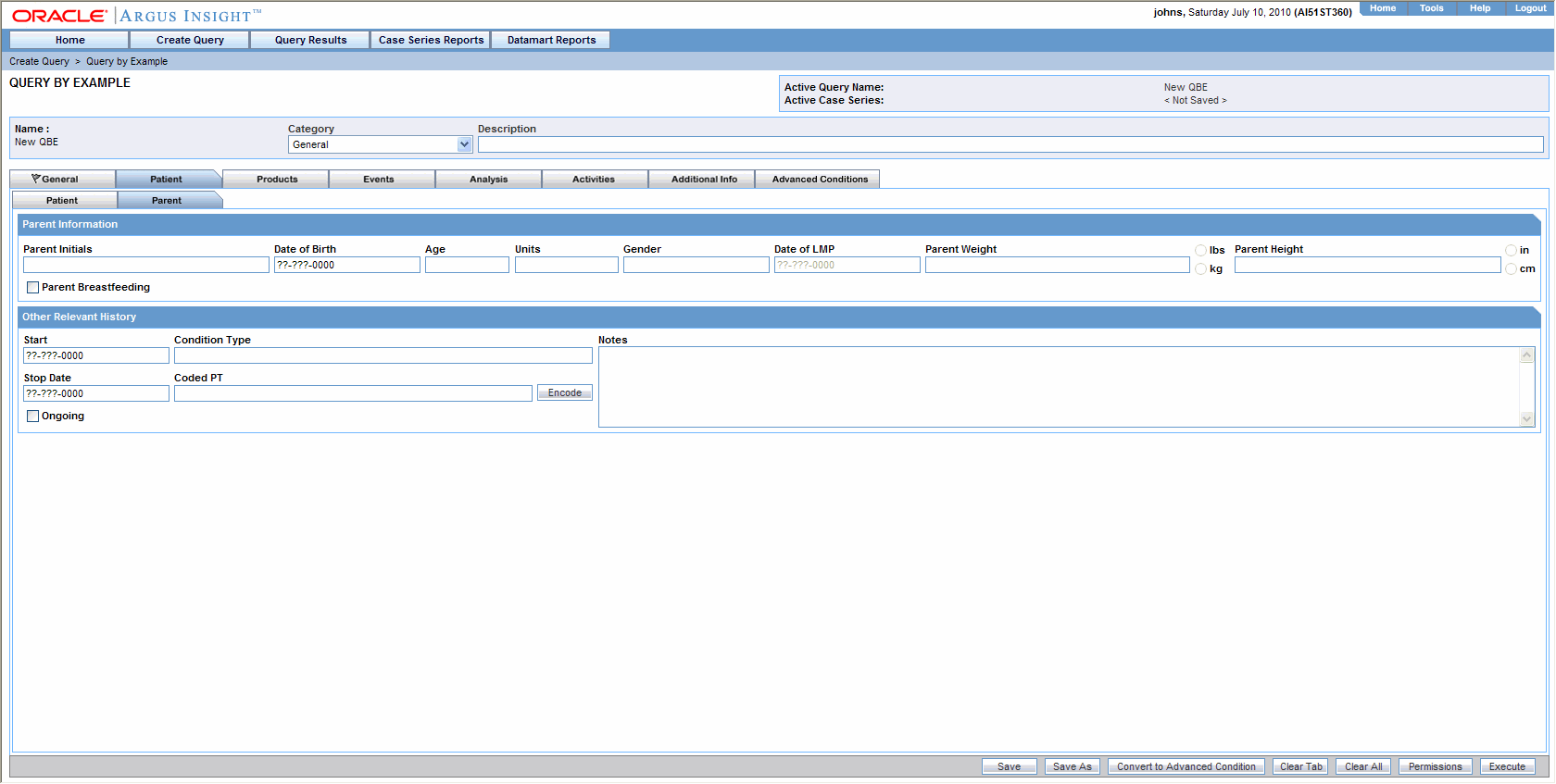
You can specify details of only one relevant history
You can specify details of only one medical history
The following tables describes the various fields in the Patient view of the Patient page. The system uses the field values you specify the query criteria to retrieve matching cases.
| Section | Field | Description |
|---|---|---|
| Parent | Parent Initials | In this text box, enter the parent's initials that the query should look for in cases. |
| Parent Age | In this text box, enter the parent's age that the query should look for in cases. | |
| Parent Age Unit | Select the age unit for the value you specified in the Parent Age text box. | |
| Parent Gender | Select the parent gender that the query should look for in cases. | |
| Parent LMP | In this date field, enter the parent's LMP date that the query should look for in cases. This field is available only if the parent gender is specified as Female. | |
| Parent Weight | In this text box, enter the parent's weight that the query should look for in cases. Select the lbs or kg option button, as appropriate. | |
| Parent Height | In this text box, enter the parent's height that the query should look for in cases. Select the in or cm option button, as appropriate. | |
| Parent Breast feeding | Check this checkbox to retrieve cases where parent is breast feeding. | |
| Other Relevant Information | Relevant History Start Date | In this date field, enter the relevant history start date that the query should look for in cases. |
| Relevant History Condition Type | Select the relevant history condition type that the query should look for in cases. | |
| Relevant History Notes | In this text box, enter the relevant history notes that the query should look for in cases. | |
| Relevant History Stop Date | In this date field, enter the relevant history stop date that the query should look for in cases. | |
| Relevant History Condition | Click the associated Encode button to select the relevant history condition by using the MedDRA browser. The query will look for the encoded term.
See theUsing the MedDRA Browsersection for details. |
|
| Relevant History Continues | Check this checkbox to retrieve cases where the relevant history condition is continuing / ongoing. |
Use the following procedure to select a Lab Test:
Click the Select button associated with the Lab Data Test Name field. The Lab Test Name dialog box appears.
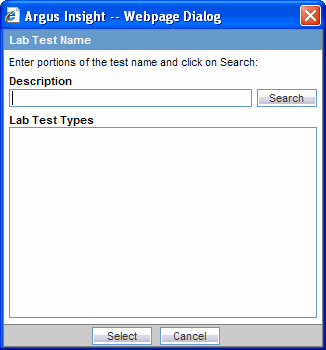
Type a few initial letters of the test name.
Click Search. The matching test names appear in a list.
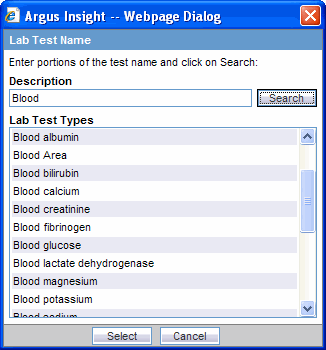
Select the required test name.
Click Select. The test name appears in the Lab Data Test Name field in the QBE form.
Use the following procedure to use the MedDRA Browser to search and select MedDRA terms for an event.
Click the Encode button associated with the QBE tabs to launch MedDRA browser. The MedDRA Browser appears.

|
Note: The output returned by the MedDRA browser for the Patient, Product and Analysis tabs of QBE is the Preferred Term (PT). The Events tab of QBE provides output for multiple options. You can select and search the required term(s), based on the Seriousness Criteria. |
Enter the first few letters of the SOC, HLGT, HLT, PT, or LLT term in the respective text box. If you want the system to search for the specified word in the entire event term, check the Full Search checkbox.
|
Note: The Special Category drop-down list displays all the SMQs that can be selected. The selected SMQ searches across PT and LLT levels of the MedDRA dictionary.The Special Category drop-down list is hidden in MedDRA 10. The MedDRA SMQs drop-down list is hidden in versions lesser than MedDRA 9. |
Press Tab. The system searches for the specified word in the event terms. The MedDRA Browser displays the search result in a column below the text box in which you entered the text string.
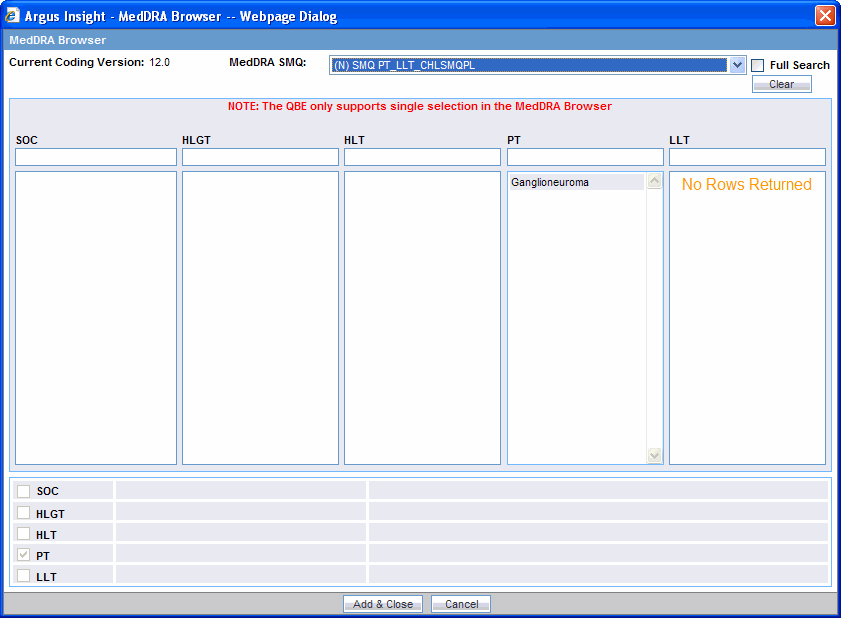
Select the required event term from the search result. The SOC, HLGT, HLT, PT, and LLT fields in the MedDRA Browser display the respective terms for the selected event. The fields that are highlighted in the colors listed below have the following significance.

| If the row color is... | This signifies... |
| Yellow | The selected hierarchy is the primary SOC path. |
| Grey | The selected hierarchy is not the primary SOC path. |
Check the SOC, HLGT, HLT, PT, and LLT checkboxes to populate the corresponding fields in the QBE form.
Click Select.
The selected codes for the selected event are displayed in the respective fields in the QBE form.
The Products page differs from what you might be used to seeing in Argus in the following ways:
You can enter information only about one product
You can specify details of only one dosage regimen
You need to scroll down the page to view all the fields available.
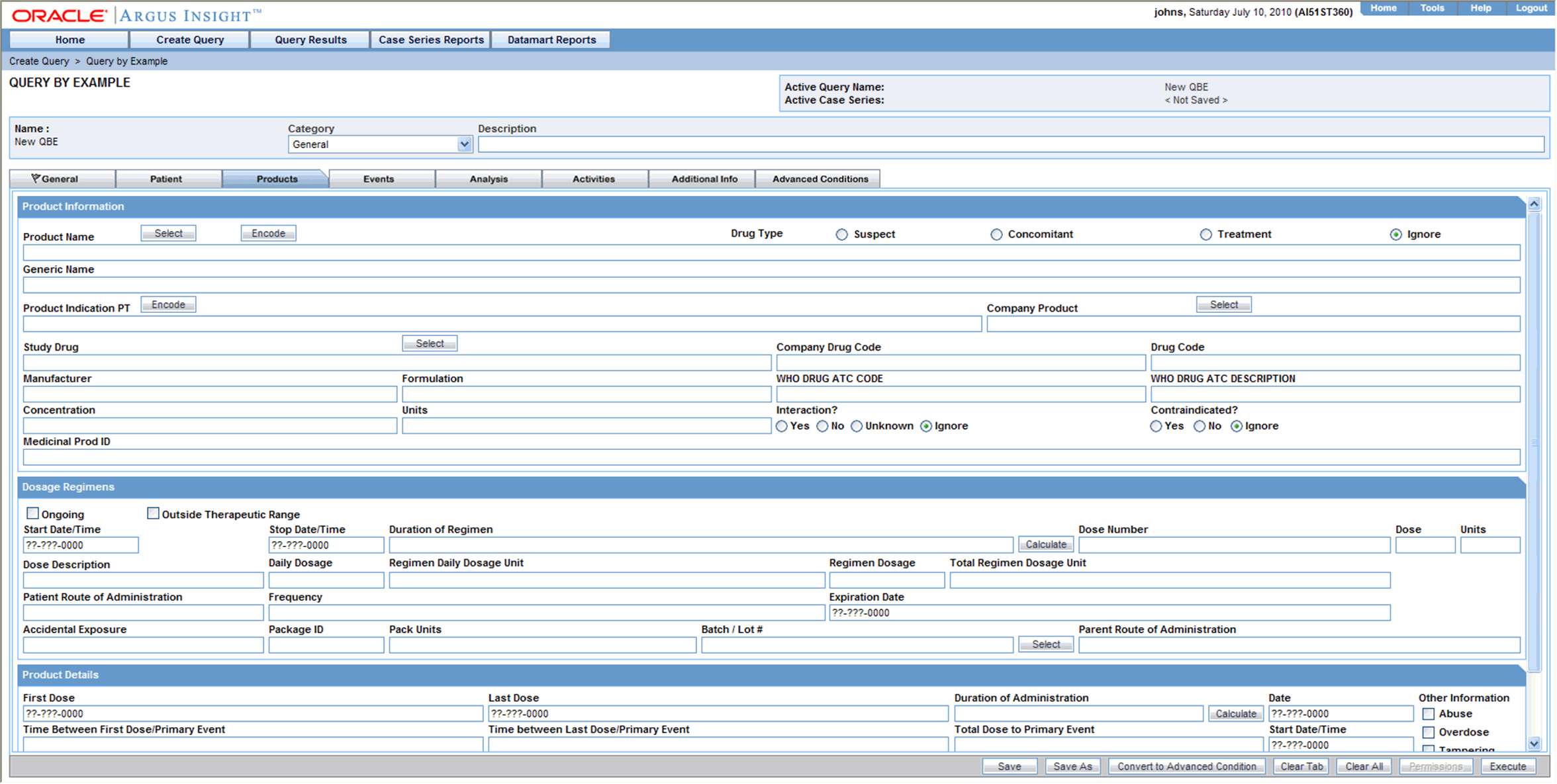
The following table describes the various fields in the Products page. The field values you specify are used as the query criteria to retrieve matching cases.
| Section | Field | Description |
|---|---|---|
| Product Information | Product Name | Click the associated Select button to use the Product Browser to specify the product as the query criteria.
Selecting the product name automatically populates the Product Name, Product Generic Name, and Company Drug Code fields in the QBE form. See theUsing the Product Browsersection for details. |
| Product WHO Drug Code | Click the associated Encode button to use the Drug Coding Browser to specify the WHO drug name as the query criteria.
See theUsing the WHO Drug Browsersection for details. |
|
| Product Type | Select the Suspect, Concomitant, Treatment, or Ignore option button, as appropriate, to indicate whether the query should look for cases where product type is specified. | |
| Product Manufacturer | Select the product manufacturer that the query should look for in cases. | |
| StudyDrug | Click the associated Select button to use the Study Drug Lookup dialog box to specify the study drug name as the query criteria. Use this field to retrieve clinical trial cases with the selected study drug.
See theUsing the Study Drug Lookupsection for details. |
|
| ATC Code | Enter the Anatomical, Therapeutic, Chemical (ATC) classification code that the query should look for in cases. | |
| ATC Description | Enter the Anatomical, Therapeutic, Chemical (ATC) classification description. | |
| Drug Formulation | Select the drug formulation that the query should look for in cases. | |
| Drug Concentration | Enter the drug formulation that the query should look for in cases. Select the concentration unit from the Drug Product Concentration Units ID list box. | |
| Drug Primary Indication | Click the associated Encode button to use the MedDRA Browser to specify the drug primary indication event term as the query criteria.
See theUsing the MedDRA Browsersection for details. |
|
| Drug Interaction | Select the Yes, No, Unk, or Ignore option button, as appropriate, to indicate whether the query should look for cases where drug interaction status is specified. | |
| Drug Contraindicated | Select the Yes, No, or Ignore option button, as appropriate, to indicate whether the query should look for cases where drug contraindication status is specified. | |
| Dosage Information | Dosage Regimen Start Date | In this date field, enter the dosage regimen start date that the query should look for in cases. |
| Dosage Regimen Stop Date | In this date field, enter the dosage regimen start date that the query should look for in cases. | |
| Dosage Regimen Ongoing | Check this checkbox to retrieve cases where the dosage regimen is ongoing. | |
| Dosage Regimen Outside Therapeutic Range | Check this checkbox to retrieve cases where the dosage regimen is outside therapeutic range.
This means that the drug has not been used in accordance with the label or has been used for outside the Therapeutic Range. Consult your Administrator for further company-specific information on the use of this field. |
|
| Dosage Regimen Duration | In this text box, enter the dosage regimen duration in minutes as the query criteria.
OR Click Calculate to view the duration calculator, to calculate the dosage regimen duration in minutes or duration value bands.
|
|
|
||
| Dosage Regimen Accidental Exposure | Select the area of accidental exposure as the query criteria. | |
| Dosage Regimen Dose No. | In this text box, enter the drug dose number as the query criteria. | |
| Dose | In this text box, enter the drug dose received by the patient as the query criteria. | |
| Dose Units | Use this list box to specify the units for the value you specified in the Dose field. | |
| Frequency | Use this list box to specify the dosage frequency as the query criteria. | |
| Dosage Regimen Dose Description | In this text box, enter the dose description based on the values you specified in Dose, Dose Units, and Frequency fields. | |
| Regimen Daily Dose | In this text box, enter the daily dose based on the values you specified in Dose and Frequency fields. | |
| Regimen Daily Dosage Unit | Select the same option you selected in the Dose Units list box. | |
| Total Regimen Dosage | daily dose, duration, and frequency | |
| Total Dosage Regimen Unit | Select the total dose regimen unit based on the values you specified in Dose, Dosage Regimen Duration, and Frequency fields. | |
| Dosage Regimen Route of Administration | Select the route of dosage administration as the query criteria. | |
| Dosage Regimen Route (Parent) | Select the route of dosage administration of the parent as the query criteria. | |
| Dosage Regimen Package ID | Enter the package ID as the query criteria. | |
| Dosage Regimen Package Units | Select the package units. | |
| Dosage Regimen Batch/Lot # | Enter the batch/lot number as the query criteria. | |
| Expiration Date | Enter the product expiration date as the query criteria. | |
| Drug First Dose | Enter the earliest dosage regimen start date as the query criteria. | |
| Drug Last Dose | Enter the latest regimen stop date as the query criteria. | |
| Drug Duration of Administration | Enter the duration of drug administration as the query criteria.
This duration is the difference between the first and last dose for all dosage regimens. |
|
| Total Drug Dosage | Enter the total drug usage duration as the query criteria. | |
| Drug Product Total Dose Unit | Enter the total dosage unit as the query criteria.
This is based on the daily dose, duration and frequency. |
|
| Product Event Delay | Enter the time between the event onset and the fist dose | |
| Product Event Latency | Enter the time between the event onset and the last dose | |
| Drug Cumulative Dose | Enter the total dose for the drug | |
| Drug Info Action Taken | Select the action taken to mitigate the adverse event | |
| Other Information | Check the Drug Abuse, Drug Overdose, and Tampering checkboxes | |
| Drug Taken Previously | Select the Yes, No, Unk, or Ignore option button, as appropriate, to indicate whether the query should look for cases where drug was taken previously. | |
| Drug Dechallenge | Select the Yes, No, Unk, N/A or Ignore option button, as appropriate, to indicate whether the query should look for cases where drug dechallenge status is specified. | |
| Drug Dechallenge Date | Enter the drug dechallenge date as the query criteria. | |
| Drug Rechallenge | Select the Yes, No, Unknown, N/A or Ignore option button, as appropriate, to indicate whether the query should look for cases where drug rechallenge status is specified. | |
| Drug Rechallenge Start Date | Enter the rechallenge start date as the query criteria. | |
| Drug Rechallenge Stop Date | Enter the rechallenge stop date as the query criteria. |
Use the following procedure to explain how to select a product by using the Product Browser.
Click the Select button associated with the Product Name field. The Product Browser appears.
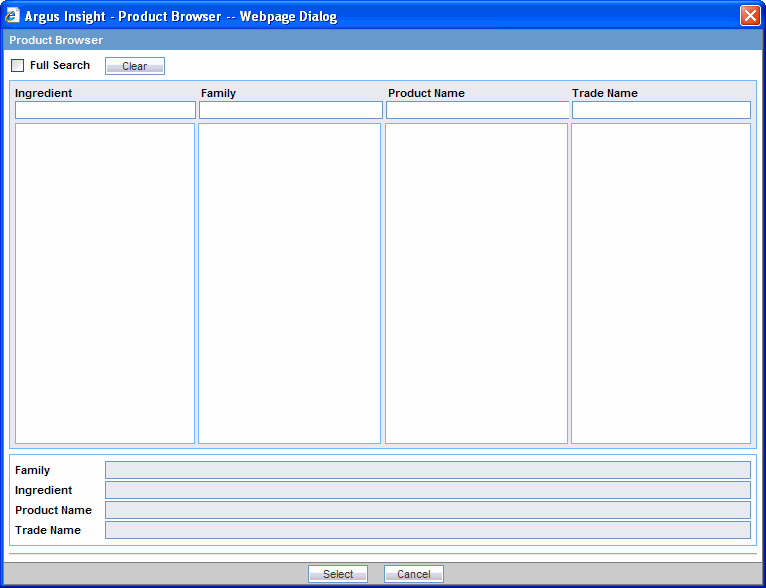
Enter the first few letters of the product ingredient, family name, product name, or trade name in the respective text box. If you want the system to search for the specified string in the entire product information, check the Full Search checkbox.
Press Tab. The system searches the database for the specified search string. The Product Browser displays the search result in a column below the text box in which you entered the search string.

Select an item from the search result list. The details for the selected item are displayed in all the Product Browser fields.

Select the required product name and trade name, as appropriate. The selection is highlighted in the Product Browser.

Click Select. The Product Name, Product Generic Name, Company Drug Code, Drug Formulation, Drug Concentration and Drug Product Concentration Units ID fields in the QBE form are automatically populated with the details of the selected product.
Use the following procedure to select a WHO drug product by using the WHO Drug Browser.
Click the Encode button associated with the Product Name field. The WHO Drug Browser appears.
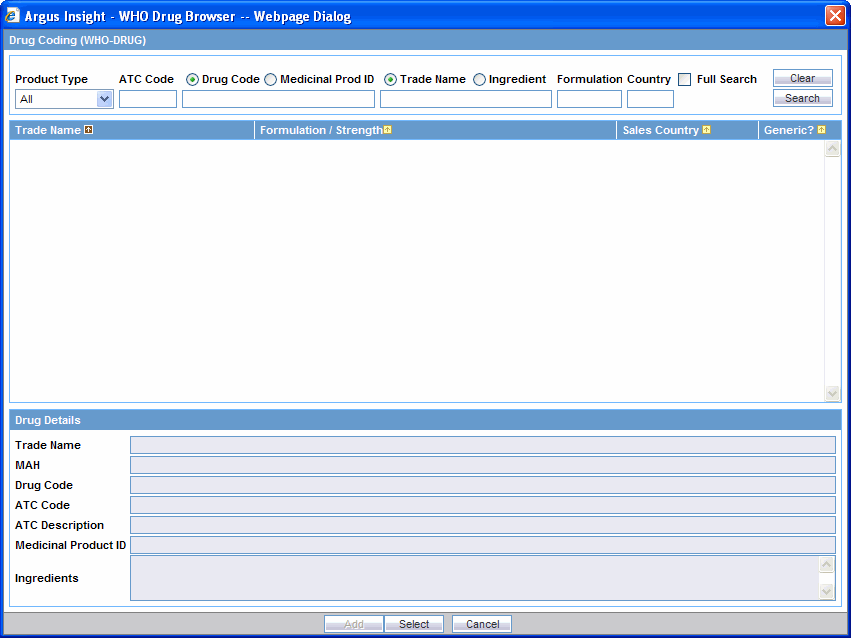
|
Note: The WHO Drug Browser that appears will depend on the configuration settings for your account by the administrator.The browser categories (B or C) are not displayed in the browser window. The primary difference between the two browsers is the availability of the following fields in WHO Drug Browser:
|
Select the Product Type as the drug search criteria. The default value is All.
Enter the first few letters of the ATC code, ATC description, Code, or Description in the respective text box. Check the Ingredient checkbox to search for the drugs (whose drug ingredients) match the ingredients in the List Maintenance. Click the SOUNDEX checkbox to search for drugs, where the exact spelling of the drug is unknown. Example: Enter antiviral in the ATC description field to view the list of drugs starting with the phonetics closest to anti. This returns a list of drugs closest to the phonetic representation (the way it sounds) of the word.
Select either the Drug Code or Medicinal Prod ID radio button as one of the drug search criterion. The default selection is Drug Code.
Select either the Trade Name or Ingredient radio button as one of the drug search criterion. The default selection is Trade Name. You can also select multiple trade names in the same WHO Drug selection dialog. If multiple trade names are to be added, the Add & Close button is enabled. Click this button to add the selected multiple trade names and ingredients into the Drug Detail section.
Enter the Formulation and Country details for the drug to be searched.
If you want the system to search for the specified string in the entire product information, check the Full Search checkbox.
Click Search. The system searches the database for the specified search string. The WHO Drug Browser displays the search result in a grid format.
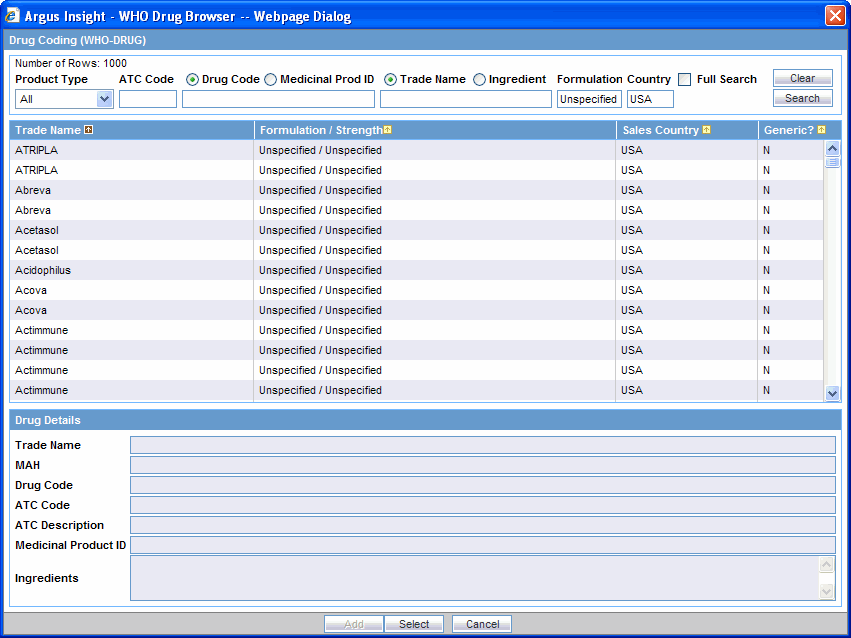
Select the required WHO drug. The selected item is highlighted.
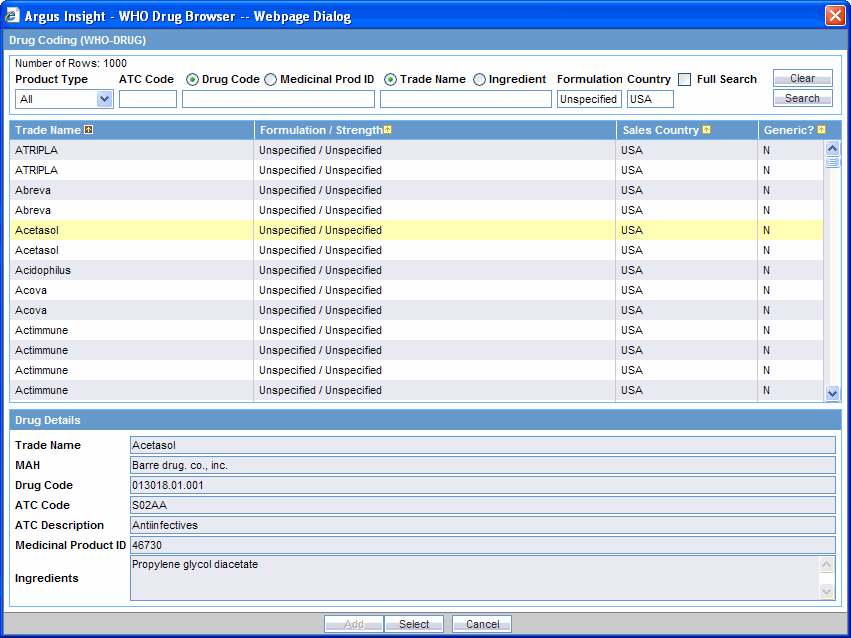
Click Select. The Product Name, Product WHO Drug Code, Generic Name, ATC Code and ATC Text fields in the QBE form are populated with the selected WHO drug code.
|
Note: All the Ingredients for the WHO Drug browser are concatenated and displayed in the Generic Name for the WHO Drug separated by a "," |
Use the following procedure to select a study drug:
Click the Select button associated with the Study Drug field. The Study Drug dialog box appears.

Enter the first few letters of the study drug name in the Study Drug dialog box.
Click Search. The system searches the database for the specified search string. The Study Drug dialog box displays the search result in a grid format.
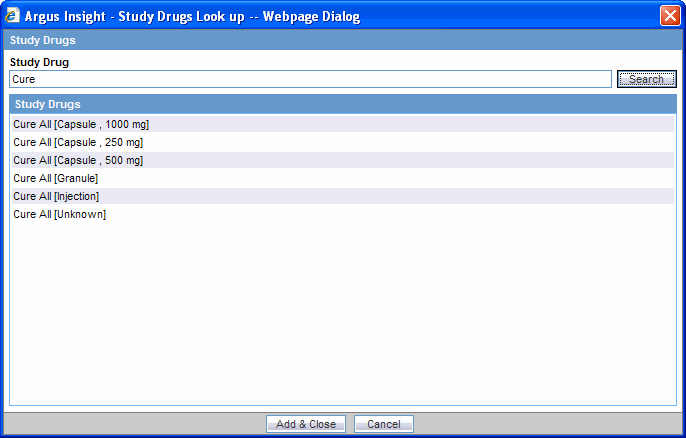
Select the required study drug from the search result list.
Click Add & Close. The system populates the Study Drug field with the selected study drug.
The Events page differs from what you might be used to seeing in Argus in that details of only one event can be specified. You must scroll down the page to view all the available fields.

The following table describes the various fields in the Events page. The field values you specify are used as the query criteria to retrieve matching cases.
| Section | Field | Description |
|---|---|---|
| Event Information | Event Description as Reported | In this text box, enter the reported event description that the query should look for in cases. |
| Event Diagnosis Flag | Select the Yes, No, or Ignore option button, as appropriate, to indicate whether the query should look for cases where event diagnosis flag is set. | |
| Event Description to be Coded | Tab out from this field to use the MedDRA Browser to specify an event term as query criteria.
See theUsing the MedDRA Browsersection for details. The MedDRA event terms for the selected term are displayed in the Seriousness Criteria section. The query is restricted to the terms displayed. |
|
| Event Past History | Select the Yes, No, Unknown, or Ignore option button, as appropriate, to indicate whether the query should look for cases where event past history is specified. | |
| Event Onset Date | In this date field, enter the event onset date that the query should look for in cases. | |
| Event Onset from Last Dose | In this text box, enter the event onset duration from last dose as the query criteria. | |
| Event Stop Date | In this date field, enter the event stop date that the query should look for in cases. | |
| Event Duration | In this text box, enter the event duration that the query should look for in cases. | |
| Event Onset Latency | In this text box, enter the event onset latency duration that the query should look for in cases. | |
| Time to Onset from First Dose | In this text box, enter the duration from first dose to the event onset as the query criteria.
OR Click the associated Calculate button to view theDuration Calculatoras displayed in the Products Tab Dosage Information. |
|
| Time to Onset from Last Dose | In this text box, enter the duration from last dose to the event onset as the query criteria.
OR Click the associated Calculate button to view theDuration Calculatoras displayed in the Products Tab Dosage Information. |
|
| Event Intensity | Select the event intensity option that the query should look for in cases. | |
| Event Frequency | Select the event frequency option that the query should look for in cases. | |
| Related to Study Conduct (As Reported) | Use this list box to select the Yes, No, Unknown, or N/A option, as appropriate, to indicate whether the query should look for cases where the event is related to a study. | |
| Event Treatment Received | Select the Yes, No, Unknown, or Ignore option button, as appropriate, to indicate whether the query should look for cases where patient received treatment for the event. | |
| Outcome of Event | Select the event outcome that the query should look for in cases. | |
| Event Receipt Date | In this date field, enter the event receipt date that the query should look for in cases. | |
| Event Reported Serious | Select the Yes, No, or Ignore option button, as appropriate, to indicate whether the query should look for cases where case seriousness status is specified. | |
| Event Lack of Efficacy | Check this checkbox to retrieve cases where Event Lack of Efficacy is selected. | |
| Event Progression of Disease | Check this checkbox to retrieve cases where Event Progression of Disease is selected. | |
| Event Withdrawal Reaction | Check this checkbox to retrieve cases where Event Withdrawal Reaction is selected. | |
| Seriousness Criteria | Seriousness Criteria checkboxes | Check one or more associated checkboxes to specify the seriousness criteria that the query should look for in cases. |
| Event Term fields | Click the associated Encode button to use the MedDRA Browser to specify event terms as query criteria.
See theUsing the MedDRA Browsersection for details. |
The Analysis page has two views: Case Analysis and AFSSaPS. Analysis information about Regulatory Information (notification log), MedWatch Information, BfArM Information, and EU devices is not available. For more sophisticated queries, use Filters or Advanced Conditions.

The following table describes all the fields in the Case Analysis view. The field values you specify are used as the query criteria to retrieve matching cases.
| Section | Field | Description |
|---|---|---|
| Narrative | Narrative | In this text box, enter the case narrative that the query should look for in cases. |
| Case Comment | In this text box, enter the case comment that the query should look for in cases. | |
| Local Evaluator Comment | In this text box, enter the local evaluator' comment that the query should look for in cases. | |
| Abbreviated Narrative | In this text box, enter the abbreviated case narrative that the query should look for in cases. | |
| Company Comment | In this text box, enter the company's comment that the query should look for in cases. | |
| Evaluation in Light of Similar Events | In this text box, enter the evaluation comment that takes in to consideration similar events that have occurred in the past. The query will look for the specified text in cases. | |
| Other Information | Case Seriousness | Select the Yes, No, or Ignore option button, as appropriate, to indicate whether the query should look for cases where case seriousness status is specified. |
| Case Seriousness Notes | In this text box, enter the case seriousness notes that the query should look for in cases. | |
| Company Agent Causality | Select the Yes, No, Unknown, or Ignore option button, as appropriate, to indicate whether the query should look for cases where the company agent causality status is specified. | |
| Company Agent Causality Notes | In this text box, enter the company agent causality notes that the query should look for in cases. | |
| Case Listedness | Select the case listedness status that the query should look for in cases. | |
| Case Assessment Listedness Notes | In this text box, enter the case assessment listedness notes that the query should look for in cases. | |
| Case Outcome | Select the case outcome that the query should look for in cases. | |
| Company Diagnosis/Syndrome | Click the associated Encode button to use the MedDRA Browser to specify the company diagnosis as query criteria. See theUsing the MedDRA Browsersection for details. | |
| Company Diagnosis/Syndrome Notes | In this text box, enter the company diagnosis notes that the query should look for in cases. |
The following table describes all the fields in the AFSSaPS page. The field values you specify are used as the query criteria to retrieve matching cases.
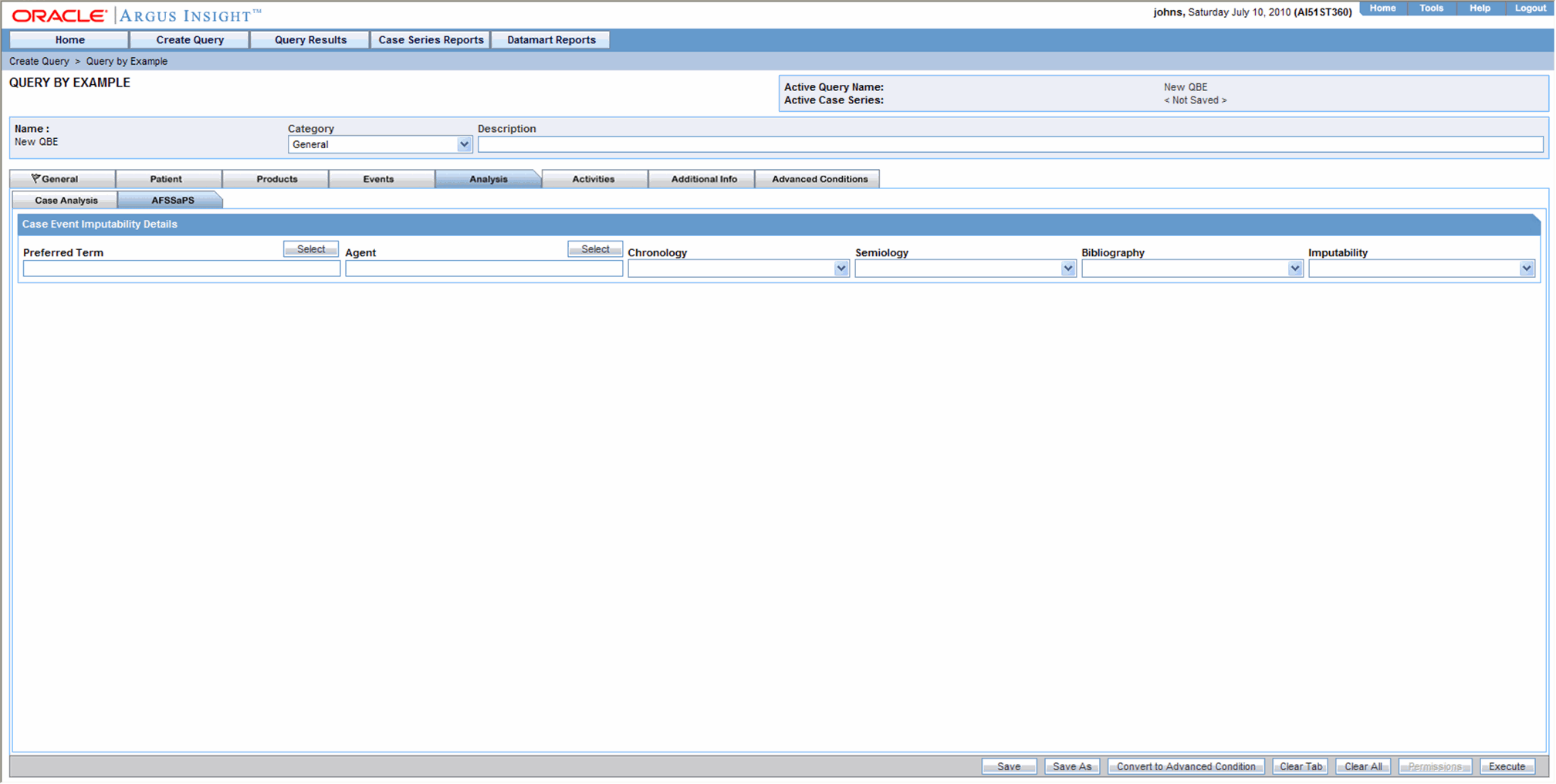
| Section | Field | Description |
| Case Event Imputability Details | Preferred Term | Click the associated Select button to use the MedDRA Browser to specify the Event Preferred Term as query criteria.
See theUsing the MedDRA Browsersection for details. |
| Agent | Select the suspect product that the query should look for in cases. | |
| Chronology | Select the imputability chronology code that the query should look for in cases. | |
| Semiology | Select the imputability semiology code that the query should look for in cases. | |
| Bibliography | Select the imputability bibliography code that the query should look for in cases. | |
| Imputability | Select the imputability score that the query should look for in cases. |
The Activities page differs from what you might be used to seeing in Argus in the following ways:
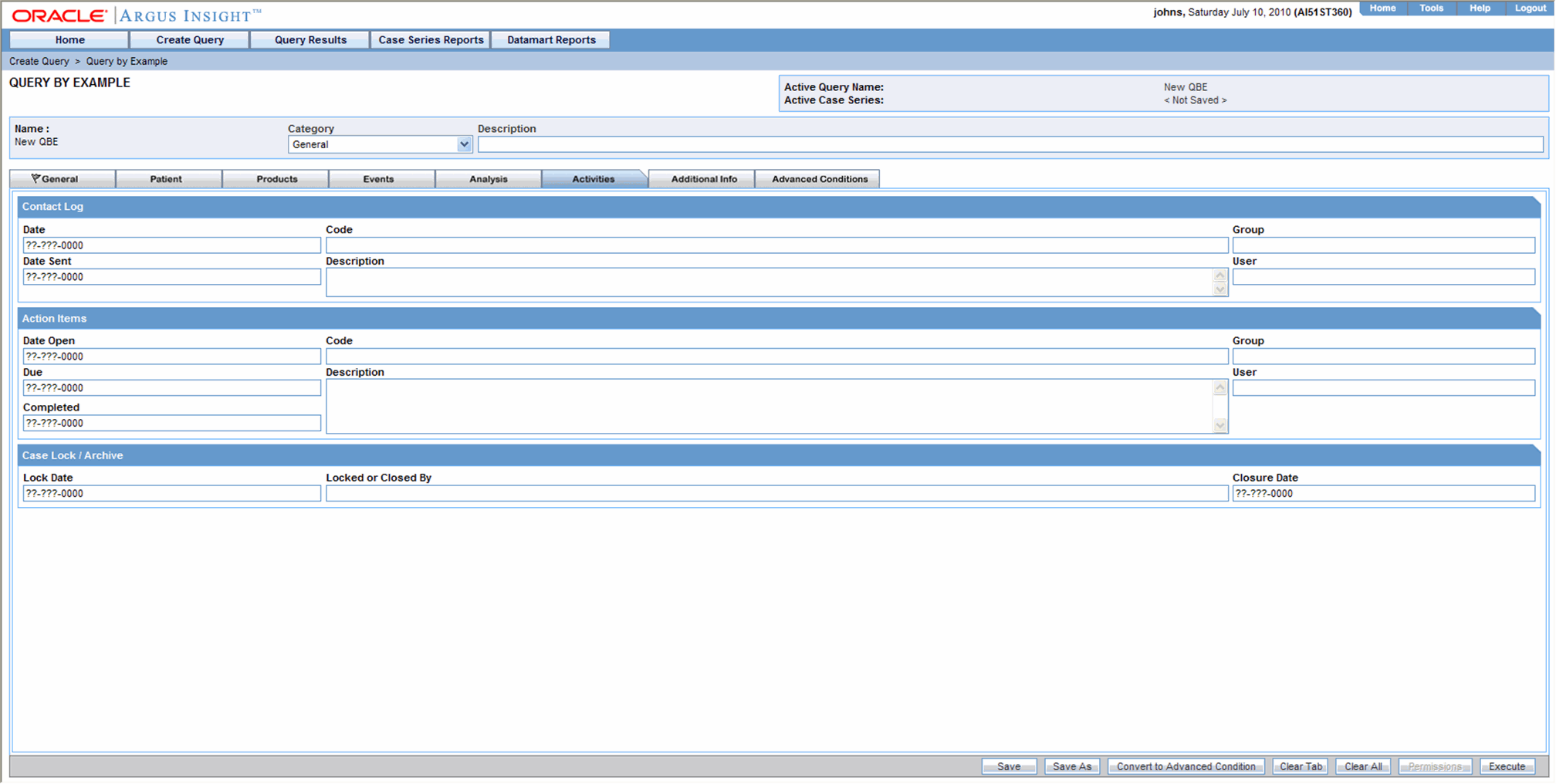
You can specify information only about one contact log
You can specify information only about one action item
Routing search is not applicable
The following table describes all the fields in the Activities page. The field values you specify are used as the query criteria to retrieve matching cases.
| Section | Field | Description |
| Contact Log | Contact Log Date | In this date field, enter the contact log date that the query should look for in cases. |
| Contact Log Code | Select the contact log code that the query should look for in cases. | |
| Contact Log Group | Select the contact log group that the query should look for in cases. | |
| Contact Log Description | In this text area, enter the contact log description that the query should look for in cases. | |
| Contact Log Responsibility | Select the user responsible for the contact log. The query will look for the user name you select. | |
| Contact Log Date Sent | In this date field, enter the sent date for the contact. | |
| Action Items | Date Open | In this date field, enter the action item opening date that the query should look for in cases. |
| Action Type | Select the action type that the query should look for in cases. | |
| Group | Select the responsible group that the query should look for in cases. | |
| Due Date | In this date field, enter the action item due date that the query should look for in cases. | |
| Description | In this text area, enter the action item description that the query should look for in cases. | |
| User | Select the user responsible for the action item. The query will look for the specified user name. | |
| Completed | In this date field, enter the action item completion date that the query should look for in cases. | |
| Case Lock/Archive | Locking Date | In this date field, enter the case lock date that the query should look for in cases. |
| Archive Date | In this date field, enter the case archive date that the query should look for in cases. | |
| Closed By | Select the user that closed the case. |
This Additional Information page differs from what you might be used to seeing in Argus in the following ways:

You can specify information only about one note
No attachments are permitted
You can specify information only about one reference
The following table describes all the fields in the Additional Information page. The field values you specify are used as the query criteria to retrieve matching cases.
| Section | Field | Description |
| References | Reference ID # | In this text box, enter the referenced case ID that the query should look for in the cases. |
| Reference Type | Select the reference type that the query should look for in cases. | |
| Reference Notes | In this text area, enter the reference notes that the query should look for in cases. |
This topic explains how to view the QBE you last modified or executed.
The system assigns the Active status to a QBE when you save modifications to it or execute it. Unless you save the modifications to another QBE or execute another QBE, the last QBE you modified or executed remains Active. This is helpful in situations when you want to access a frequently used QBE.
Use the following procedure to view an Active QBE.
Select Create Query > Query by Example > Active.
The Active Query by Example page displays the QBE form for the last QBE you executed.

If the Active QBE was saved to the system before executing, the name of the QBE appears next to the Active Query Name and Name label. However, if the Active QBE was not saved to the system before executing, the text <Not Saved> is displayed next to the Active Query Name label.
From the Active Query by Example page, you can perform the following tasks:
| Task | Description |
|---|---|
| Modify the values in the QBE form | If required, you can modify the field values in the QBE form. See theCreating a New QBEtopic for information on entering values in the QBE form.
While entering values in a tab, if you wish to clear all the values you entered, click the Clear Tab button. If you wish to all values you entered in all the tabs, click the Clear All button. Use the Save button to save the changed field values. This button is only available for a saved Active QBE. |
| Save Active QBE with another name | Click Save As to save the Active QBE with a different name.
The QBEs that you save to the system are listed in the Query By Example - Library page. TheWorking with Saved QBEstopic explains how to work with saved QBEs. |
| Convert QBE to Advanced Condition | Click Convert to Advanced Condition to convert the QBE to an Advanced Condition. TheUsing QBEs with Advanced Conditionstopic explains how to do this. |
| Assign Permissions | Click Permissions to set the group-level access permissions on the QBE. See theCreating a New QBEtopic for information on setting permissions.
The Permissions button is only available for saved Active QBEs. |
| Change the Description of the Active QBE | You can change the description of the Active QBE by modifying the text displayed in the Description text box.
Click Save to store the changed description. |
| Execute the Active QBE | Click Execute to generate a Case Series by using the Active QBE. |
Modifying the field values in the QBE form for an Active QBE or saving the Active QBE with a different name changes the Active QBE to reflect the most recent changes. The Active QBE also changes in case you modify the field values in the QBE form and execute the QBE without saving the QBE form modifications.
The Query By Example - Library page lists all of the QBEs saved to the system. Use the following procedure to access this page.
Select Create Query > Query by Example > Library. The system opens the Query By Example Library page.
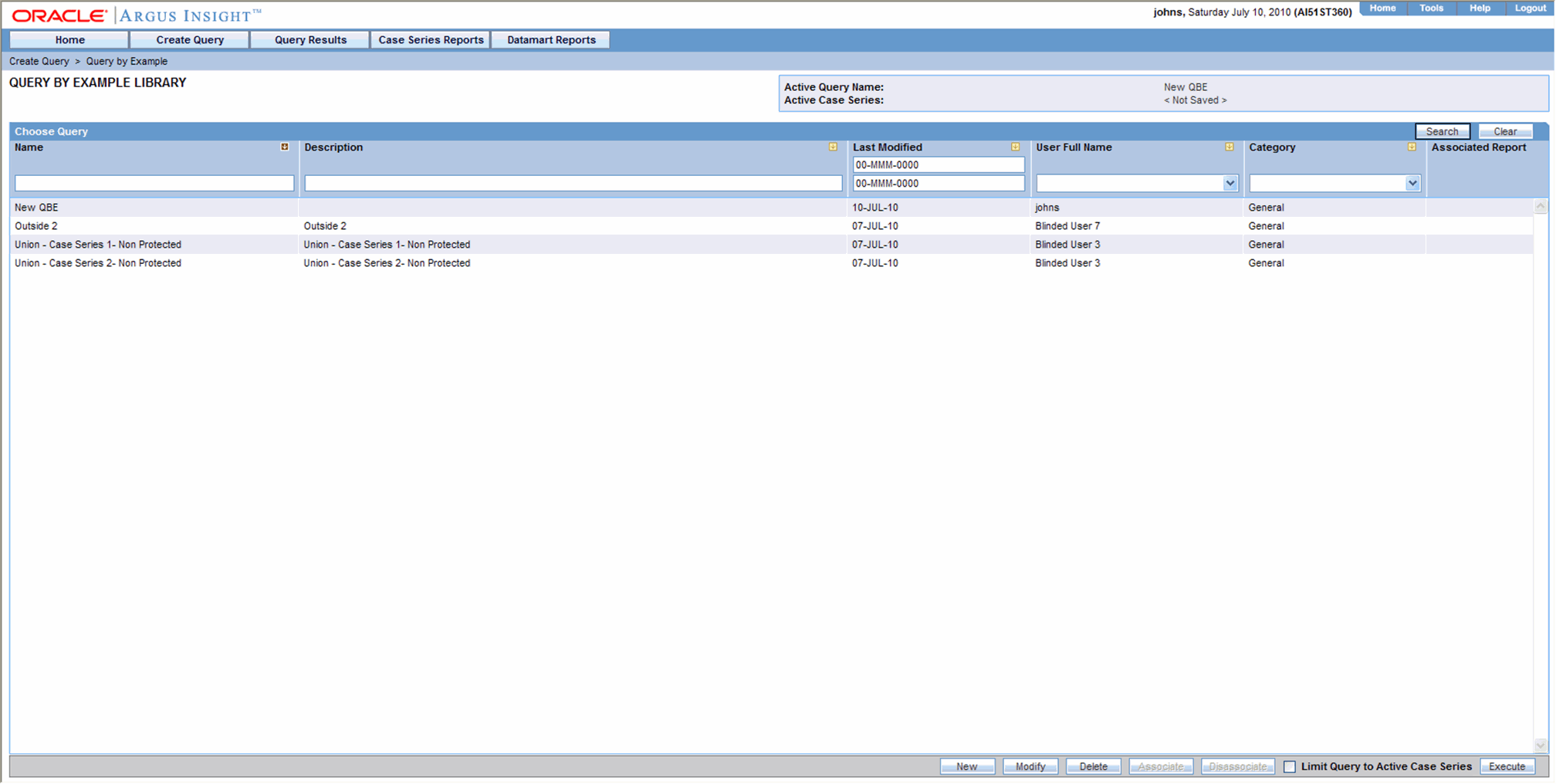
The Query By Example - Library page displays a list of the saved QBEs in a grid format. The descriptions of the grid columns follow.
| Column | Description |
| Name | Displays the name of the QBE you specified while saving |
| Description | Displays the QBE description you entered while saving |
| Last Modified | Displays the date when the QBE was last modified |
| User Full Name | Displays the name of the user who created the QBE |
| Category | Displays the category you assigned to the QBE while saving it |
| Report Name | The icon indicates that a report is associated with the QBE
See theAssociating a QBE with a Reportsection below for more information |
Use the following procedure to search for a saved QBE:
Specify the search criteria, as appropriate:
To search for a QBE by its name, type the QBE name in the Name text box.
To search for a QBE by its description, type the first few words of the description in the Description text box. The system searches for the specified search string in all QBE descriptions.
To search for a QBE by its date of modification, enter the modification date in the first Last Modified date field. You can also specify a date range by typing the start and end dates in the first and second date fields, respectively.
To search for a QBE by its author, select the author name from the User Full Name list box.
To search for a QBE by its category, select the category from the Category list box.
Click Search. Based on your search criteria, the system displays the search result in a list.
You can sort the search result list by clicking the sort icon next to the column headers in the list.
To clear the search result and display all the saved QBEs in the list, click the Clear button.
Instead of selecting Create Query > Query By Example > New, you can directly open a new QBE form by clicking New in the Query By Example - Library page.
Use the following procedure to modify a saved QBE:
Select a QBE from the list of QBEs in the Query By Example - Library page.
Click Modify. The Query by Example page displays the QBE form for the selected QBE. You can modify the field values in the QBE form and save the changes by clicking Save. You can also save the selected query by another name by clicking Save As in the QBE form.
Use the following procedure to delete a saved QBE.
Select a QBE from the list of QBEs in the Query By Example - Library page.
Click Delete. The Delete QBE dialog box appears.

Click OK to delete the QBE. The system deletes the selected QBE; the Query By Example - Library page appears.
Argus Insight lets you associate a QBE to a particular Standard Report and schedule a time when the report needs to be generated and sent to another user through email. This is helpful in situations when you need to generate the latest Case Series and run a report on it each time the datamart is refreshed. Instead of manually executing the QBE to generate the latest Case Series and running the report, you can use the report association functionality of Argus Insight.
|
Note: The user who is scheduling reports should have an enterprise login configured in Cognos to schedule the report.It is not possible to associate multiple reports with a query by a user. If user associates multiple reports against the same query, the scheduling information is overwritten by the latest schedule mentioned by the user. |
Use the following procedure to associate a QBE with a Standard Report:
In the Query By Example - Library page, select the QBE that you wish to associate with a Standard Report.
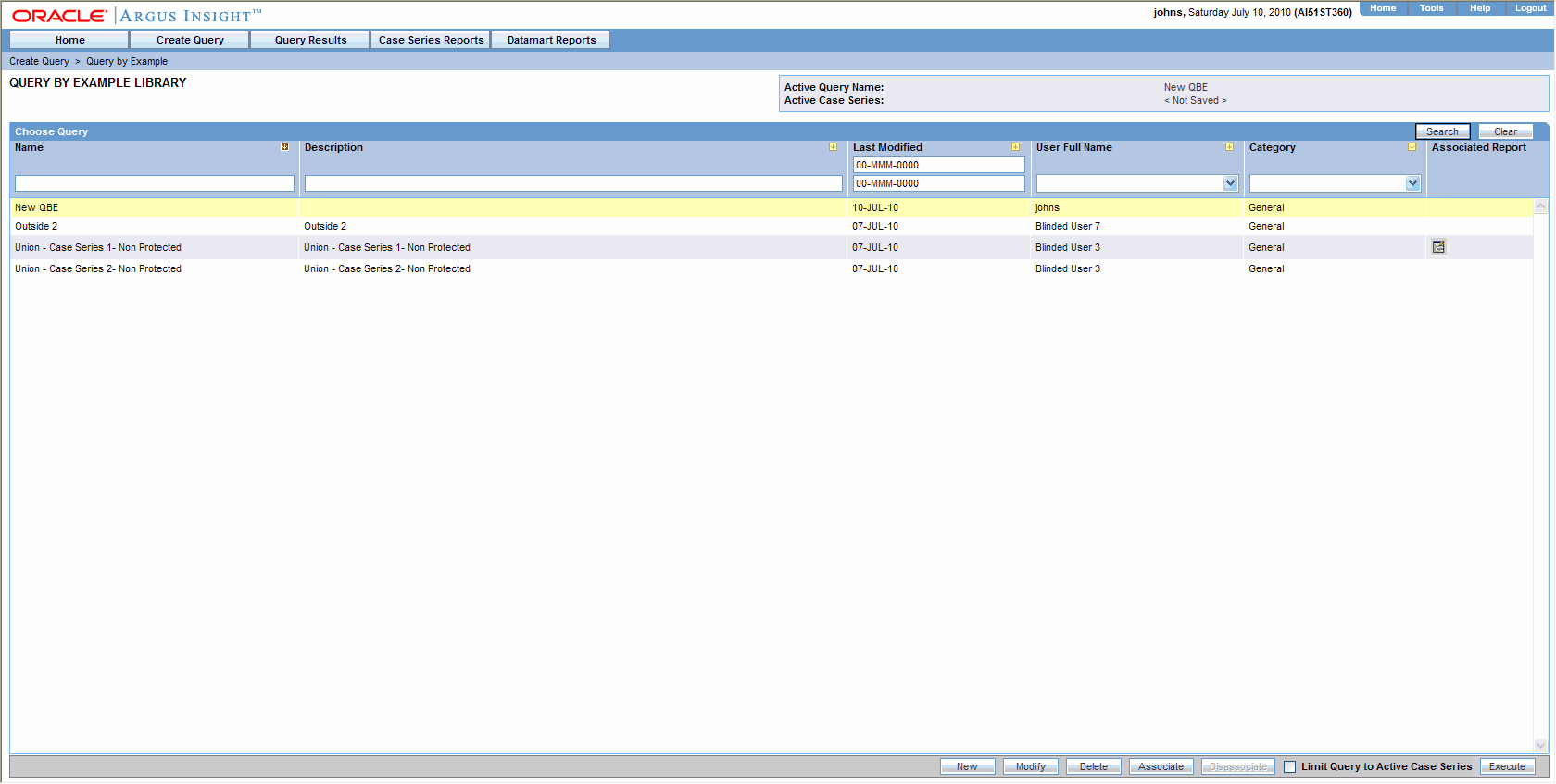
Associate the QBE with a Standard Report.
Click Associate. The Scheduled Report Groups window appears. This window displays the information of all the report groups that have been scheduled by the logged-in user.
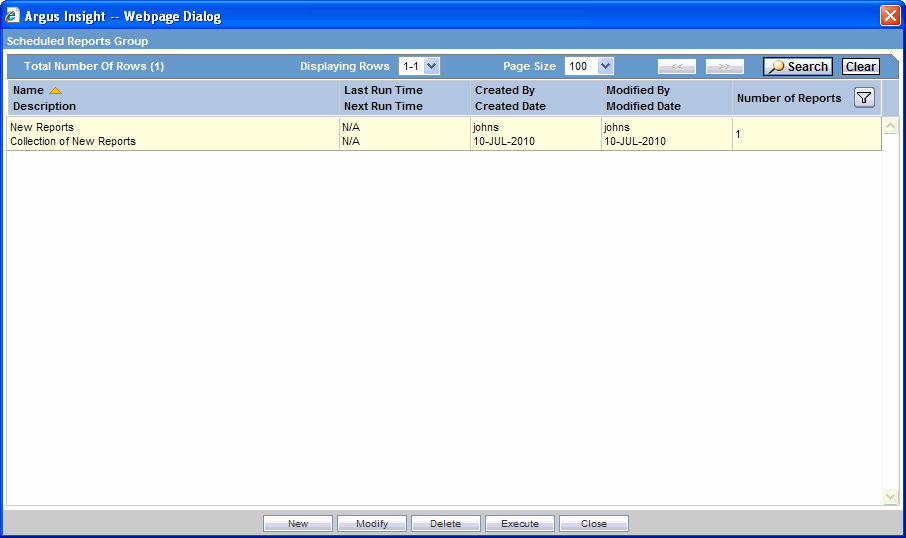
Click New. It enables you to either do Report Association Only or to perform Report Scheduling.

Schedule the report.
Click the Scheduling tab. The Reports Scheduling page appears.
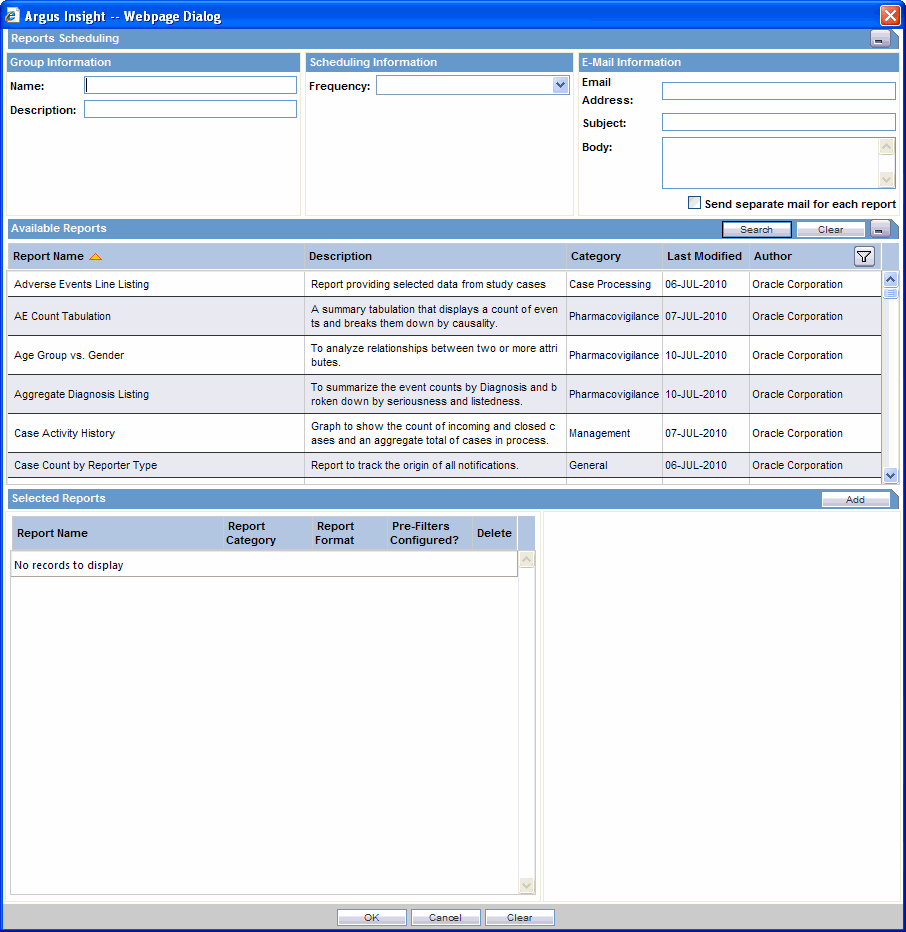
Enter the Name and Decription of the report.
Use the Frequency list box to specify how often you wish to have the system run the selected QBE and generate the selected report. The options available are: Once, Daily, Weekly, Monthly, Quarterly, and Yearly.
Specify the start time in the Time field.
Based on the option you selected in the step above, specify the instant when you want the report generated as described in the table below.
| Frequency Option Selected | Additional Scheduling Information to Specify |
|---|---|
| Once | In the Date text box that appears, enter the date when you want to have the report generated. |
| Daily | In the Time text box that appears, enter the time when you want to have the report generated. The time must be entered in the HH:MM AM/PM format. Hours should be between 1 and 12. |
| Weekly | From the Day of Week option button group that appears, select the day of week on which you want to have the report generated. Also, specify the time in the Time text box. |
| Monthly | Use the Day list box to select the day of the month on which you want to have the report generated. Also, specify the time in the Time text box. |
| Quarterly | Quarterly reports are generated on the first day of the quarter. In the Time text box, enter the time when you want to have the report generated on the first day of the quarter. |
| Yearly | In the Date and Time text boxes, specify the date and time when you want to have the yearly report generated. |
In the Start Date and End Date fields, enter the start and end dates for this activity, respectively.
Specify the email recipients of the report you scheduled.
In the Email Address text box, type the email address of the report recipient. If there are multiple recipients, use a semicolon to separate their email addresses.
Type the subject line in the Subject text box.
Type the email body text in the Body text box.
Select the report(s) from under Available Reports and click Add. The selected reports are displayed under Selected Reports.
Click the selected report(s) under Selected Reports. The prompts are loaded in the right pane.

Enter the sub title for the report pre-filter and click OK.
Click OK in the Reports Scheduling window. In case of Association only, the scheduling steps are not required.
Click OK. The system associates the QBE with the selected report and saves the scheduling information; Query By Example - Library page appears. The icon displayed in the Report column indicates that the QBE is associated with a report.

|
Note: Refer to the Associated Library and Query Library sections in the Library chapter, to view the steps on how to disassociate reports in those libraries |
Use the following procedure to execute a saved QBE.
Select a QBE from the list of QBEs in the Query By Example - Library page.
Click Execute. The system executes the QBE; the Active Case Series page appears.
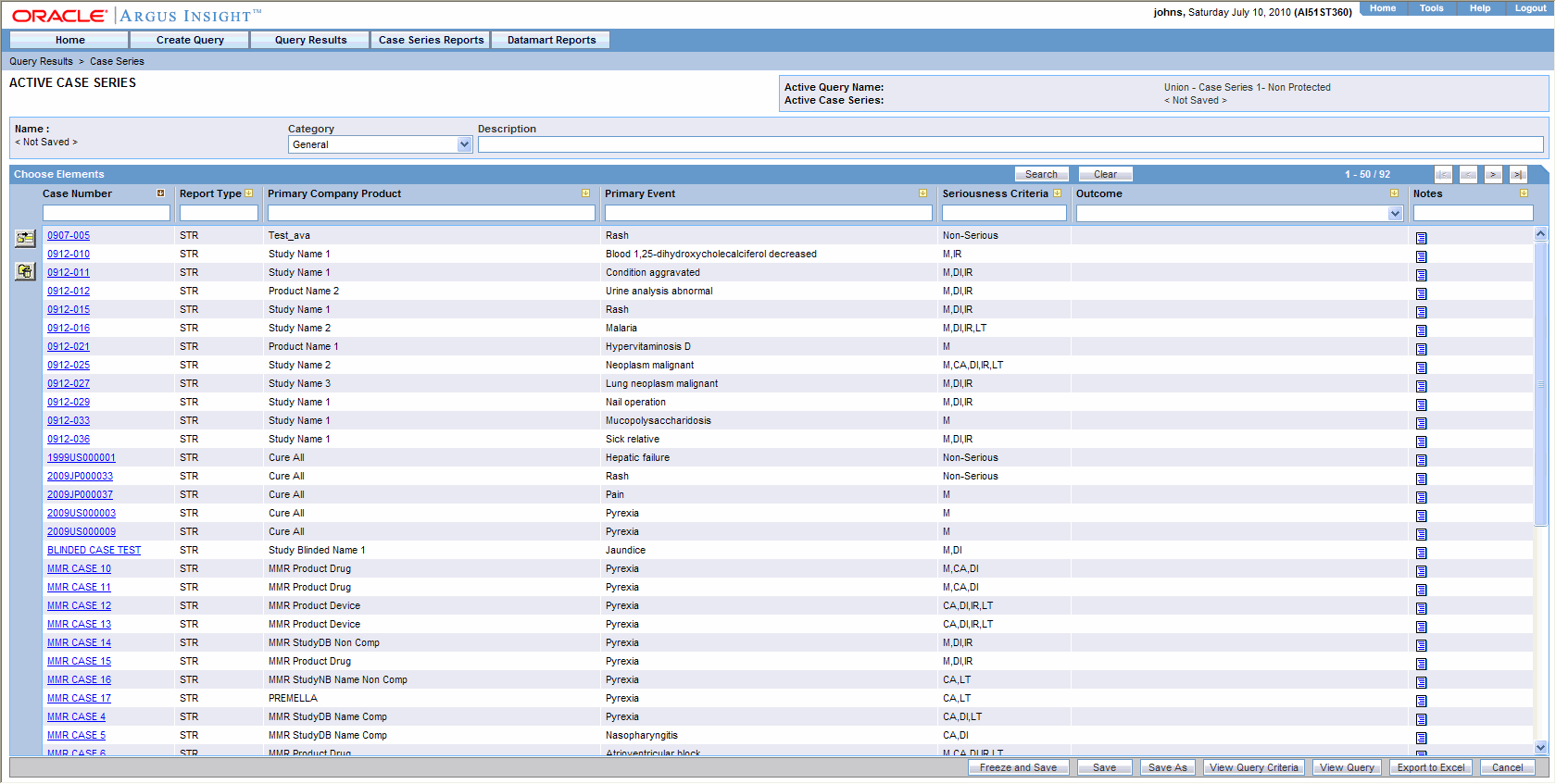
If a report is associated with the saved QBE, click on Execute button. The Active Case Series page and Pre Filter page of the associated report is displayed.
Enter the prompts value in the Pre Filter page.
Click on the Execute button to generate the report.
After generating the Case Series, you can manually modify it or save it. See theCase Serieschapter for more information on working with Case Series.
|
Note: You can also export the Case Series results into an excel file. For details see Exporting Case Series to Excel. |
Just as the system assigns the Active status to a QBE when you save modifications to it or execute it, the last saved or generated Case Series becomes the Active Case Series.
Use the following procedure to narrow down the list of cases in the Active Case Series. You may want to run an existing QBE on an Active Case Series instead of creating and running a new QBE on the entire datamart and generating a new Case Series.
Generate the Case Series on which you wish to run another QBE:
If the Case Series on which you wish to run another QBE is not yet generated / active, you can either create aNew QBEand execute it or execute a saved QBE as explained in the previous section. This Case Series automatically becomes the Active Case Series and remains so until you execute another query to generate a different Case Series.
Alternatively, if the Case Series on which you wish to run another QBE is already saved in the system, select Query Results > Case Series > Library. In the Case Series Library page that appears, select the Case Series title and click Make Active.
Select Create Query > Query by Example > Library. The Query By Example - Library page appears.
Select the query you want to run on the Active Case Series you generated in step 1.
Check the Limit Query to Active Case Series checkbox.
Click Execute. The system runs the selected QBE on the Active Case Series and displays the Active Case Series page. Note that the Case Series you just generated becomes the Active Case Series.
Advanced Conditions let you create complex queries that involve Boolean and Set operations among various fields. In Argus Insight, Advanced Conditions are created in the Advanced Conditions editor, which employs a spreadsheet-like approach for adding query conditions (fields and their values) and conditional operators (Boolean or Set).
In Argus Insight, QBE is integrated with Advanced Conditions to let you perform the following tasks.
Converting a QBE to an Advanced Condition
Integrating a QBE with an Advanced Condition
A QBE can be used to start an Advanced Condition that employs Set or Boolean operations between QBE form fields that have specific values. When you convert a QBE to an Advanced Condition, all the QBE form fields in which you entered values are listed in the Active Advanced Conditions Editor page as Advanced Condition attributes.
Use the following procedure to convert a QBE to Advanced Condition.
Open a QBE form by either starting a new QBE, opening the Active QBE, or opening a saved QBE.
Verify the field values you specified in the various tab pages in the QBE form.
Click the Convert to Advanced Condition button. The Active Advanced Condition Editor page appears; all the fields in which you specified values in the QBE form are listed as Advanced Condition attributes.

In the Advanced Condition editor, you can build your query further by:
Adding additional attributes (fields) and specifying their values
Adding another Advanced Condition as an attribute
Placing runtime parameters in attributes
Placing parentheses to determine the query execution order
Specifying conditions for attributes values
Specifying Set and Boolean operators to join the various attributes
See the Advanced Conditionschapter for detailed information on building Advanced Conditions by using the options in the Advanced Condition editor.
Argus Insight lets you integrate a new, active, or saved QBE with an existing Advanced Condition through these Set operators: Intersect, Minus, or Union. If required, you can integrate your QBE with multiple Advanced Conditions. The multiple Advanced Conditions can have Set or Boolean operations between them.
Use the following procedure to integrate a QBE with existing Advanced Conditions:
Open a QBE form bystarting a new QBE, opening the Active QBE, or opening a saved QBE.
Verify the field values you specified in the various tab pages in the QBE form.
Click the Advanced Conditions tab in the QBE form. The Advanced Condition tab page displays the Advanced Condition editor.
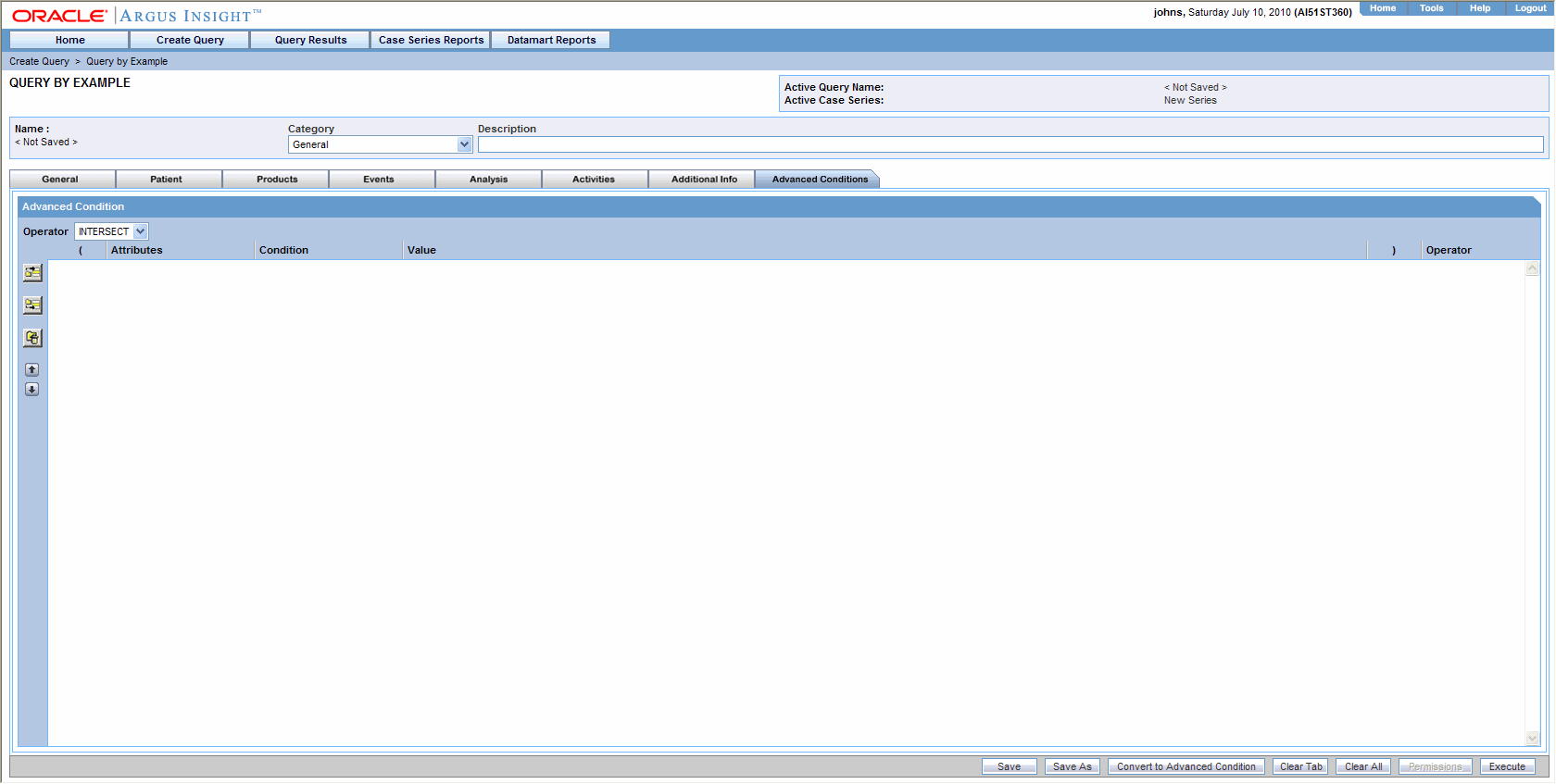
Use the Operator list box to specify the Set operator you want to use to integrate the QBE and the Advanced Condition. You can select one of these options: Intersect, Minus, Union.
Select the Advance Condition you want to integrate with the QBE.
Click the icon on the left bar. A context menu appears. In the context menu, all the Advanced Conditions which are stored in the system and are accessible to the user are organized by categories.

In the context menu, browse to the appropriate category and select the required Advanced Condition. The selected Advanced Condition appears as a row in the Advanced Condition editor.
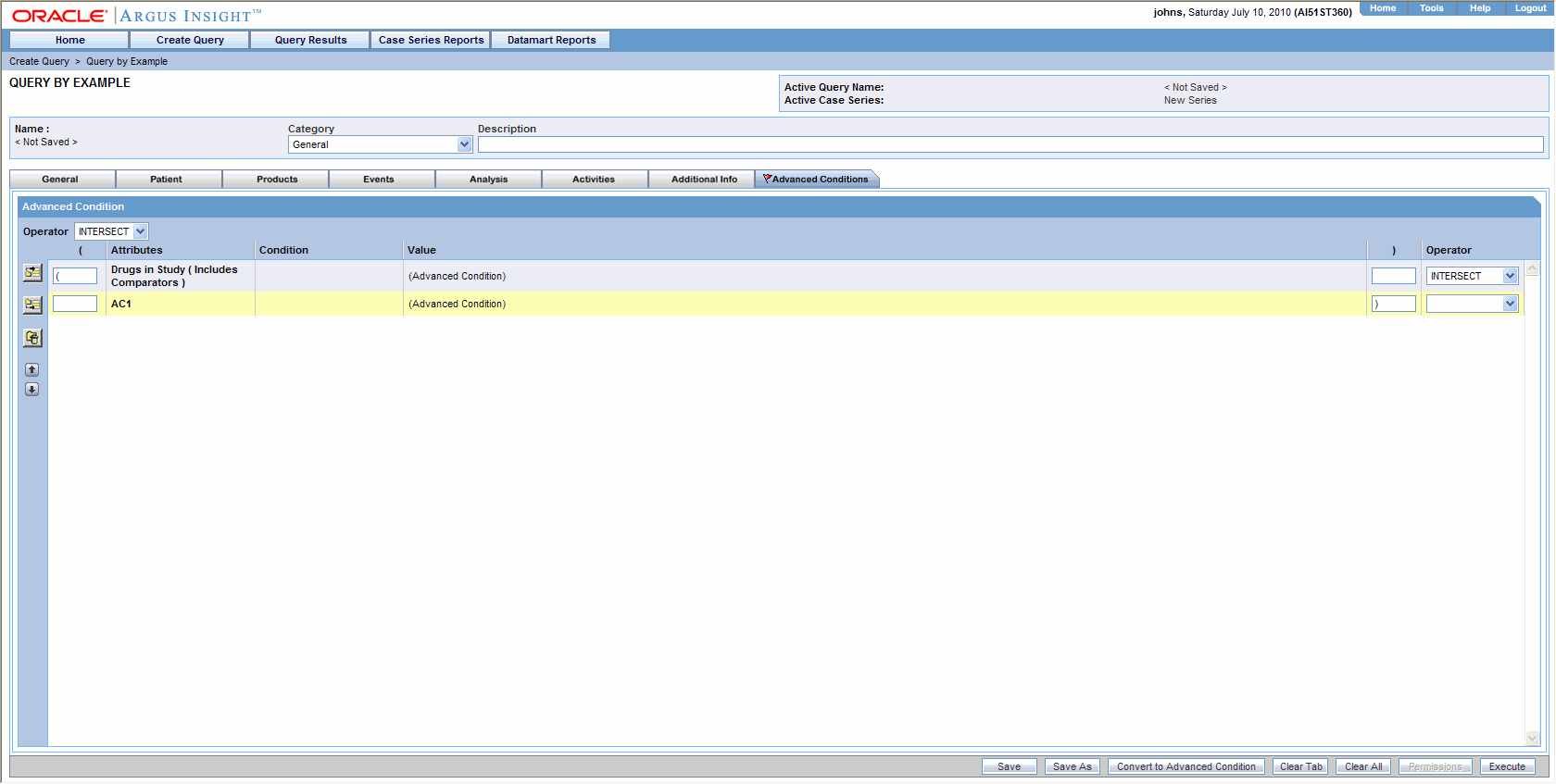
If required, add other Advanced Conditions. Click the icons on the left bar to insert another Advanced Condition above or below the existing Advanced Condition.
|
Tip: You can change the structure of thequery by changing order of rows in the editor. Use the following procedure to To do this, select a row and click the Up or Down buttons to move the row upwards or downwards. |
Type parentheses in the ( and ) columns to determine the order of execution for the selected Advanced Conditions.
Use the list box in the Operator column to specify the operators between the selected Advanced Conditions. You can select from these options: AND, OR, Intersect, Minus, and Union.
|
Note: See the Advanced Conditions chapter for detailed information on creating Advanced Conditions by using the options in the Advanced Condition editor. |
Save the integrated query by clicking Save As.
|
Note: You can convert the integrated QBE and Advanced Condition into a single Advanced Condition by clicking Convert to Advanced Condition. See Converting a QBE to an Advanced Condition for details. |
Click Execute to run the integrated QBE and generate the Case Series. The Active Case Series page appears; the Case Series is displayed. See the Case Series chapter for more information on working with Case Series.
WhileQBElets you create queries by specifying unique field values in the various tab pages of the QBE form, Filters let you create queries by specifying multiple or a range of values (in numeric or date fields) for each field in a set of fields displayed on a single page. Therefore, you may choose Filters in situations when your querying criteria is based on multiple values or a range of values in fields.
Argus Insight provides five predefined Filters. Each predefined Filter comprises of a set of specific datamart fields called filter elements. The following table lists the five predefined Filters and the elements associated with them.
|
Note: The Filters field labels are displayed as per the field labels configured in Argus. |
| Predefined Filter Name | Associated Elements (Fields) | ||
|---|---|---|---|
| Compliance | Case Followup Receipt Date | Case Initial Receipt Date | Case Report Type |
| Country of Incidence | Event Listedness/Lic Country | Family Name | |
| Owned by Site | Product | Project/Study/Center | |
| Related to Study Conduct? (As Reported) | Report Agency | Report Form | |
| Report Submission Date | Reporting Group | Advanced Conditions | |
| Configuration | Country of Incidence | Product | Project/Study/Center |
| Advanced Conditions | |||
| Management | Case Delayed/Open | Case Followup Receipt Date | Case Initial Receipt Date |
| Case Report Type | Case Seriousness | Case Status | |
| Country of Incidence | Has Followup | Owned by Site | |
| Product | Reports Pending | Workflow Group | |
| Advanced Conditions | |||
| Pharmacovigilance | ATC Code | BMI | Case Abbreviated Narrative |
| Case Comment | Case Followup Receipt Date | Case Initial Receipt Date | |
| Case Narrative | Case Outcome | Case Seriousness | |
| Company Comment | Country of Incidence | Dosage Regimen route of Administration | |
| Dose | Drug Duration of Administration | Evaluation in Light of Similar Events | |
| Event Diagnosis Flag | Event Seriousness | Event Term | |
| Local Evaluator Comment | Onset Latency (minutes) | Outcome of Event | |
| Patient Age (In Years) | Patient Age Group | Patient Ethnicity | |
| Patient Gender/Pregnancy | Patient Relevant Tests | Product | |
| Product Type | Project/Study/Center | Rechallenge/Dechallenge | |
| Relevant History Condition | Reporter Type/HCP | Study Blinding Status | |
| Time to Onset from First Dose | Time to Onset from Last Dose | Advanced Condition | |
| Workflow | Case Delayed/Open | Case Followup Receipt Date | Case Initial Receipt Date |
| Case Report Type | Case Seriousness | Case Status | |
| Event Listedness/Lic Country | Event Term | Family Name | |
| Has Followup | Owned by Site | Product | |
| Project/Study | Workflow Group | Advanced Conditions | |
Argus Insight also lets you define custom Filters by letting you select a set of elements (datamart fields) and saving the selection as your own Filter.
To create a filter using queries, select a predefined or custom Filter and specify values (multiple or range) in the desired filter elements associated with the Filter. You can then execute this query (Value Set)to generate a Case Series.
The set of values you specify in the elements associated with a Filter is called a Value Set. For example, a particular Filter may have this Value Set:
| Filter Element | Values Specified |
|---|---|
| Country of Incidence | United States and Germany |
| Product Name | CureAll Injection and CureAll Capsule |
| Coded Event Description | Injection site rash and Aggravated Nausea |
| Seriousness Criteria | Hospitalized and Intervention Required |
| Patient Age | 25 to 65 years Note that ranges can only be specified for fields that have numeric values |
Argus Insight lets you save Value Sets. Therefore, each Filter can have multiple Value Sets. The advantage of saving Value Sets is that this enables you to execute a Value Set later without having to select a Filter and then entering values in the associated elements.
The topics that follow explain how to work with Filters.
Using Predefined Filters
Creating Custom Filters
Working with the Last Modified or Executed Value Set
Working with Saved Filters and Value Sets
Using Filters with Advanced Conditions
This topic explains how to:
Select a predefined Filter
Create a Value Set for the predefined Filter by entering values in the associated elements
Generate a Case Series by executing the Value Set
Use the following procedure to select a predefined filter.
Select Create Query > Filters > New Value Set. The Select Filter for New Value Set dialog box appears.

|
Note: The Select Filter for New Value Set dialog box displays a list of all the predefined as well ascustom Filters and their associated elements. You need to scroll down the dialog box to view all the Filters. |
Select a predefined Filter (Compliance, Configuration, Management, Pharmacovigilance, and Workflow) depending on your reporting needs. For example, select Compliance. If there are any custom Filters saved to the system, you can select one of those as well
Click OK. The Filter Value Set page appears.
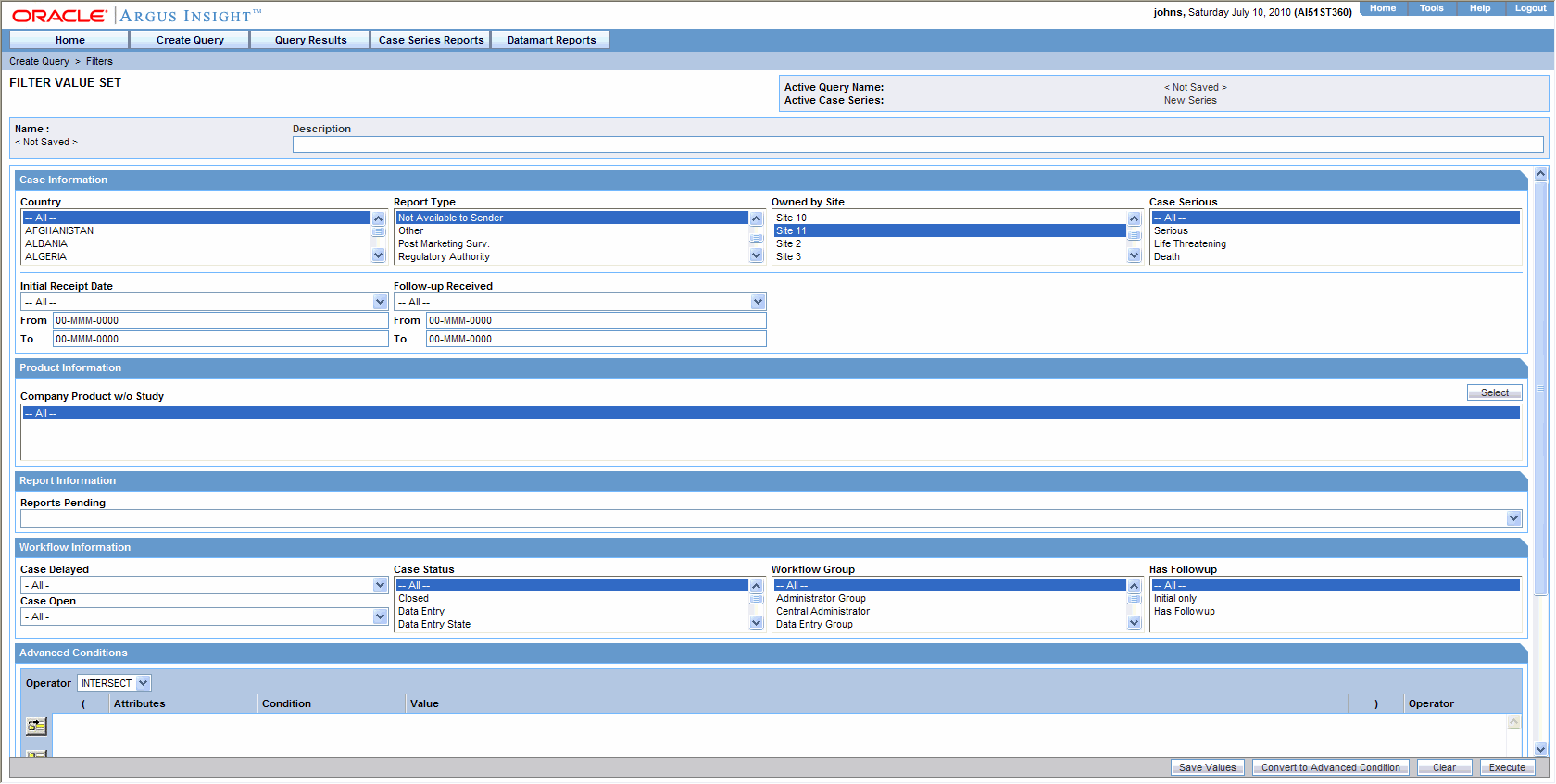
|
Note: In the Filter Value Set page, all the elements associated with the Filter are organized in sections. You need to scroll down the page to view all the sections. All the predefined Value Sets contain the Advanced Condition section. You can use the options in this section to select an existing Advanced Condition and integrate your Value Set with it. See theIntegrating a Value Set with an Advanced Condition topic for details. You can also convert the entire Value Set to an Advance Condition. The Converting a Value Set to an Advanced Condition topic explains how to do this. |
Use the following procedure to create a value set.
Specify values for the Filter elements in the various sections. Depending on the Filter you selected, the Filter Value Set page may contain these sections:
| Sections in the New Value Set Page | Associated Elements (Fields) | ||
|---|---|---|---|
| Case Information | Case Followup Receipt Date | Case Initial Receipt Date | Case Report Type |
| Country of Incidence | Event Listedness/Lic Country | Family Name | |
| Owned by Site | Product | Project/Study | |
| Patient Information | Patient Age Group | Patient Age (In Years) | BMI |
| Patient Gender/Pregnancy | Patient Ethnicity | ||
| Product Information | Regimen Daily Dose | Total Regimen Dosage | Product |
| Drug Primary Indication Code | Rechallenge/Dechallenge | Total Drug Dosage | |
| ATC Code | |||
| Event Information | Event Seriousness | Event Term | Onset Latency (minutes) |
| Outcome of Event | Event Listedness/Lic Country | Related to Study Conduct? (As Reported) | |
| Workflow Information | Workflow Group | Has Followup | Case Status |
| Case Delayed/Open | |||
| Miscellaneous Information | Lab Test/Assessment | Lab Results | |
| Report Information | Reports Pending | Report Agency | Report Submission Date |
| Reporting Group | Report Form | ||
|
Note: The MedDRA browser can be accessed from the Create Query > Filters New Value Set > Pharmacovigilance | Workflow categories. The MedDRA browser for Pharmacovigilance | Workflow filter categories supports the following options specific to Filters: All hierarchy radio-button Use this option to enable a query search based on all/selected hierarchical terms in MedDRA. The search output captured depends on the check-boxes selected in the MedDRA browser window. Term only radio-button Use this option to select multiple terms within a specific AE term. Click on the term(s) you want to include in your search criteria. These terms are highlighted in yellow. The output based on the term(s) selected in the MedDRA browser, is populated in the relevant section of the Filter. |
Examine the Value Set result.
Click Execute.
While the system searches for matching cases, the following dialog box is displayed.

|
Tip: You may cancel the query execution at this point and return to the Filter Value Set page by clicking Cancel Query in the dialog box above. |
If the system finds cases that match the query criteria, a list of such cases is displayed in the Active Case Series page.
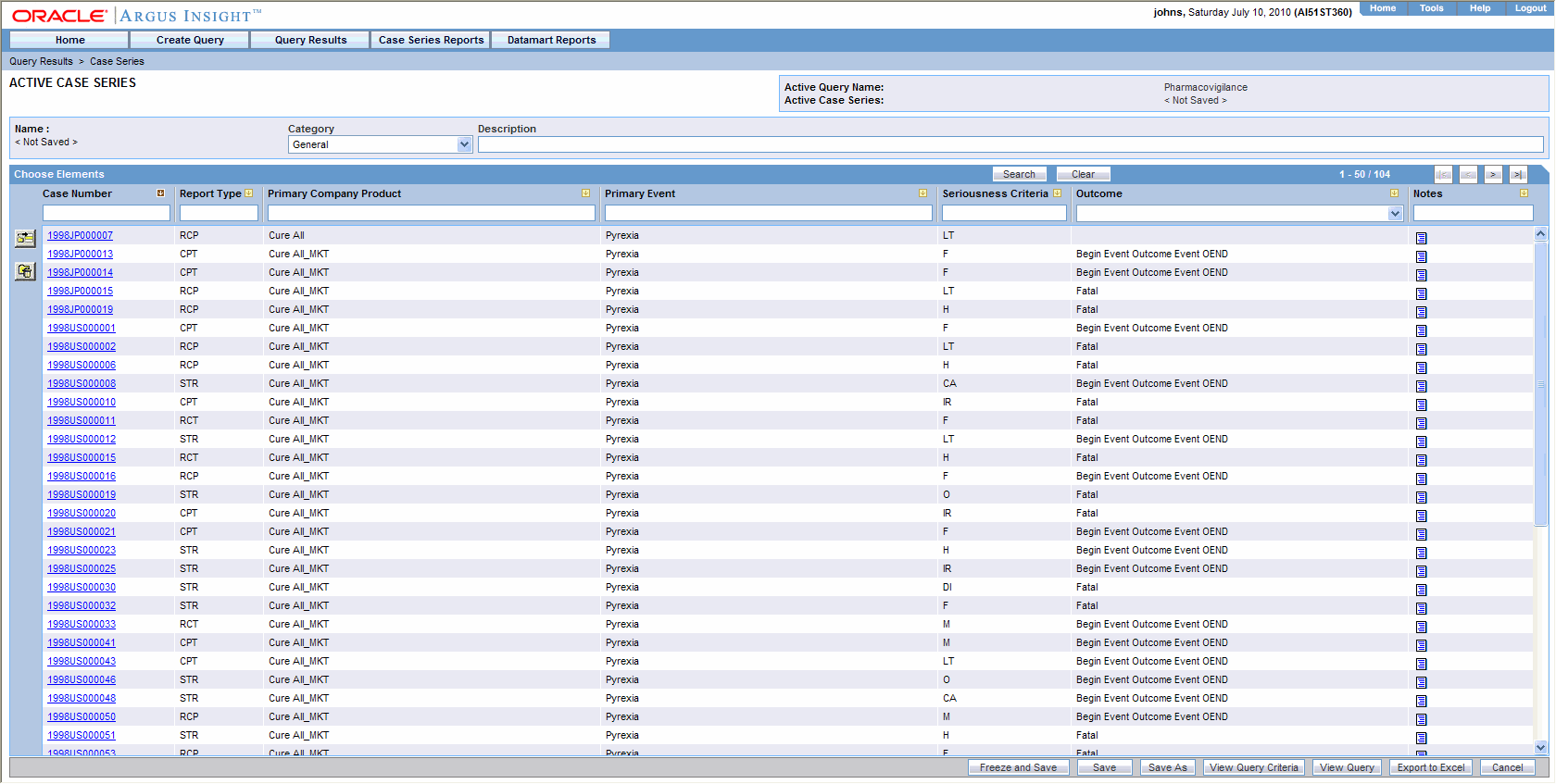
Examine the Case Series. If the Case Series is too large, you may want to modify the Value Set to narrow down the Case Series. Alternatively, if you find the Case Series to be appropriate, you can save the Value Set to the system.
To return to the Filter Value Set page, click View Query in the Active Case Series page. The Filter Value Set page appears.

|
Note: When you save the modifications to a Value Set or execute a Value Set, the system assigns the Active status to the Value Set. Therefore, when you return to the Value Set page, the Active Query Name label displays the name of the Filter. |
If required, modify the Value Set and examine the result again or proceed to save the Value Set.
Save the Value Set to the system.
Type a description of the Value Set in the Description text box. For example, you can describe the type of cases the Value Set retrieves.
Click Save Values. The Save Value Set dialog box appears.

Type the name of the Value Set in the Name text box.
Click OK. The system refreshes the Filter Value Set page. Note that the following new elements appear on the page.
The Name label displays the name of the Value Set page you specified
Two new buttons appear at the bottom of the page: Save Values As and Permissions.
|
Note: All the Value Sets you save to the system are listed in the Filter Library page. The topicWorking with Saved Filters and Value Sets explains how to work with saved Value Sets. |
|
Tip: If you make modifications to thefield values after you have saved the Values Set to the system, use the Save Values button to save the changed field values. To save the Value Set by another name, use the Save Values As button. To clear all the field values in the Filter Value Set page, click Clear. |
Assign group-level permissions on the saved Value Set.
Click the Permissions button. The Permissions dialog box appears. A list in this dialog box displays the names of all the groups (except the Administrator group) that the system administrator has created.

Use the list box next to a group name to assign permissions to the group members on the Value Set you have created. You can select from these options:
| Permission | Description |
| No Access (Default) | No group members will be able to access the Value Set |
| R | Group members will only be able to view the Value Set |
| R/W | Group members will be able to view and modify the Value Set |
| R/W/D | Group members will be able to view, modify, and delete the Value Set |
| R/W/D/P | Group members will be able to view, modify, delete, and assign permission on the Value Set |
|
Note: The author of the Value Set always has the highest level of permission (R/W/D/P) on it. For example, you belong to the Data Entry group and you assign the No Access permission level to the Data Entry group on a Value Set that you create. In this case, while you will continue to have the highest level of permission on your Value Set, other members in your group will not be able to access your Value Set. |
Click OK. The system saves the permission settings.
Use the following procedure to execute a Value Set.
Click Execute.
The system retrieves the list of cases that match the Value Set criteria and displays it in the Active Case Series page.

After generating the Case Series, you can manually modify it or save it. See the Case Serieschapter for more information on working with Case Series.
This topic explains how to:
Create a custom Filter
Create a Value Set for the custom Filter
Generate a Case Series by executing the custom Value Set
Use the following procedure to create a custom filter.
Select Create Query > Filters > Library. The Filter Library page appears. This page lists the predefined as well as custom Filters and their values sets in a control tree format.
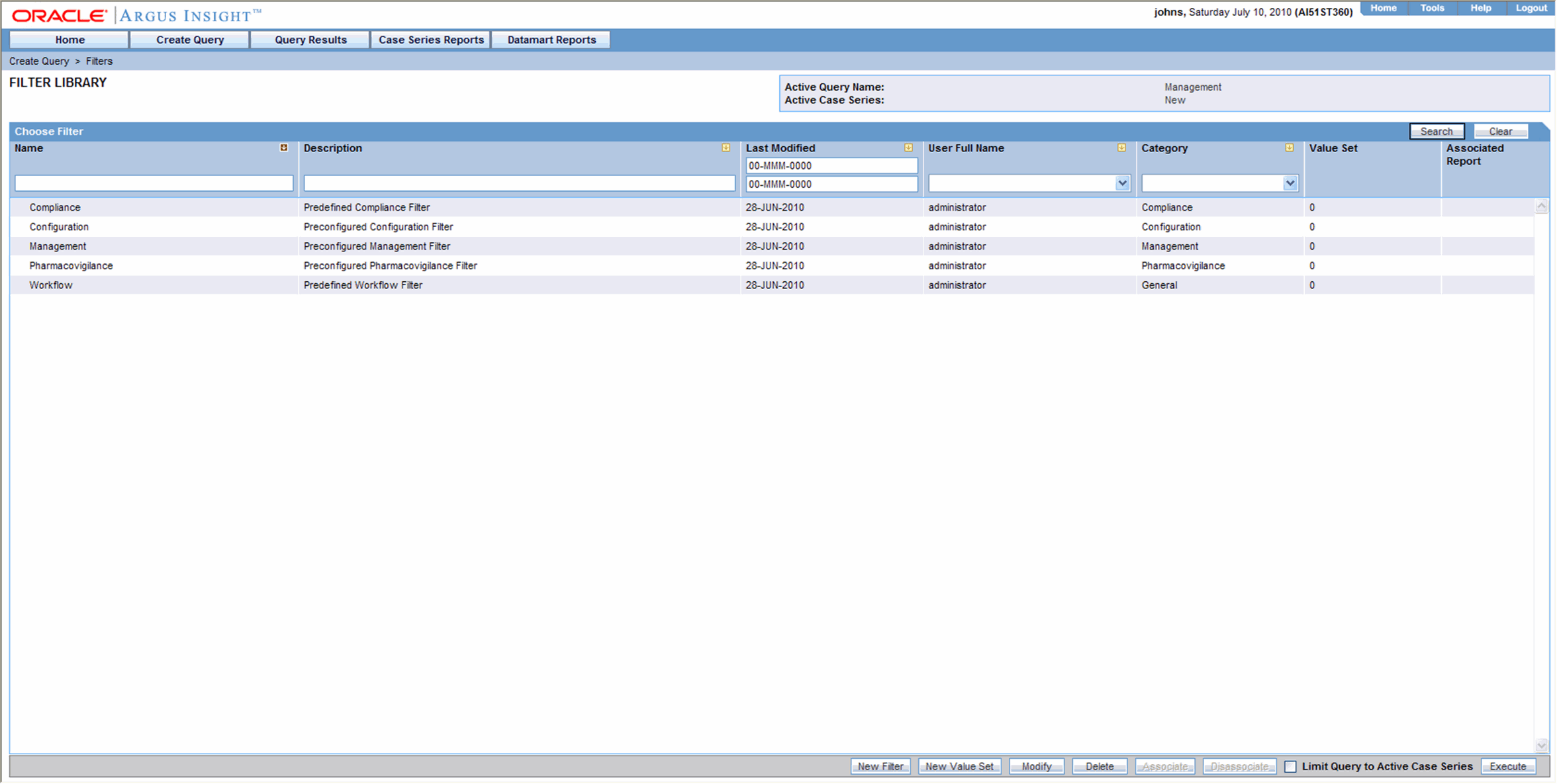
Click the New Filter button. The Filter Elements page appears.
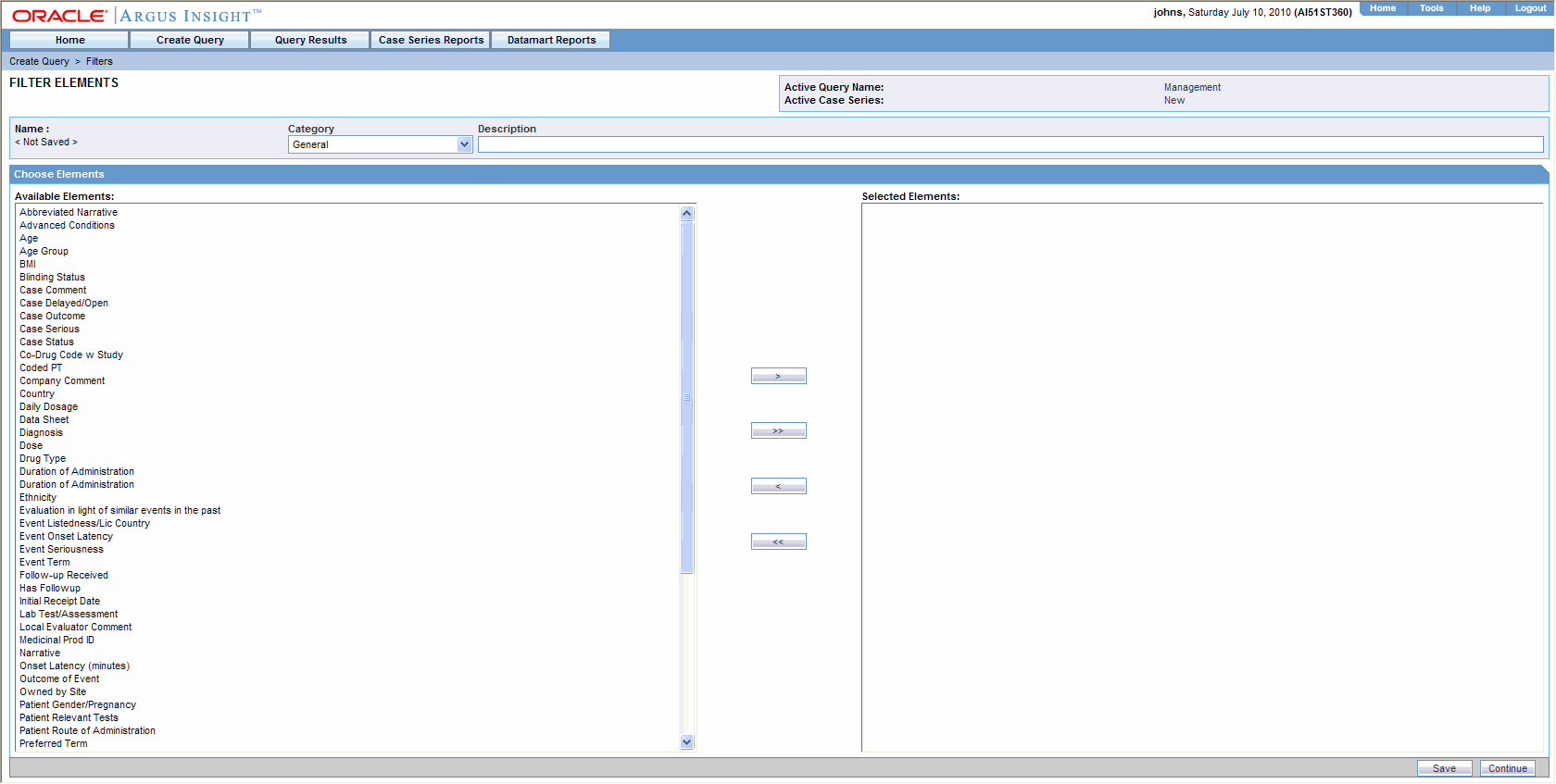
From the Available Elements list, select an element you want to associate with the custom Filter.
Click the > button to associate the selected element with the custom Filter. The selected element appears in the Selected Elements list.
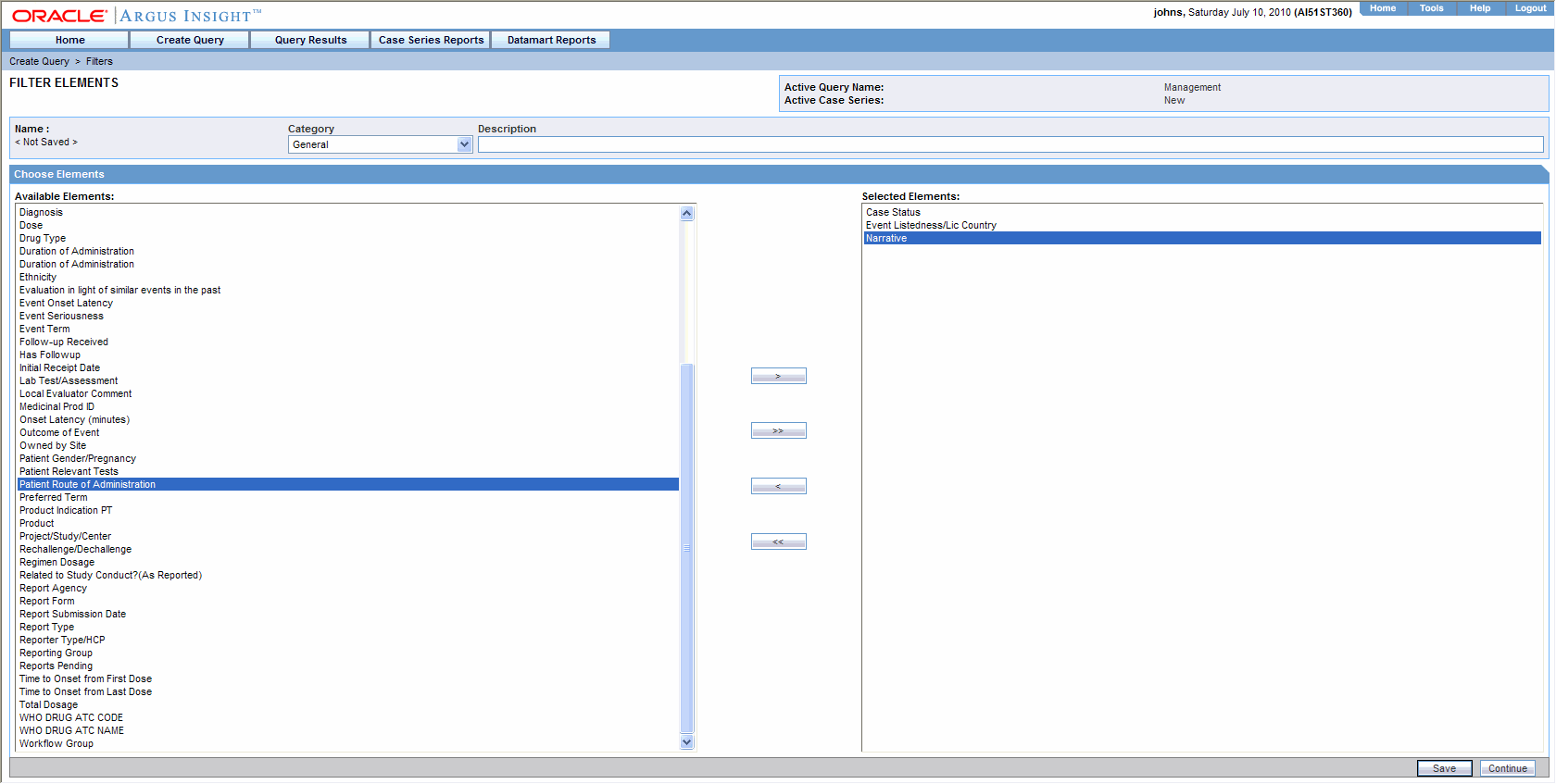
|
Tip: To add all the elements in Available Elements list to the Selected Elements list, click the >> button.To remove an element from the Selected Elements list, click the > button. To remove all the elements from the Selected Elements list, click >> the button. |
Save the Filter.
Use the Category list box to assign a category to the custom Filter. A category indicates the reporting aspect to which your Filter pertains: Compliance, Configuration, General, Management, or Pharmacovigilance. Specifying the category also helps you in searching the relevant Filters from a list of all the Filters saved in the system.
Type a description of the custom Filter in the Description text box.
Click Save. The Save Filter dialog box appears.

Enter the custom Filter name in the Name text box.
Click OK. The system saves the custom Filter; the Filter Elements page refreshes. Note that the following new elements appear on the page.
The Name label displays the name of the saved filter.
The Active Query Name label in the upper-right corner of the page now displays the name of the Filter you specified.
Two new buttons appear at the bottom of the page: Save As and Permissions.
|
Note: If you make modifications to the Filter elements after you have saved the Filter to the system, use the Save button to save the changes. To save the Filter by another name, use the Save As button. |
Assign group-level permissions on the Filter.
Click the Permissions button. The Permissions dialog box appears. A list in this dialog box displays the names of all the groups (except the Administrator group) that the system administrator has created.

Use the list box next to a group name to assign permissions to the group members on the Filter you created. You can select from these options:
| Permission | Description |
| No Access (Default) | No group members will be able to access the Filter |
| R | Group members will be able to only view the Filter |
| R/W | Group members will be able to view and modify the Filter |
| R/W/D | Group members will be able to view, modify, and delete the Filter |
| R/W/D/P | Group members will be able to view, modify, delete, and assign permission on the Filter |
|
Note: The author of the Filter always has the highest level of permission (R/W/D/P) on the Filter. For example, you belong to the Data Entry group and you assign the No Access permission level to the Data Entry group on a Filter that you create. In this case, while you will continue to have the highest level of permission on your Filter, other members in your group will not be able to access the Filter. |
Click OK. The system saves the permission settings.
Use the following procedure to create a value set for a custom filter.
Click Continue in the Filter Elements page. The Filter Value Set page appears.
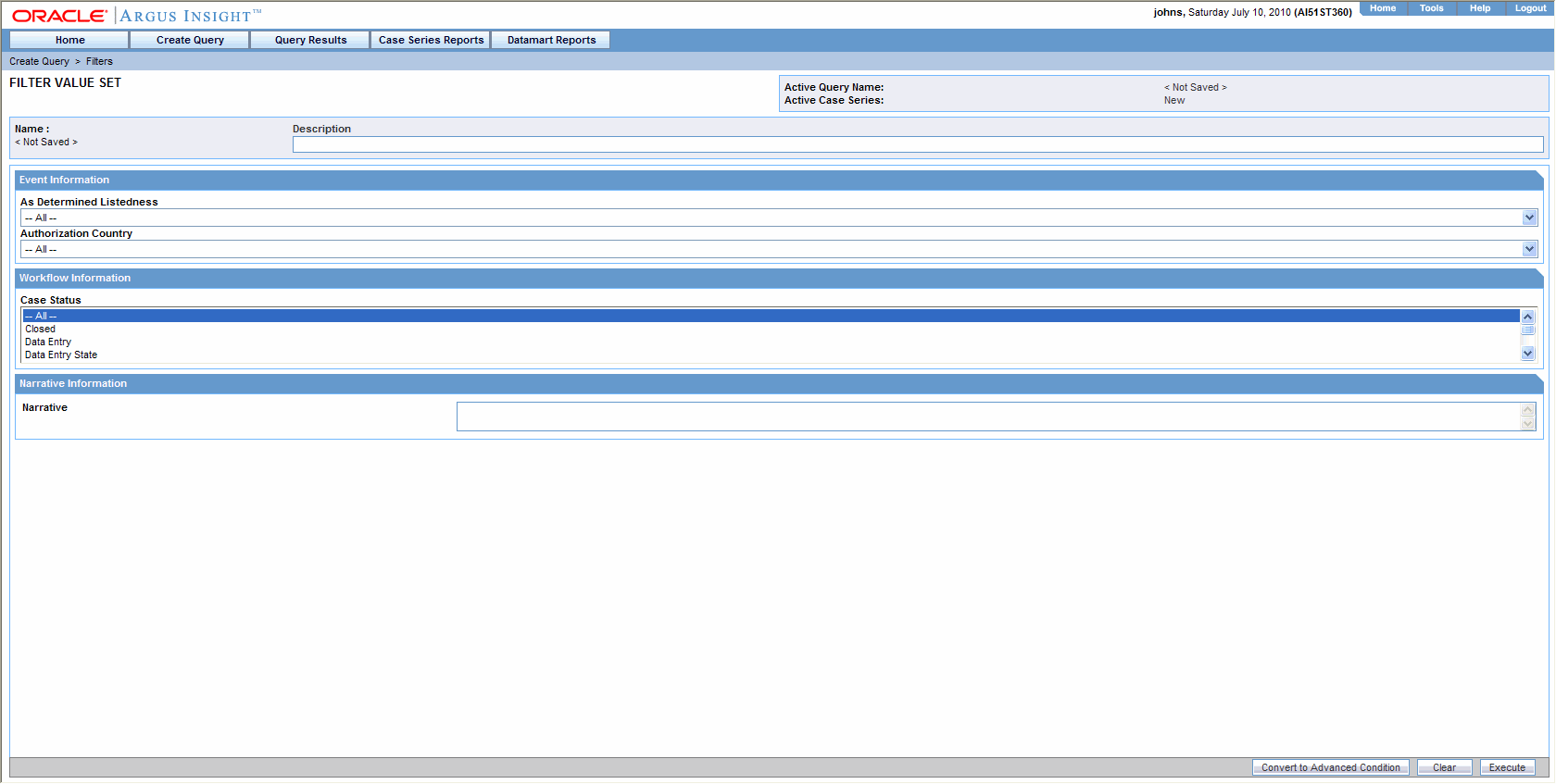
|
Note: In the Filter Value Set page, all the elements associated with the Filter are organized in sections. You need to scroll down the page to view all the sections. If you included the Advanced Condition element while creating your Filter in step 2, the Filter Value Set page displays an additional section Advanced Condition. You can use the options in this section to create an Advanced Condition and integrate your Value Set with it. See theIntegrating a Value Set with an Advanced Condition topic for details. You can also convert the entire Value Set to an Advance Condition. The Converting a Value Set to an Advanced Condition topic explains how to do this. |
Specify values for the Filter elements. See step 2 in the Using Predefined Filters topic for details.
Examine the Value Set result.
Click Execute. While the system searches for matching cases, the following dialog box is displayed.

|
Note: You may cancel the query execution at this point and return to the Filter Value Set page by clicking Cancel Query in the dialog box above. |
If the system does not find any cases that match the querying criteria, the following dialog box is displayed. Click OK in this dialog box to return to the Value Set form, modify the criteria, and execute the Value Set again.

If the system finds cases that match the query criteria, a list of such cases is displayed in the Active Case Series page.

Examine the Case Series. If the Case Series is too large, you may want to add additional elements to the Filter or modify the Value Set. Alternatively, if you find the Case Series to be appropriate, you can save the Value Set to the system.
To return to the Filter Value Set page, click View Query in the Active Case Series page. The Filter Value Set page appears.

If required, modify the Value Set and examine the result again or proceed to save the Value Set.
Save the Value Set to the system.
Type a description of the Value Set in the Description text box. For example, you can describe the type of cases the Value Set retrieves.
Click Save Values. The Save Value Set dialog box appears.

Type the name of the Value Set in the Name text box.
|
Note: The name cannot contain any of the following: % " ' ^ ~,;|#` |
Click OK. The system refreshes the Filter Value Set page. Two new buttons appear at the bottom of the page: Save Values As and Permissions.
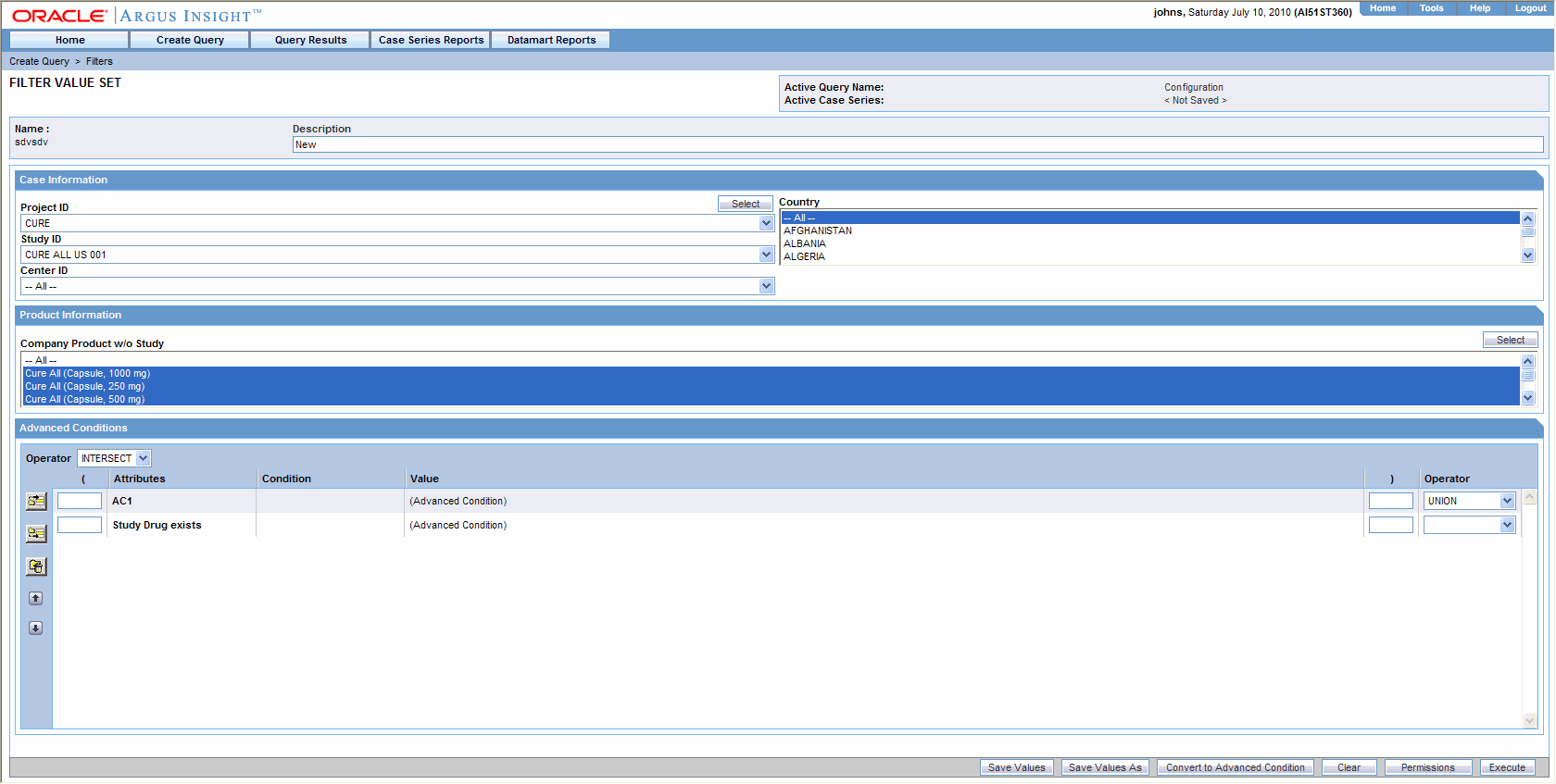
|
Note: The Filter Library page displays the custom as well as predefined Filters and their Values Sets in a control tree format. From this page you can select a Value Set and directly execute it. See theWorking with Saved Filters and Value Sets topic for more information on the Filter Library page. The saved Filters also appear in the Select Filter for New Value Set dialog box from where you can select the desired filter, enter values in the New Value Set page and execute. See the Using Predefined Filters topic for more information. |
|
Tip: If you make modifications to the field values after you have saved the Values Set to the system, use the Save Values button to save the changed field values. To save the Value Set by another name, use the Save Values As button.To clear all the field values in the Filter Value Set page, click Clear. |
Assign group-level permissions on the saved Value Set.
Click the Permissions button. The Permissions dialog box appears. A list in this dialog box displays the names of all the groups (except the Administrator group) that the system administrator has created.

Use the list box next to a group name to assign permissions to the group members on the Value Set you have created. You can select from these options:
| Permission | Description |
| No Access (Default) | No group members will be able to access the Value Set |
| R | Group members will be able to only view the Value Set |
| R/W | Group members will be able to view and modify the Value Set |
| R/W/D | Group members will be able to view, modify, and delete the Value Set |
| R/W/D/P | Group members will be able to view, modify, delete, and assign permission on the Value Set |
|
Note: The author of the Value Set always has the highest level of permission (R/W/D/P) on it. |
Click OK. The system saves the permission settings.
Click Execute. The system retrieves the list of cases that match the Value Set criteria and displays it in the Active Case Series page. After generating the Case Series, you can manually modify it or save it. See theCase Serieschapter for more information on working with Case Series.
This topic explains how to view the Value Set you last modified or executed.
The system assigns the Active status to a Value Set when you save modifications to it or execute it. Unless you save the modifications to another Value Set or execute it, the last Value Set you modified or executed remains Active. This is helpful in situations when you want to access a frequently used Value Set.
Use the following procedure to view an Active Value Set,
Select Create Query > Filters > Active. The Filter Value Set page displays the Value Set you executed or modified last.

If the Value Set was saved to the system before executing, the name of the Value Set appears next to Name label. In addition, the name of the Filter appears next to the Active Query Name label.
However, if the Value Set was not saved to the system before executing, the text <Not Saved> is displayed next to the Name label.
From the Active Filter Value Set page, you can perform the following tasks:
| Task | Description |
|---|---|
| Modify the Active Value Set | If required, you can modify the Value Set by changing the field values.
While entering field values, if you wish to clear all the values you entered, click the Clear button. Use the Save Values button to save the changed field values. This button is only available for a saved Value Set. |
| Save the Active Values Set by another name | Click Save Values As to save the Active Value Set by a different name.
The Value Sets you save to the system are listed in the Filters Library page. TheWorking with Saved Value Setstopic explains how to work with saved Value Sets. |
| Convert Active Value Set to Advanced Condition | Click Convert to Advanced Condition to convert the Active Values Set to an Advanced Condition. TheConverting a Value Set to an Advanced Conditiontopic explains how to do this. |
| Assign Permissions on the Active Value Set | Click Permissions to set the group-level access permissions.
The Permissions button is only available for saved Value Sets. |
| Change the Description of the Active Value Set | You can change the description of the Active Value Set by modifying the text displayed in the Description text box.
Click Save Values to store the changed description. |
| Execute the Active Value Set | Click Execute to generate a Case Series by using the Active Value Set. |
|
Note: When the field values for an Active Values Set are modified or the Active Value Set is saved by a different name, the changes in the Active Value Set reflect the most recent changes. The Active Value Set also changes in case you modify the field values and execute the Value Set without saving the modifications. |
The Filter Library page lists all the predefined as well as saved custom Filters and their Value Sets in a control tree format. To access this page, select Create Query > Filters > Library.

To view the Values Sets associated with a Filter, expand the control tree for a Filter. The saved Value Sets are displayed below each Filter.
The descriptions of the columns in the Filter Library page follow.
| Column | Description |
|---|---|
| Name | Displays the name of the Filters and Value Sets |
| Description | Displays the description of the Filters and Value Sets |
| Last Modified | Displays the date when the Filters/Value Set was last modified |
| User Full Name | Displays the name of the user who created the Filter/Value Set |
| Category | Displays the Filter category |
| Value Set | Displays the number of Value Sets created for a Filter |
| Report | The report icon indicates that a report is associated with a Value Set
See theAssociating a Value Set with a Reportsection below for more information |
Use the following procedure to search for a saved Filter or Value Set.
Specify the search criteria, as appropriate:
To search for a Filter/Value Set by its name, type the Filter/Value Set name in the Name text box.
To search for a Filter/Value Set by its description, type the first few words of the description in the Description text box. The system searches for the specified search string in all Filter/Value Set descriptions.
To search for a Filter/Value Set by its date of modification, enter the modification date in the first Last Modified date field. You can also specify a date range by typing the start and end dates in the first and second date fields, respectively.
To search a Filter/Value Set by its author, select the author name from the User Full Name list box.
To search for a Filter by its category, select the category from the Category list box.
Click Search. Based on your search criteria, the system displays the search result in a list.
You can sort the search result list by clicking the sort icon next to the column headers in the list.
Click the New Filter button in the Filter Library page. See theCreating Custom Filterstopic for details.
Instead of selecting Create Query > Filters > New Values Set to create a new Value Set, you can click the New Value Set button in the Filter Library page. You can create Value Sets for predefined as well as custom Filters by using this method. See theUsing Predefined Filterstopic for details.
Use the following procedure to modify a Filter or Value Set.
Select the Value Set or the Filter from the list in the Filter Library page.
Click Modify. If you selected a Filter, the Filter Elements page appears. If you selected a Value Set, the Filter Value Set page appears.
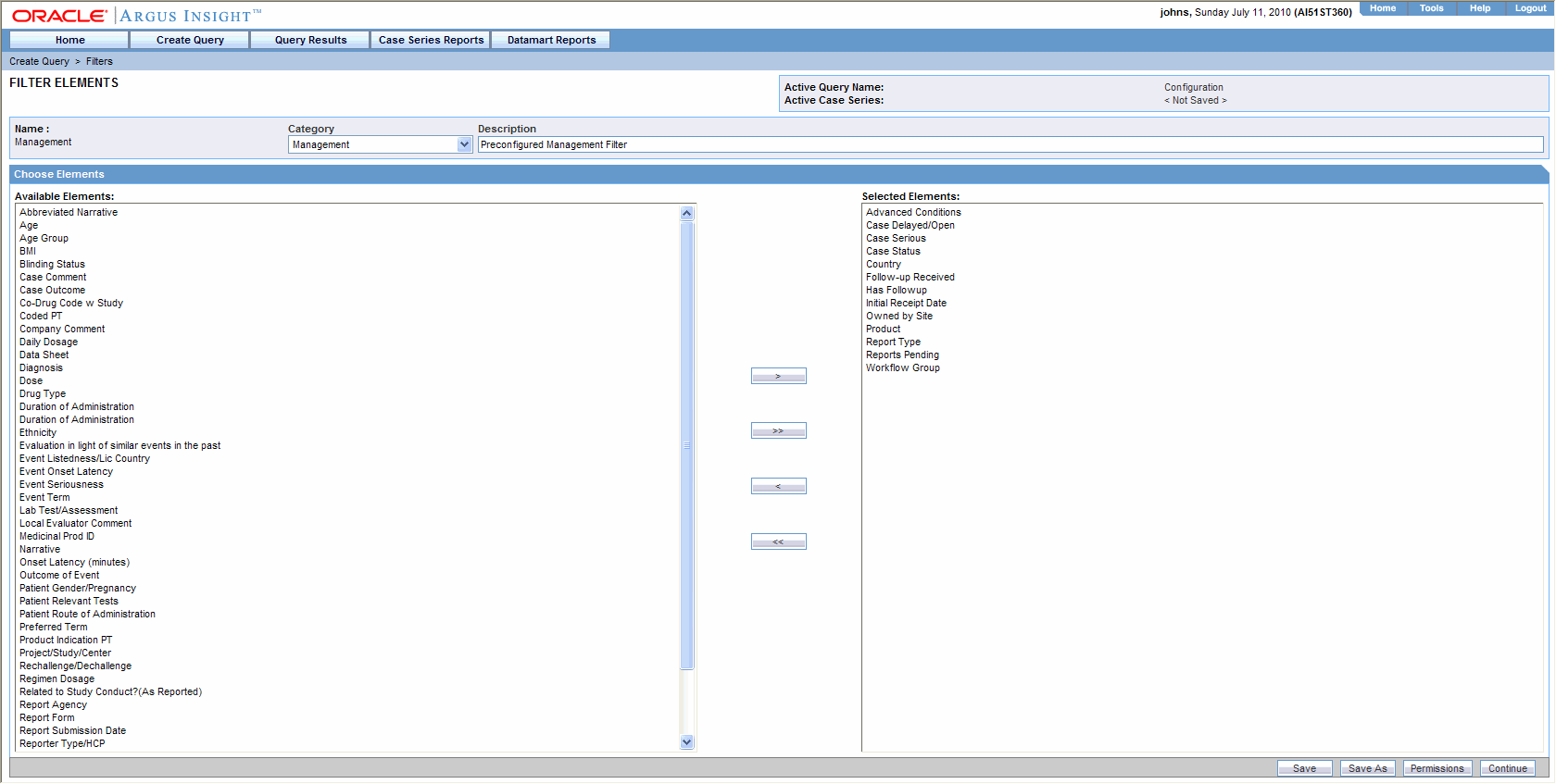
Make your modifications to the Filter or Value Set, as appropriate.
Click Save to save the modifications you made in the Filter Elements page. If you modified a Value Set, click Save Values in the Filter Value Set page to save the changes.
You can delete the Value Sets for predefined as well as custom Filters. You can also delete custom Filters. However, you cannot delete the predefined Filters. When you delete a Filter, all its associated Value Sets are also deleted.
Use the following procedure to delete a Value Set or a custom Filter.
Select the Value Set or the custom Filter from the list in the Filter Library page.
Click Delete. The delete confirmation dialog box appears.
Click OK. The system deletes the selected Filter/Value Set; the Filter Library page appears.
Argus Insight lets you associate a Value Set to a particular Standard Report and schedule a time when the report needs to be generated and sent to another user through email. This is helpful in situations when you need to generate the latest Case Series and run a report on it each time the datamart is refreshed. Instead of manually executing the Value Set to generate the latest Case Series and running the report, you can use the report association functionality of Argus Insight.
|
Note: The user who is scheduling reports should have an enterprise login configured in Cognos to schedule the report. |
Use the following procedure to associate a Value Set with a Standard Report:
In the Filter Library page, select the Value Set that you wish to associate with a Standard Report.
Associate the Value Set with a Standard Report.
Click Associate. The Scheduled Reports Group dialog box appears. This page displays a list of all groups of reports which were scheduled or associated with the query.
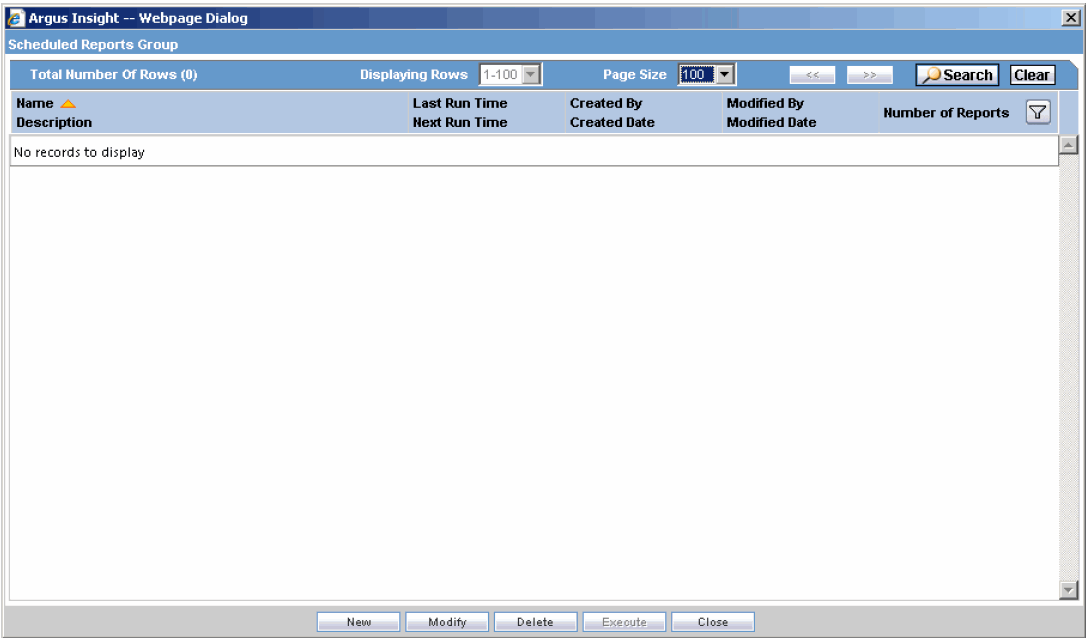
Click New and a context menu appears. Select Scheduling.

The Reports Scheduling window appears.

On this window, you can schedule multiple reports at once.
Schedule the report.
This window has 3 main sections:
Scheduling Information - The Schedule timing and E-Mail information.
Available Reports - All the available reports in the system that can be scheduled.
Selected Reports - These reports are scheduled.
Provide a Name for your reports group along with description.
Use the Frequency list box to specify how often you wish to have the system run the selected QBE and generate the selected report. The options available are: Once, Daily, Weekly, Monthly, Quarterly, and Yearly.
Specify the schedule time in the Time field.
Based on the option you selected in the step above, specify the instant when you want the report generated as described in the table below.
| Frequency Option Selected | Additional Scheduling Information to Specify |
|---|---|
| Once | In the Date text box that appears, enter the date when you want to have the report generated. |
| Daily | In the Time text box that appears, enter the time when you want to have the report generated. The time must be entered in the HH:MM AM/PM format. Hours should be between 1 and 12. |
| Weekly | From the Day of Week option button group that appears, select the day of week on which you want to have the report generated. Also, specify the time in the Time text box. |
| Monthly | Use the Day list box to select the day of the month on which you want to have the report generated. Also, specify the time in the Time text box. |
| Quarterly | Quarterly reports are generated on the first day of the quarter. In the Time text box, enter the time when you want to have the report generated on the first day of the quarter. |
| Yearly | In the Date and Time text boxes, specify the date and time when you want to have the yearly report generated. |
Specify the email recipients of the report you scheduled.
In the Email Address text box, type the email address of the report recipient. If there are multiple recipients, use a semicolon to separate their email addresses.
Type the subject line in the Subject text box.
Type the email body text in the Body text box.
If you want all the reports in a single mail, leave the Send separate mail for each report checkbox unchecked. If you check this checkbox, each report is delivered in a separate mail to the user.
From the Available reports grid, select a report and click Add button. The report will be selected and will appear in the Selected Reports section.
To remove a report from Selected Reports, click the X button against the report. When you click the selected report(s) in this section, its corresponding prompts are loaded in the right pane.
Enter the sub-title for the report pre-filter in the right pane and click OK.
Click OK in the Reports Scheduling window.
Click OK. The system associates the Value Set with the selected report and saves the scheduling information; the FilterLibrary page appears. The icon displayed in the Associated Report column indicates that the Value Set is associated with a report.

|
Note: Refer to the Associated Library and Query Library sections in the Library chapter, to view the steps on how to disassociate reports in those libraries. |
Use the following procedure to execute a Value Set.
Select a Value Set from the list in the Filter Library page.
Click Execute. The system executes the Value Set; the Active Case Series page appears.

If a report is associated with the saved QBE, click Execute. The Active Case Series page and Pre Filter page of the associated report is displayed.
Enter the prompts value in the Pre Filter page.
Click on the Execute button to generate the report.
After generating the Case Series, you can manually modify it or save it. See the Case Series chapter for more information on working with Case Series.
Just as the system assigns the Active status to a Value Set when you save modifications to it or execute it, the last saved or generated Case Series becomes the Active Case Series.
Use the following procedure to narrow down the list of cases in the Active Case Series, you may want to run a Value Set on an Active Case Series.
Generate the Case Series on which you wish to run another Value Set:
You can generate the Case Series by Using Predefined Filters or Creating Custom Filters and executing a Value Set. This Case Series automatically becomes the Active Case Series and remains so until you execute another query to generate a different Case Series.
Alternatively, if the Case Series on which you wish to run another Value Set is already saved in the system, select Query Results > Case Series > Case Series Library. In the Case Series Library page that appears, select the Case Series title and click Make Active.
Select Create Query > Filters > Library. The Filter Library page appears.
Select the Value Set you want to run on the Active Case Series you generated in step 1.
Check the Limit Query to Active Case Series checkbox.
Click Execute. The system runs the selected Value Set on the Active Case Series and displays the Active Case Series page. Note that the Case Series you just generated becomes the Active Case Series.
Advanced Conditions let you create complex queries that involve Boolean and Set operations among various fields. In Argus Insight, Advanced Conditions are created in the Advanced Conditions editor, which employs a spreadsheet-like approach for adding query conditions (fields and their values) and conditional operators (Boolean or Set).
In Argus Insight, Filters are integrated with Advanced Conditions to let you perform the following tasks.
Converting a Value Set to an Advanced Condition
Integrating a Value Set with an Advanced Condition
A Filter Value Set can be used to start an Advanced Condition that employs Set or Boolean operations between elements that have multiple values. When you convert a Value Set to an Advanced Condition, al its fields are listed in the Active Advanced Conditions Editor page as Advanced Condition attributes.
Use the following procedure to convert a Value Set to an Advanced Condition
Create a new Value Set by either Using Predefined Filters or Creating Custom Filters. Alternatively, open a saved Value Set from the Filters Library page (seeWorking with Saved Value Sets).
Verify the field values you specified in the various fields in the Value Set.
Click the Convert to Advanced Condition button. The Active Advanced Condition Editor page appears; all the fields in which you specified values in the QBE form are listed as Advanced Condition attributes. The fields in which you selected multiple values are repeated.

In the Advanced Condition editor, you can build your query further by:
Adding additional attributes (fields) and specifying their values
Adding another Advanced Condition as an attribute
Placing runtime parameters in attributes
Placing parentheses to determine the query execution order
Specifying conditions for attributes values
Specifying Set and Boolean operators to join the various attributes
See theAdvanced Conditionssection for detailed information on building Advanced Conditions by using the options in the Advanced Condition editor.
Argus Insight lets you integrate a Value Set with an existing Advanced Condition through these Set operators: Intersect, Minus, or Union. If required, you can integrate a Value Set with multiple Advanced Conditions. The multiple Advanced Conditions can have Set or Boolean operations between them.
|
Note: Only those Value Sets that have the Advanced Condition element can be integrated with Advanced Conditions. All Value Sets that you create for predefined Filters contain the Advanced Condition element. If you wish to convert a customFilter Value Set to an Advanced Condition, make sure you select the Advanced Condition element while creating the custom Filter. |
Use the following procedure to integrate a Value Set with existing Advanced Conditions.
Create a new Value Set by eitherUsing Predefined FiltersorCreating Custom Filters. Alternatively, open a saved Value Set from the Filters Library page (seeWorking with Saved Value Sets). If you create a custom Value Set, make sure you include the Advance Condition element.
In the Filter Value Set page, verify the field values you specified you specified for the Value Set.
Scroll down to the Advanced Condition section in the Filter Value Set page.
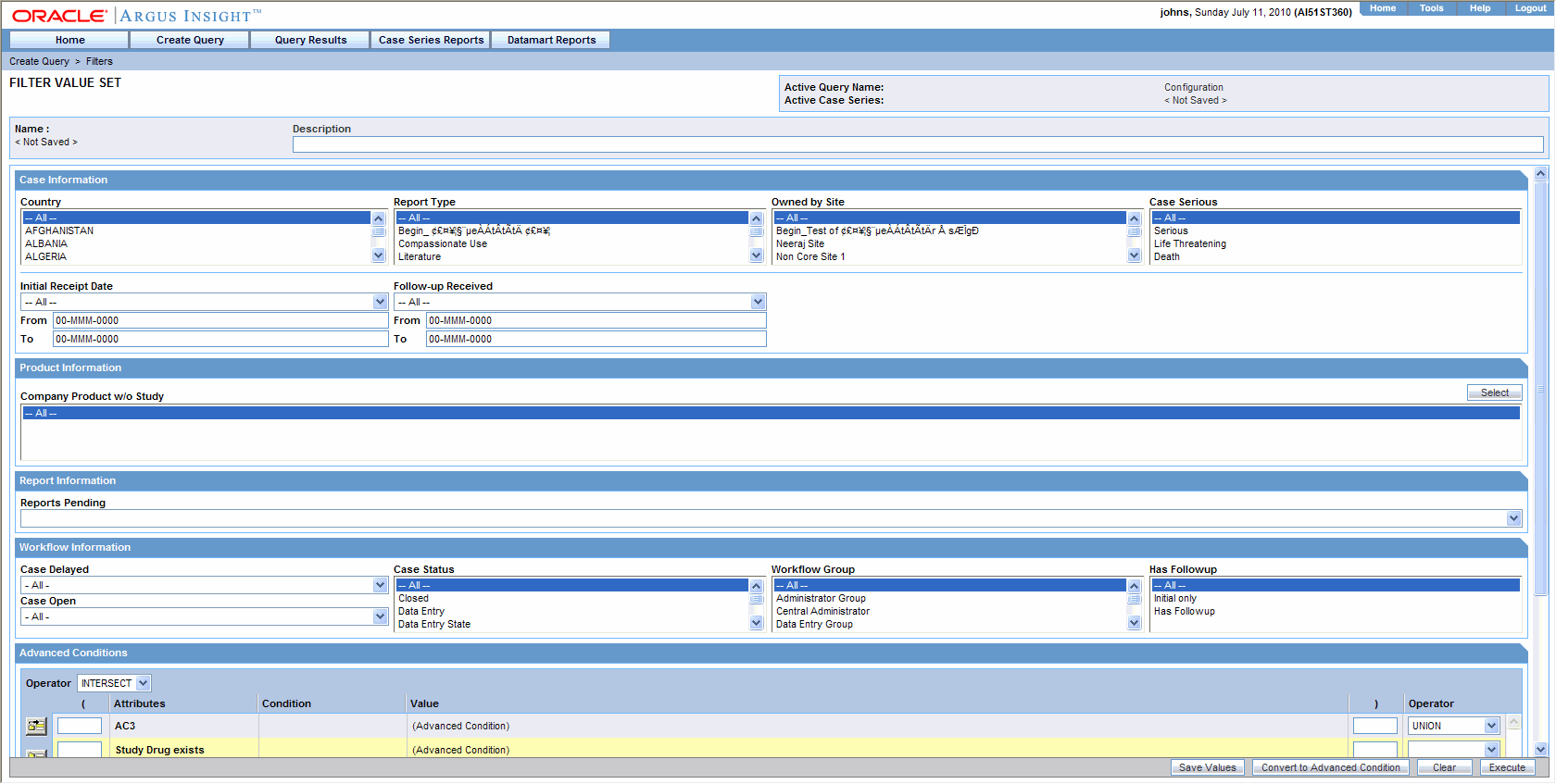
Use the Operator list box to specify the Set operator you want to use to integrate the Values Set and the Advanced Condition. You can select one of these options: Intersect, Minus, Union.
Select the Advance Condition you want to integrate with the QBE.
Click the context menu icon. A context menu appears. In the context menu, all the Advanced Conditions stored in the system are organized by categories.

In the context menu, browse to the appropriate category and select the required Advanced Condition. The selected Advanced Condition appears as a row in the Advanced Condition editor.
If required, add other Advanced Conditions. Click the icon to insert another Advanced Condition above the existing Advanced Condition. Click the icon to insert another Advanced Condition below the existing Advanced Condition.
|
Tip: You can change the structure of thequery by changing order of rows in the editor. To do this, select a row and click the arrow button to move the row up or down. |
Type parentheses in the ( and ) columns to determine the order of execution for the selected Advanced Conditions.
Use the list box in the Operator column to specify the operators between the selected Advanced Conditions. You can select from these options: AND, OR, Intersect, Minus, and Union.
|
Note: See theAdvanced Conditions chapter for detailed information on creating Advanced Conditions by using the options in the Advanced Condition editor. |
Save the integrated query by clicking Save As.
|
Note: You can convert the integrated Value Set and Advanced Condition into a single Advanced Condition by clicking Convert to AdvancedCondition. SeeConverting a Value Set to an Advanced Condition for details. |
Click Execute to run the integrated Value Set and generate the Case Series. The Active Case Series page appears; the Case Series is displayed. See theCase Serieschapter for more information on working with Case Series.
The Advanced Conditions querying tool is designed to allow the greatest flexibility in designing the most advanced queries. Argus Insight users can use Advanced Conditions to create complex queries that involve Boolean and Set operations using Structured Query Language (SQL).
|
Note: The Advanced Conditions field labels are displayed as per the field labels configured in Argus. |
In Argus Insight, Advanced Conditions are created in the Advanced Conditions editor, which employs a spreadsheet-like approach for adding query conditions (fields and their values) and conditional operators (Boolean or Set).
Refer to the following topics for more information on working with Advanced Conditions.
Creating a New Advanced Condition
Working with the Last Modified or Saved Advanced Condition
Working with Saved Advanced Conditions
This topic explains how to:
Start a new Advanced Condition
Use the Advanced Condition Editor options to build your Advanced Condition
Generate a Case Series by executing the Advanced Condition
Use the following procedure to start a new advanced condition.
Start the new Advanced Condition. Select Create Query > Advanced Conditions > New. The Advanced Conditions Editor page appears.

|
Note: You can also start an Advanced Condition by converting a Advanced Condition or a Filter Value Set to Advanced Condition. See these topics for details: Converting a Advanced Condition to an Advanced Condition and Converting a Value Set to an Advanced Condition. |
Enter the Advanced Condition attributes (fields and values)
Click the context menu icon. A context menu appears. In the context menu, the first seven categories (Activities, Additional Info, Analysis, Events, General, Patients, and Products) represent the Argus case form tabs. In these categories, the various datamart fields that pertain to case information are organized in this hierarchy: Argus case form tab > sections within the tab page > Fields within the section. You can browse through the appropriate hierarchy and select the required field as an Advanced Condition attribute.
The eighth category Reports contains attributes that pertain to the reporting information of a case. You can browse through the Reports category and select the required Advanced Condition attribute.
The ninth category AC Library lists all the Advanced Conditions stored in the system. You can browse through the AC Library category and select a stored Advanced Condition as an attribute for the new Advanced Condition.
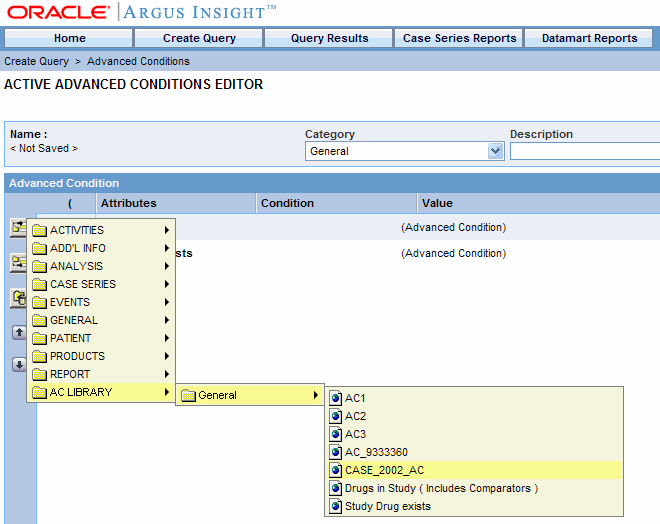
Browse through the appropriate category hierarchy and select the required attribute. The selected attribute appears as a row in the editor.
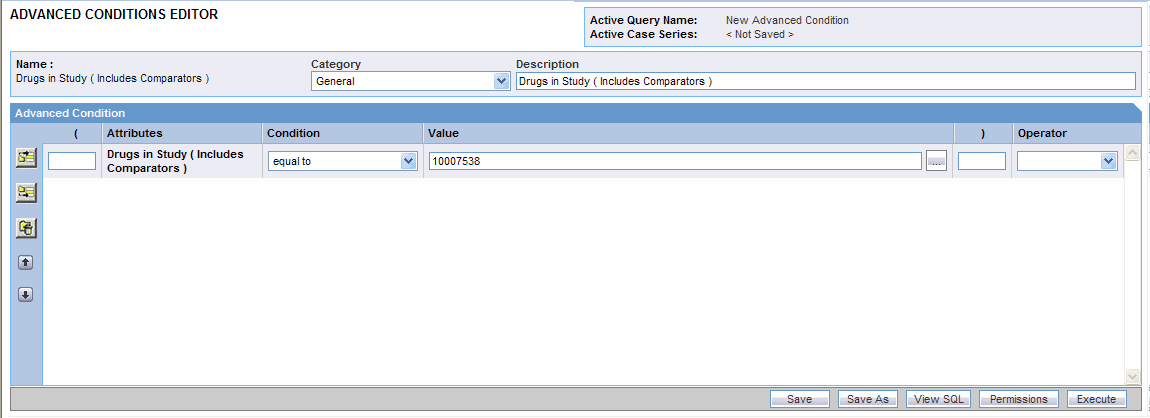
|
Note: The user defined fields in Argus which have been converted as a look up are also available as attributes for the advanced condition search. |
In the Value field, enter the value for the selected attribute. Depending on the type of attribute you selected, the system lets you populate the Value field by using a:
List box to select from a set of predefined values
Text box to enter text strings or numerals
Date field to enter dates
Browser to select MedDRA dictionary terms, company products, WHO drugs, clinical study IDs, Drugs in Study (incl. Comparators) and Investigational Drugs.
Use the following procedure to use a Browser to populate the Value field, click the ellipsis button next to the Value field; in the context menu that appears, select the option corresponding to the browser name to launch the browser.
|
Note: The MedDRA browser for Create Query > Advanced Conditions tab, can be called for search criteria based on specific terms. The search criteria can be based on the specific term codes or descriptions depending on your requirement. Refer to the followingexample for more information.
|
Specify the condition for the attribute value. Use the Conditions list box to specify a condition as explained below:
| equal to - select this option if you want to retrieve cases where the selected attribute's value is equal to what the Value field specifies | not equal to - select this option if you want to retrieve cases where the selected attribute's value is not equal to what the Value field specifies |
| greater than - select this option if you want to retrieve cases where the selected attribute's value is greater than what the Value field specifies | greater than or equal to - select this option if you want to retrieve cases where the selected attribute's value is greater than or equal to what the Value field specifies |
| less than - select this option if you want to retrieve cases where the selected attribute's value is less than what the Value field specifies | ess than or equal to - select this option if you want to retrieve cases where the selected attribute's value is less than or equal to the Value that the field specifies |
| missing - select this option if you want to retrieve cases where the selected attribute's value has not been specified | exists - select this option if you want to retrieve cases where the selected attribute has any value |
| begins with - select this option if you want to retrieve cases where the selected attribute's value begins with what the Value field specifies | contains - select this option if you want to retrieve cases where the selected attribute's value contains what the Value field specifies |
| does not contain - select this option if you want to retrieve cases where the selected attribute's value does not contain what the Value field specifies | in - select this option if you want to retrieve cases where the selected attribute's value exists in what the Value field specifies |
| not in - select this option if you want to retrieve cases where the selected attribute's value does not exist in what the Value field specifies | Specify the operator. Use the Operator list box to specify the Boolean or Set operator through which you want to join the attribute with another attribute. |
| Add more attributes. Follow steps 2 through 4 to add more attributes to your Advanced Condition. Click the icons on the left bar to insert another attribute above or below the existing attribute. |
|
Tip: You can change the structure of the Advanced Condition query by changing the order of attribute rows in the editor. Use the following procedure to do this, select a row and click the Up or Down arrow buttons to move the row up or down. To delete a row from the editor, select the row and click the Delete icon. |
Specify runtime parameters, as appropriate.
|
Note: Argus Insight lets you create Advanced Conditions which when executed, ask for user-specified values for certain attributes to generate the Case Series. For example, you may create an Advanced Condition in which the Case Number or the Product name may be specified only at the time of execution. In this case, the Advanced Condition would only retrieve those cases where the Case Number/Product Name is as specified at the time of execution.Creating an Advanced Condition using same field name multiple times requires to change the Parameter name so that while executing the advanced condition different parameters values can be entered. |
Identify the attribute row where you want to specify runtime parameters.
Click the ellipsis button next to the Value field. A context menu appears.
Select the Parameters option.

Click Parameter. The following dialog box appears.
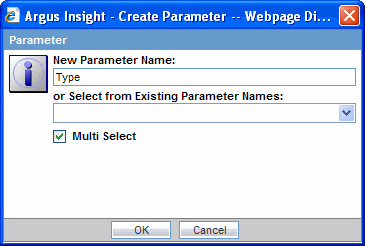
Check the Multi Select checkbox if you want to pass multiple runtime values for a single attribute. For example, you might want to pass more than one case number or product name as runtime parameters.
Click OK. The field you configured as a runtime parameter is displayed in the Value text box enclosed within % symbol. For example, %Product Type% If you configured the field to accept multiple runtime parameters, the field name appears in the Value text box enclosed within %% symbol. For example, %%Product Type%%.
Type parentheses in the ( and ) columns to determine the order of execution for the selected Advanced Conditions, as appropriate.
|
Note: Refer the Advanced Condition Creation Process section for further details on creating an Advanced Condition. |
Examine the Advanced Condition result.
Click Execute. While the system searches for matching cases, the following dialog box is displayed.

|
Tip: You may cancel the query execution at this point and return to the Advanced Condition Editor by clicking Cancel Query in the dialog box above. |
If you configured any runtime parameters, the Parameters dialog box appears. Specify the parameter values by using the options in the dialog box. Next, click Execute; the system retrieves the matching cases from the datamart and displays them in the Active Case Series page.
|
Tip: If you select one run-time parameter and execute the search, you must enter a field.If you select multiple run-time parameters and execute the search, you have the option to ignore the run-time parameters. |
If the system does not find any cases that match the querying criteria, the following screen is displayed. Click View Query in this screen to return to the Advanced Condition Editor, modify the criteria and execute again.

If the system finds cases that match the query criteria, a list of such cases is displayed in the Active Case Series page.

Examine the Case Series. If the Case Series is too large, you may want to modify the Advanced Condition by specifying additional attributes or changing values. Alternatively, if you find the Case Series to be appropriate, you can save the Advanced Condition to the system.
The system retrieves the matching cases from the datamart and displays them in the Active Case Series page.
Use the following procedure to return to the Advanced Condition Editor.
Click View Query in the Active Case Series page. The Active Advanced Condition Editor page appears.

|
Note: When you save the modifications to an Advanced Condition or execute it, the system assigns the Active status to the Advanced Condition. Therefore, when you return to the editor after executing the Advanced Condition, the page title changes to ActiveAdvanced Condition Editor. The field values you specified in the editor before executing are retained. See theWorking with the Last Modified or Saved Advanced Condition topic for details on Active Advanced Conditions. |
If required, modify the Advanced Condition and examine the result again or proceed to save the Advanced Condition.
Save the Advanced Condition.
Use the Category list box to assign a category to the Advanced Condition. A category indicates the reporting aspect to which your Advanced Condition pertains: Compliance, Configuration, General, Management, or Pharmacovigilance. Specifying the category also helps you in searching the relevant Advanced Conditions from a list of all the Advanced Conditions saved in the system.
Type a description of the Advanced Condition in the Description text box. For example, you can describe the type of cases the Advanced Condition retrieves.
Click Save in the Active Advanced Condition Editor page. The Save Advanced Condition dialog box appears.
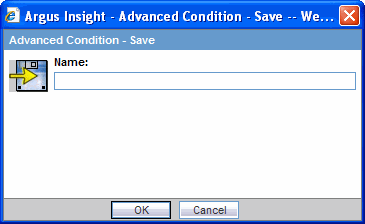
Type the name of the Advanced Condition in the Name text box.
Click OK. The system refreshes the Active Advanced Condition Editor page. Note that the following new elements appear on the page.
The Active Query Name field in the upper-right corner of the page now displays the name of the Advanced Condition you specified while saving the Advanced Condition.
Three new buttons appear at the bottom of the page: Save As, View SQL and Permissions.
|
Note: All the Advanced Conditions that you save to the system are listed in the Advanced Condition Library page. TheWorking with Saved Advanced Conditions topic explains how to work with saved Advanced Conditions |
|
Tip: If you modify the field values after saving the Advanced Condition to the system, use the Save button to save the changed field values. |
Click View SQL to view the underlying SQL query for the Advanced Condition.
View SQL helps you to view and edit the underlying SQL for the Advanced Condition created.
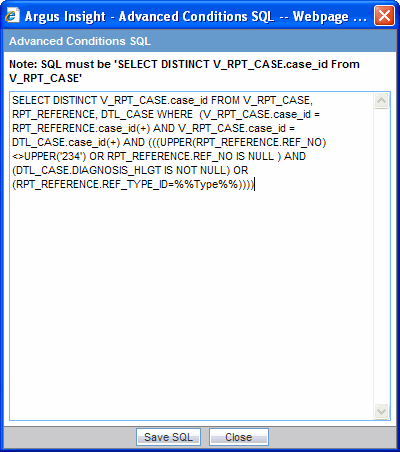
Click Save SQL after editing the query.
|
Note: When using this Save SQL functionality the Advanced Condition can be executed only from the Advanced Conditions library and the Query Library page.The View SQL textbox can have a maximum of 4000 characters. |
|
Tip: Revert to Original helps you to revert back to the original advanced condition. |
Click Close.
Assign group-level permissions on the saved Advanced Condition.
Click the Permissions button. The Permissions dialog box appears. A list in this dialog box displays the names of all the groups (except the Administrator group) that the system administrator has created.
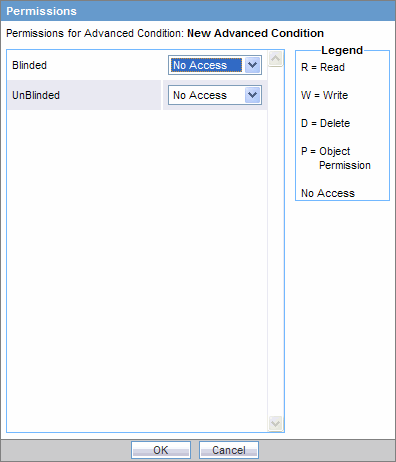
Use the list box next to a group name to assign permissions to the group members on the Advanced Condition you have created. You can select from these options:
| Permission | Description |
| No Access (Default) | No group members will be able to access the Advanced Condition |
| R | Group members will be able to only view the Advanced Condition |
| R/W | Group members will be able to view and modify the Advanced Condition |
| R/W/D | Group members will be able to view, modify, and delete the Advanced Condition |
| R/W/D/P | Group members will be able to view, modify, delete, and assign permission on the Advanced Condition |
|
Note: The author of the query always has the highest level of permission (R/W/D/P) on the query. For example, you belong to the Data Entry group and you assign the No Access permission level to the Data Entry group on a Advanced Condition that you create. In this case, while you will continue to have the highest level of permission on your Advanced Condition, other members in your group will not be able to access your Advanced Condition. |
Click OK. The system saves the permission settings.
Click Execute to generate the Case Series.
The system retrieves the matching cases from the datamart and displays them in the Active Case Series page.
If you configured any runtime parameters, the Parameters dialog box appears. Specify the parameter values by using the options in the dialog box. Next, click Execute; the system retrieves the matching cases from the datamart and displays them in the Active Case Series page. See the Case Series chapter for more information on working with Case Series.
Use the following Order of precedence for the various operators selected when creating an Advance Condition.
| Order | Operator | Use |
| 1 | And | Use with all fields available in Advanced Condition. |
| 2 | Or | Use with all fields available in Advanced Condition. |
| 3 | Intersect | Use between various queries (AC Library Attributes) |
| 4 | Minus | Use between various queries (AC Library Attributes) |
| 5 | Union | Use between various queries (AC Library Attributes) |
Using an Intersect, Minus or Union operator results in the creation of two separate select clauses. Therefore, use these operators between different queries.
PL/SQL syntax should be kept in mind while creating an Advanced Condition.
PL/SQL syntax:
SELECT
table1.common_column
FROM
Table1, table2, table3
WHERE
Table1.column2 = table2.column2
AND
Table2.column3 = table3.column3
INTERSECT
SELECT
Table4.common_column
FROM
Table4, table5, table6
WHERE
Table4.column2 = table5.column2
AND
Table5.column3 = table6.column3
Now suppose you want to create an Advanced Condition as follows:
Where country = "Australia" AND Co-Drug Code w Study = "LAS+TAB" OR Co-Drug Code w Study = "LAS+" AND Overdose = "Yes" AND Interaction? = "Yes"
And wants to intersect the results of this Advanced Condition with the existing Advanced Condition
Where country = "United States" or country = "Australia"
Then you should create the Advanced Condition as shown in the screen shot below.
The user needs not to take care of parenthesis if the PL/SQL syntax and the order and precedence of operators are taken care off.
The following SQL will get generated in this case.
SELECT DISTINCTv_rpt_case.case_id
FROM v_rpt_case, rpt_product
WHERE v_rpt_case.case_id = rpt_product.case_id
AND ( (v_rpt_case.country_id = 13)
AND ( UPPER (rpt_product.co_drug_code) = 'LAS+TAB'
OR (pat_exposure IN (
SELECT product_id
FROM lm_product
WHERE UPPER (lm_product.drug_code) ='LAS+TAB')))
OR(UPPER (rpt_product.co_drug_code) = 'LAS+'
OR (pat_exposure IN (SELECT product_id FROM lm_product
WHERE UPPER (lm_product.drug_code) ='LAS+')))
AND (rpt_product.is_overdose = 1)
AND (rpt_product.interaction = 1))
INTERSECT
SELECT DISTINCTv_rpt_case.case_id
FROM v_rpt_case
WHERE v_rpt_case.case_id IN (
SELECT DISTINCT v_rpt_case.case_id
FROM v_rpt_case
WHERE (v_rpt_case.country_id = 13)
OR (v_rpt_case.country_id = 223))
The system assigns an Active status to a Advanced Condition when you modify and save it or when you execute it. Unless you save the modifications to another Advanced Condition or execute another Advanced Condition, the last Advanced Condition you modified or executed remains Active. This is helpful in situations when you want to access a frequently used Advanced Condition.
Use the following procedure to view an active Advanced Condition,
Select Create Query > Advanced Condition > Active. The Active Advanced Conditions Editor page displays the Advanced Condition you executed or modified last.

If the Active Advanced Condition was saved to the system before executing, the name of the Advanced Condition appears next to the Active Query Name and Name label. However, if the Active Advanced Condition was not saved to the system before executing, the text <Not Saved> is displayed next to the Active Query Name label.
From the Active Advanced Condition page, you can perform the following tasks:
| Task | Description |
|---|---|
| Modify the attributes in the Advanced Condition editor | If required, you can modify the attributes (fields and values) in the Advanced Condition editor. See theCreating a New Advanced Conditiontopic for information on working with the Advanced Condition editor.
Use the Save button to save the changed field values. This button is only available for a saved Active Advanced Condition. |
| Save Active Advanced Condition with another name | Click Save As to save the Active Advanced Condition by a different name.
The Advanced Conditions that you save to the system are listed in the Advanced Condition Library page. TheWorking with Saved Advanced Conditionstopic explains how to work with saved Advanced Conditions. |
| View the Advanced Condition in SQL | Click View SQL to view the underlying SQL query for the Advanced Condition.
In this SQL, manually replace the V_RPT_CASE with RPT_CASE. This is required to execute the query in the Oracle database. |
| Assign Permissions | Click Permissions to set the group-level access permissions on the Advanced Condition. See theCreating a New Advanced Conditiontopic for information on setting permissions.
The Permissions button is only available for saved Active Advanced Conditions. |
| Change the Description of the Active Advanced Condition | You can change the description of the Active Advanced Condition by modifying the text displayed in the Description text box.
Click Save to store the changed description. |
| Execute the Active Advanced Condition | Click Execute to generate a Case Series by using the Active Advanced Condition. |
Note that modifying the field values in the Advanced Condition editor for an Active Advanced Condition or saving the Active Advanced Condition by a different name changes the Active Advanced Condition to reflect the most recent changes. The Active Advanced Condition also changes in case you modify the field values in the Advanced Condition editor and execute the Advanced Condition without saving the modifications.
The Advanced ConditionsLibrary page lists all of the Advanced Conditions saved to the system. To access this page, select Create Query > Advanced Conditions > Library.
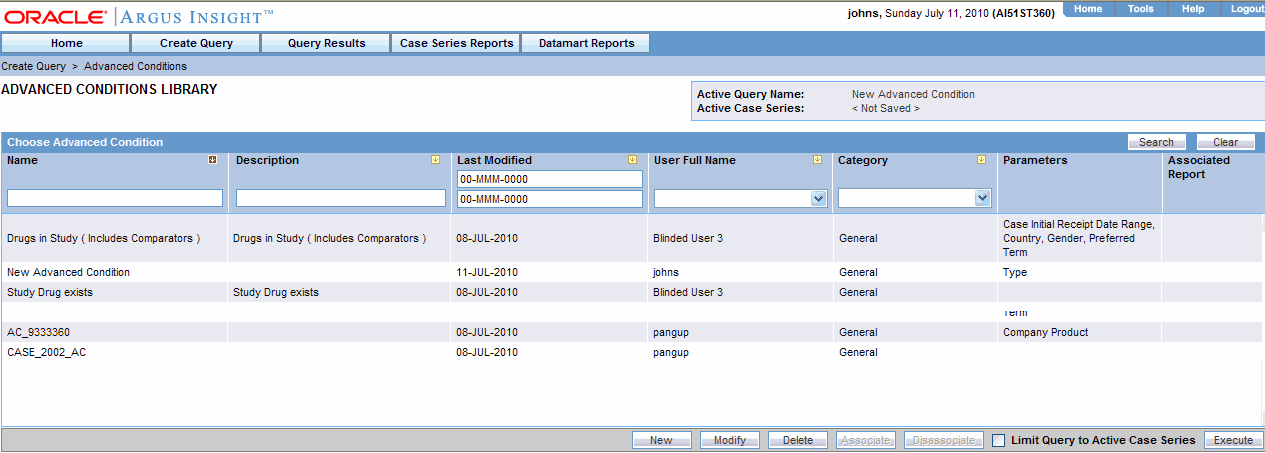
The Advanced Condition Library page displays a list of the saved Advanced Conditions in a grid format. The descriptions of the grid columns follow.
| Column | Description |
| Name | Displays the name of the Advanced Condition |
| Description | Displays the Advanced Condition description |
| Last Modified | Displays the date when the Advanced Condition was last modified |
| User Full Name | Displays the name of the user who created the Advanced Condition |
| Category | Displays the category assigned to the Advanced Condition |
| Parameters | Displays the name of fields for which a runtime parameters need to be specified while executing the Advanced Condition |
| Report | The icon indicates that a report is associated with the Advanced Condition
See theAssociating an Advanced Condition with a Reportsection below for more information. |
Use the following procedure to search for a saved Advanced Condition:
Specify the search criteria, as appropriate:
To search for an Advanced Condition by its name, type the Advanced Condition name in the Name text box.
To search for an Advanced Condition by its description, type the first few words of the description in the Description text box. The system searches for the specified search string in all Advanced Condition descriptions.
To search for an Advanced Condition by its date of modification, enter the modification date in the first Last Modified date field. You can also specify a date range by typing the start and end dates in the first and second date fields, respectively.
To search for an Advanced Condition by its author, select the author name from the User Full Name list box.
To search for an Advanced Condition by its category, select the category from the Category list box.
Click Search.
Based on your search criteria, the system displays the search result in a list.
You can sort the search result list by clicking the sort icon next to the column headers in the list.
To clear the search result and display all the Advanced Conditions in the list, click the Clear button.
Use the following procedure to create a new Advanced Condition.
Click the New button in the Advanced Condition Library page.
See theCreating a New Advanced Condition topic for details.
Use the following procedure to modify an Advanced Condition:
Select the Advanced Condition from the list in the Advanced Condition Library page.
Click Modify. The Advanced Condition editor appears
Make your modifications to the Advanced Condition, as appropriate.
Click Save to save the modifications you made. Alternatively, click Save As to save the modified Advanced Condition by another name.
Use the following procedure to modify the SQL of an Advanced Condition:
Go to the Advanced Conditions Library page.
Select a particular Advanced Condition and click Modify. The Active Advanced Conditions Editor screen appears.

Click View SQL. The Advanced Conditions SQL dialog appears.
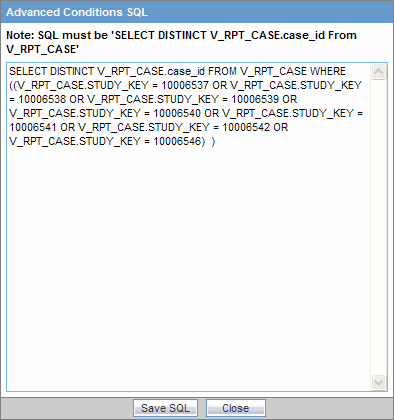
Modify the SQL as per your requirement and click Save SQL. The SQL is saved and the Advanced Conditions SQL dialog appears.
Click Close. The Advanced Conditions Library page appears.
Select the modified Advanced Condition and click Execute. You will get the results as per modified SQL.
|
Note: You can not modify an Advanced Condition once you have added user defined SQL in that, you can modify SQL but can not add new items in Advanced Condition.If you want to add new items, you have to revert the SQL to original by clicking on the Revert to Original button. |
Use the following procedure to delete an Advanced Condition
Select the Advanced Condition from the list in the Advanced Condition Library page.
Click Delete. The delete confirmation dialog box appears.
Click OK. The system deletes the selected Advanced Condition; the Advanced Condition Library page appears.
Argus Insight lets you associate an Advanced Condition to a particular Standard Report and schedule a time when the report needs to be generated and sent to another user through email. This is helpful in situations when you need generate the latest Case Series and run a report on it each time the datamart is refreshed. Instead of manually executing the Advanced Condition to generate the latest Case Series and running the report, you can use the report association functionality of Argus Insight.
|
Note: The user who is scheduling reports should have an enterprise login configured in Cognos to schedule the report. |
Use the following procedure to associate an Advanced Condition with a Standard Report:
On the Advanced Condition Library page, select the Advanced Condition that you wish to associate with a Standard Report.
Associate the Advanced Condition with a Standard Report.
Click Associate. The Scheduled Reports Group dialog box appears. This page displays a list of all groups of reports which were scheduled or associated with the query.

Click New and a context menu will appear. Select Scheduling option.
The Reports Scheduling window will appear.
On this window, you can schedule multiple reports at once.
Schedule the report.
This window has 3 main sections:
Scheduling Information - The Schedule timing and E-Mail information
Available Reports - All the available reports in the system that can be scheduled.
Selected Reports - These reports will be scheduled.

Provide a Name for your reports group along with description.
Use the Frequency list box to specify how often you wish to have the system run the selected QBE and generate the selected report. The options available are: Once, Daily, Weekly, Monthly, Quarterly, and Yearly.
Specify the schedule time in the Time field.
Based on the option you selected in the step above, specify the instant when you want the report generated as described in the table below.
| Frequency Option Selected | Additional Scheduling Information to Specify |
|---|---|
| Once | In the Date text box that appears, enter the date when you want to have the report generated. |
| Daily | In the Time text box that appears, enter the time when you want to have the report generated. The time must be entered in the HH:MM AM/PM format. Hours should be between 1 and 12. |
| Weekly | From the Day of Week option button group that appears, select the day of week on which you want to have the report generated. Also, specify the time in the Time text box. |
| Monthly | Use the Day list box to select the day of the month on which you want to have the report generated. Also, specify the time in the Time text box. |
| Quarterly | Quarterly reports are generated on the first day of the quarter. In the Time text box, enter the time when you want to have the report generated on the first day of the quarter. |
| Yearly | In the Date and Time text boxes, specify the date and time when you want to have the yearly report generated. |
Specify the email recipients of the report you scheduled.
In the Email Address text box, type the email address of the report recipient. If there are multiple recipients, use a semicolon to separate their email addresses.
Type the subject line in the Subject text box.
Type the email body text in the Body text box.
If you want all the reports in a single mail, leave the Send separate mail for each report checkbox unchecked. If you check this checkbox, each report will be delivered in a separate mail to the user.
From the Available reports grid, select a report and click Add button. The report will be selected and will appear in the Selected Reports section.
To remove a report from Selected Reports, click the X button against the report.
For each selected report, you must fill the Pre-filters associated with each report. To do this, click on any report in the Selected Reports grid and the pre-filters will appear beside it. Fill them and click the OK button of Report Pre-Filters section.
Click OK. The system associates the Advanced Condition with the selected report and saves the scheduling information; the Advanced Condition Library page appears. The icon displayed in the Report column indicates that the Value Set is associated with a report.

Refer to the Associated Library and Query Library sections in the Library chapter, to view the steps on how to disassociate reports in those libraries.
Use the following procedure to execute an Advanced Condition:
Select an Advanced Condition from the list in the Advanced Condition Library page.
Click Execute. The system executes the Advanced Condition; the Active Case Series page appears.
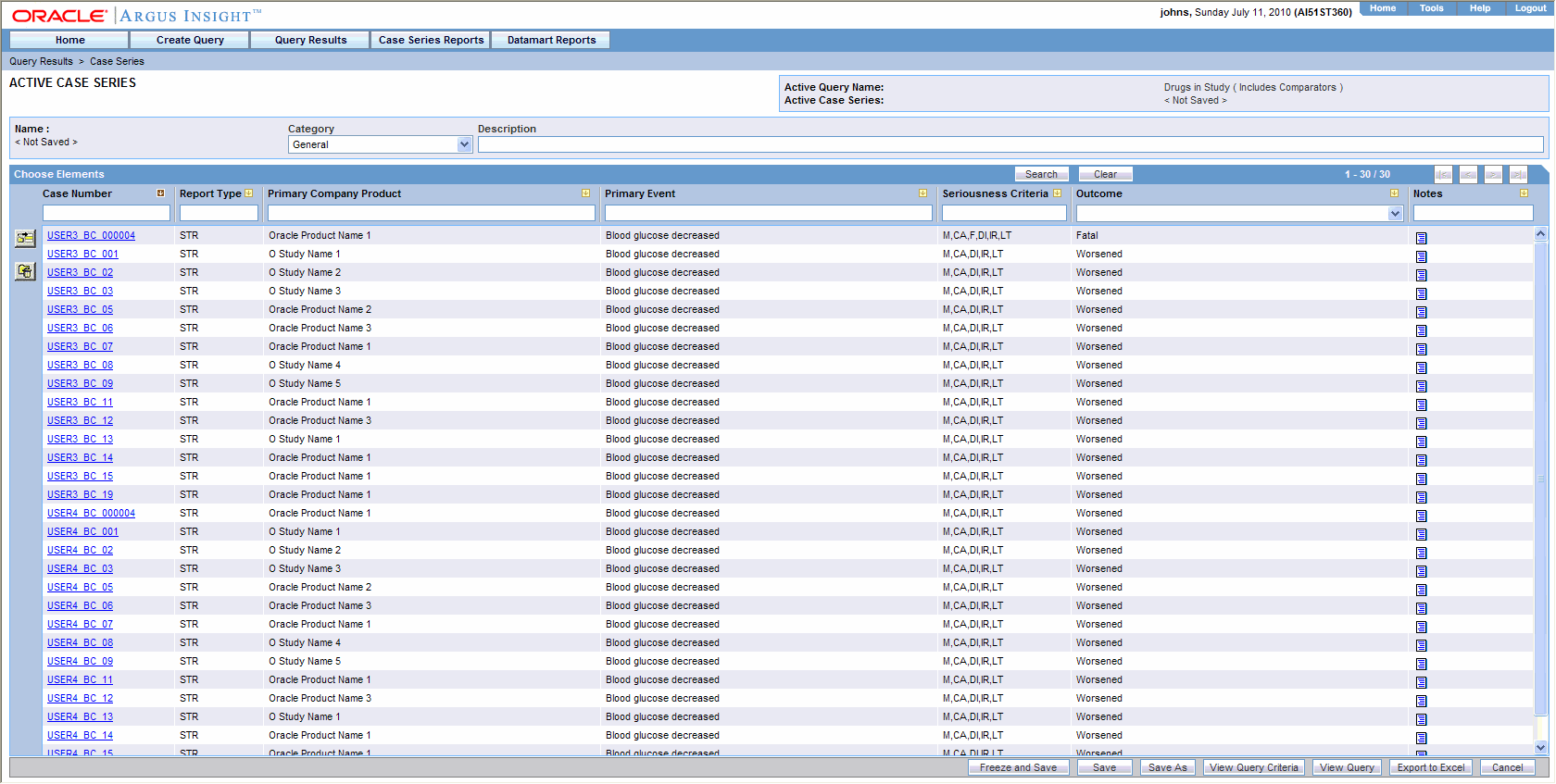
If a report is associated with the saved Advanced Condition, click on Execute button. The Active Case Series page and Pre Filter page of the associated report is displayed.
Enter the prompts value in the Pre Filter page.
Click on the Execute button to generate the report.
After generating the Case Series, you can manually modify it or save it. See the Case Series chapter for more information on working with Case Series.
Just as the system assigns the Active status to an Advanced Condition when you save modifications to it or execute it, the last saved or generated Case Series becomes the Active Case Series.
Use the following procedure to narrow down the list of cases in the Active Case Series, you may want to run an Advanced Condition on an Active Case Series.
Generate the Case Series on which you wish to run another Value Set:
You can generate the Case Series by either using QBE, Filters, or Advanced Conditions. This Case Series automatically becomes the Active Case Series and remains so until you execute another query to generate a different Case Series.
Alternatively, if the Case Series on which you wish to run another Value Set is already saved in the system, select Query Results > Case Series > Case Series Library. In the Case Series Library page that appears, select the Case Series title and click Make Active.
Select Create Query > Advanced Conditions > Library. The Advanced Condition Library page appears.
Select the Advanced Condition you want to run on the Active Case Series you generated in step 1.
Check the Limit Query to Active Case Series checkbox.
Click Execute. The system runs the selected Advanced Condition on the Active Case Series and displays the Active Case Series page. Note that the Case Series you just generated becomes the Active Case Series.
Argus Insight provides a library that serves as a repository for all queries. This library comprises all the query searches performed for QBE, Filters, and Advanced Conditions. In addition, the Associated Library feature enables you to search for those queries, which have a report associated with them.
Go to Create Query>Library to view the components of the Library menu.

This chapter discusses the following components that comprise the Library menu in Argus Insight:
Associated Reports Library
Query Library
|
Note: To use LDAP configuration in Argus Insight, your Cognos administrator must configure LDAP on the Cognos Server. |
The Associated Library feature enables you to view all the reports associated with a query.
Open Create Query>Library>Associated Reports Library to view a list of all the reports that are associated with a query.
The following screen is displayed:
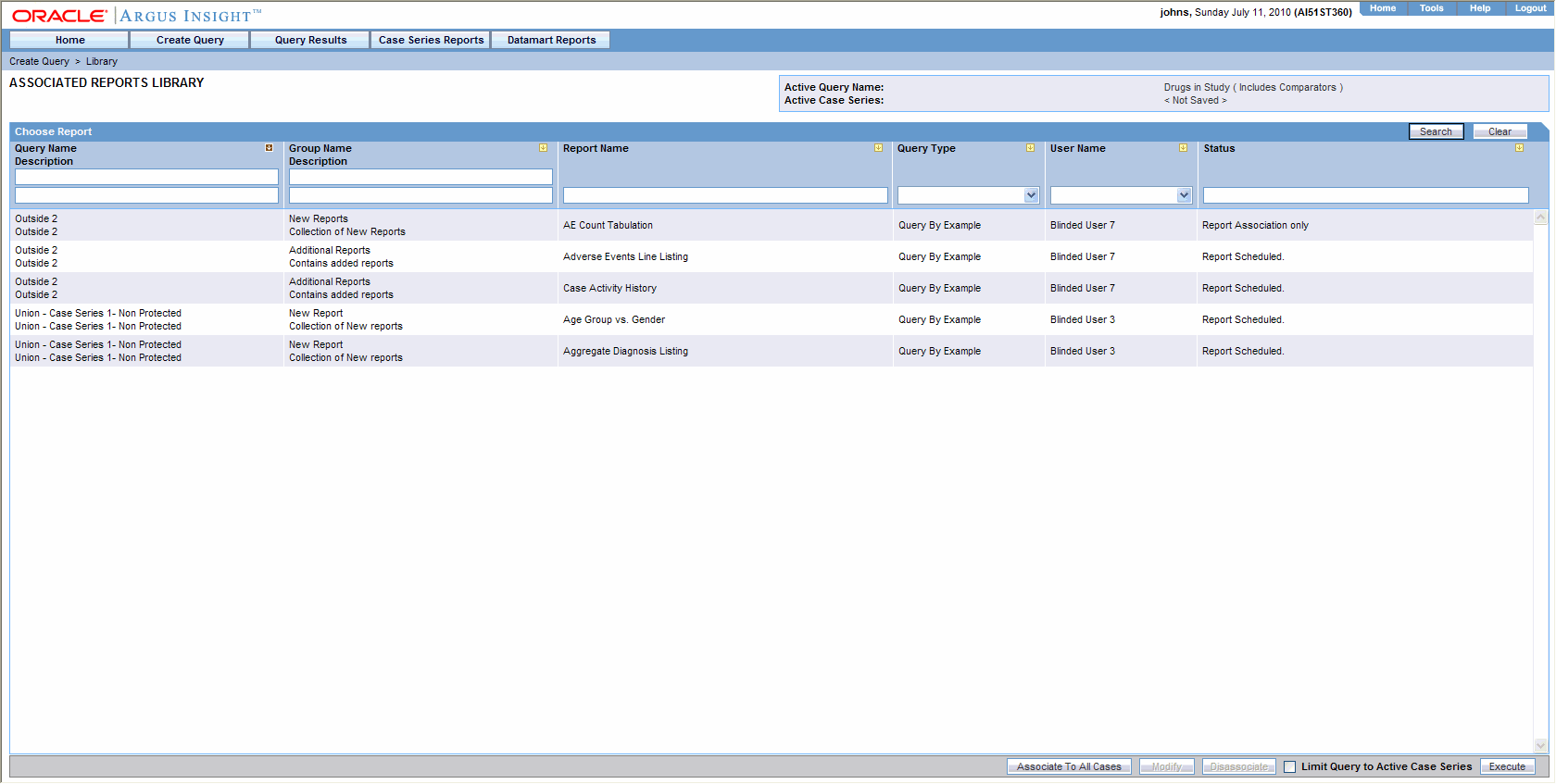
The following table describes the columns in this page:
| Column | Description |
| Name | Displays the name of the query that is associated with the report. |
| Description | Displays the description of the query associated with the report. |
| Last Modified | Displays the date when the query was last modified. |
| Query Type | Displays the type of query associated with the report. |
| User Full Name | Displays the name of the author of the query. |
| Category | Displays the category where the query is saved. |
| Report Name | Displays the name of the report associated with the query. |
| Limit Query to Active Case Series | Enables you to limit the query to the active case series. |
Use the following procedure to modify a query in the associated library:
Select the query from the list in the Associated Reports Library page.
Click Modify.
This displays the Scheduled Reports Group page. 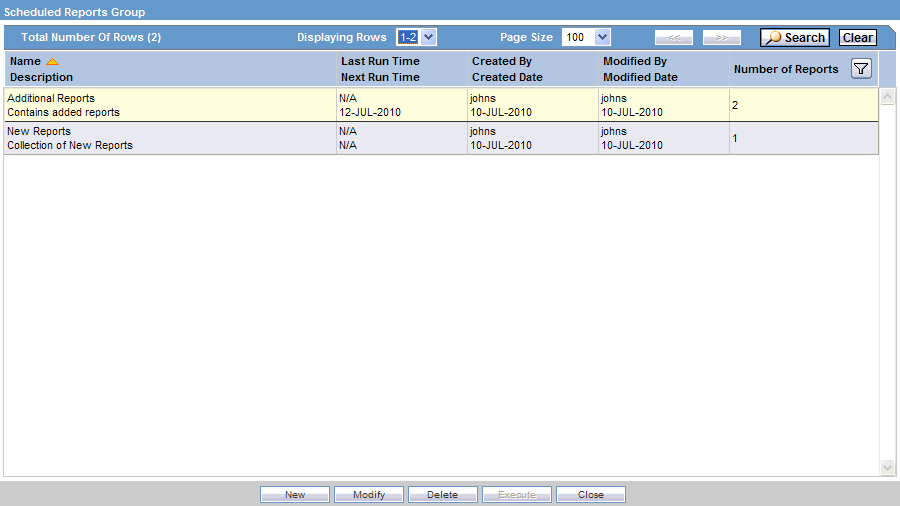
Select any report group and click Modify button.
Make the necessary modifications and click OK.
Click Execute to execute a report. The Execute button is available only if a group has just one report in it.
The Query Library feature enables you to view all the queries. Select Create Query>Library>Query Library to view a list of all the queries.
The following screen is displayed:
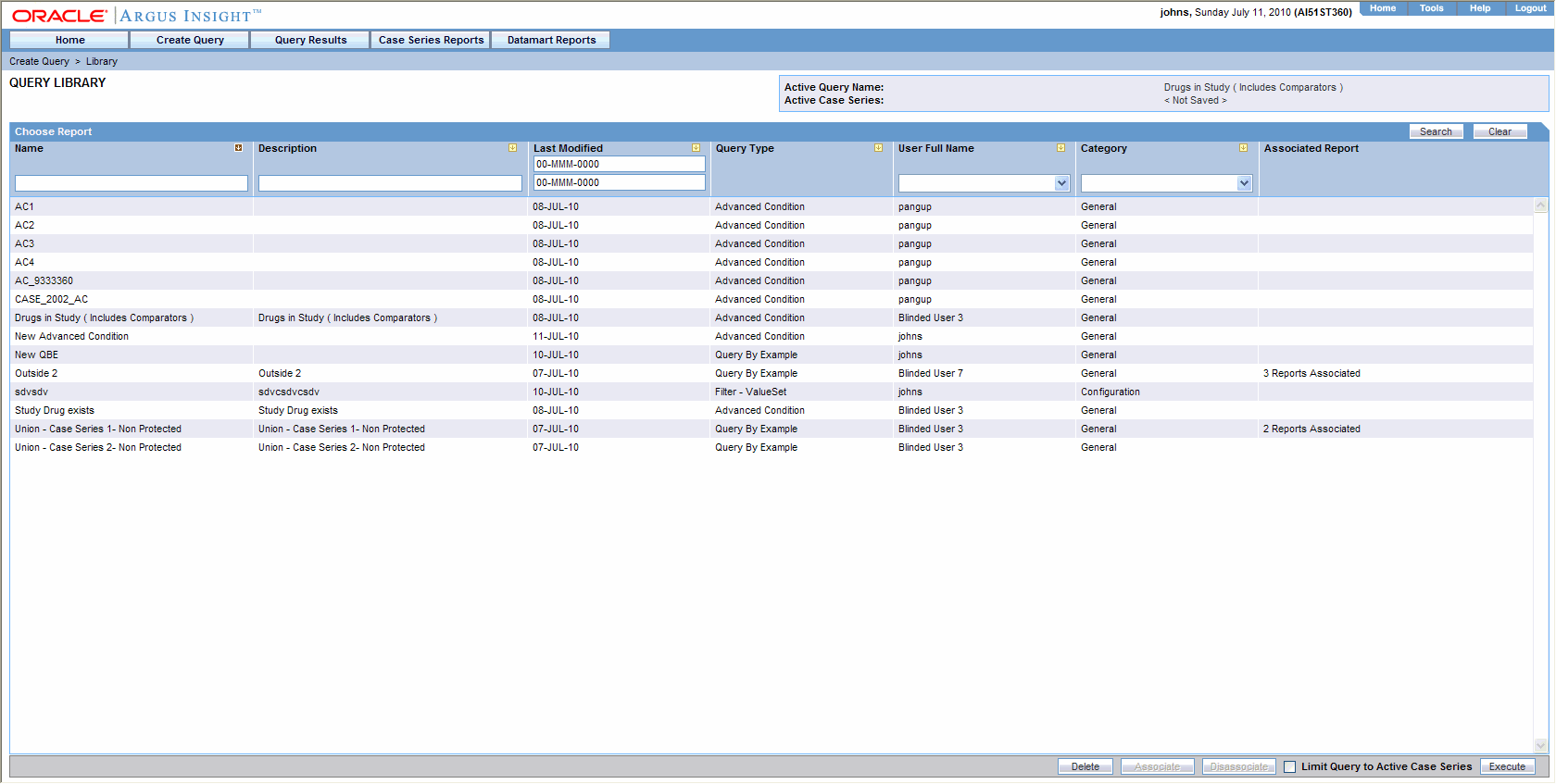
The following table lists the descriptions of the columns in this page:
| Column | Description |
| Name | Displays the name of the query. |
| Description | Displays the description of the query. |
| Last Modified | Displays the date when the query was last modified. |
| Query Type | Displays the type of query. |
| User Full Name | Displays the name of the author of the query. |
| Category | Displays the category where the query is saved. |
| Report Name | Displays the name of the report associated with the query. |
| Limit Query to Active Case Series | Enables you to limit the query to the active case series. |
Use the following procedure to modify a query in the query library:
Select the query from the list in the Query Library page.
Click Associate.
This displays the Scheduled Reports Group page. 
Select any report group and click Modify.
Make the necessary modifications and click OK.
Click Execute to execute a report. The Execute button will be available only if a group has just 1 report in it.